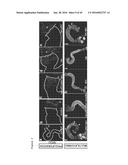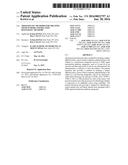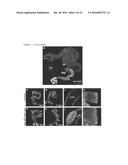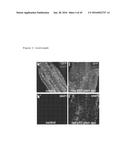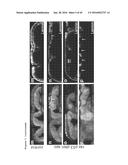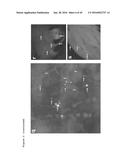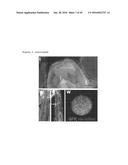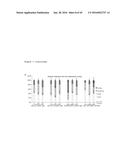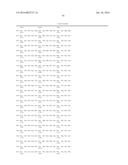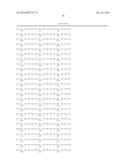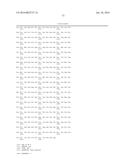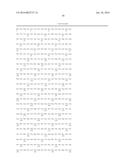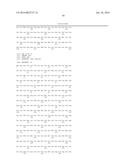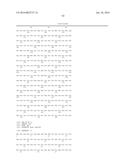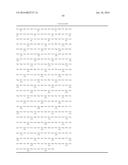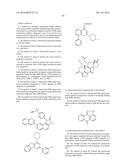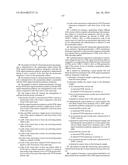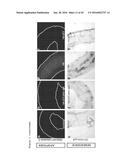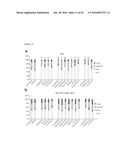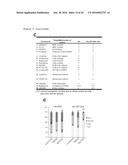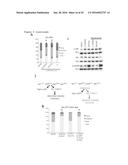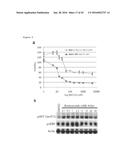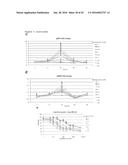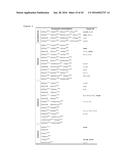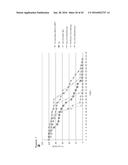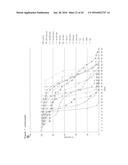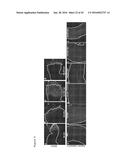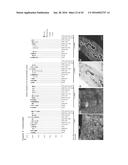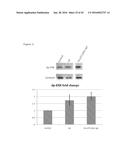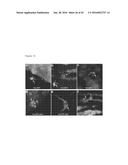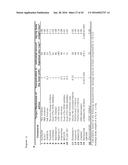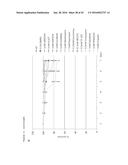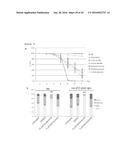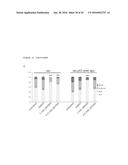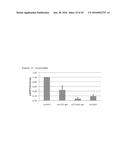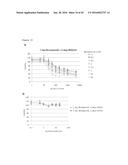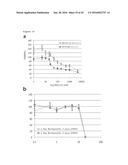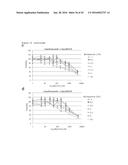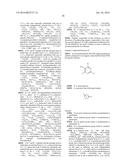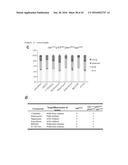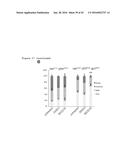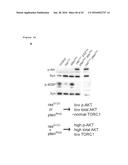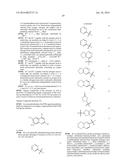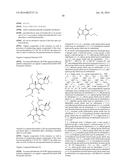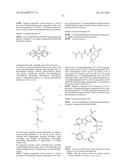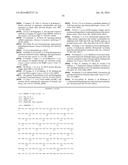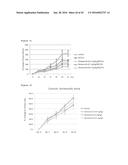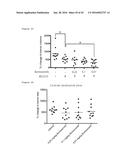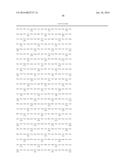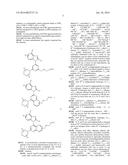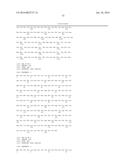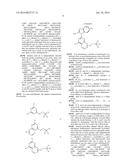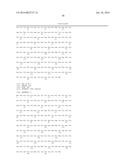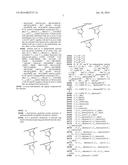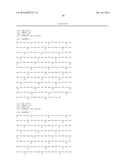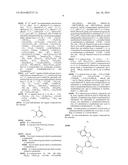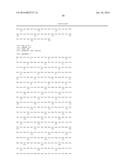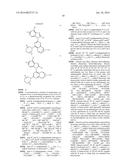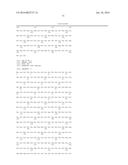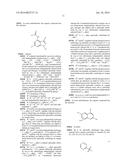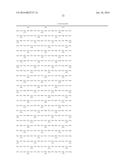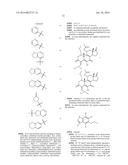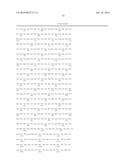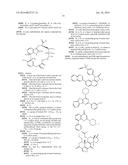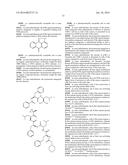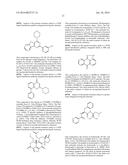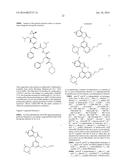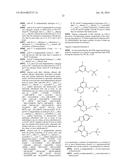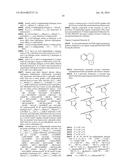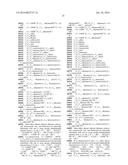Patent application title: THERAPEUTIC METHODS FOR TREATING SOLID TUMORS AND RELATED DIAGNOSTIC METHODS
Inventors:
Erdem Bangi (New York, NY, US)
Ross Cagan (New York, NY, US)
Assignees:
Icahn School of Medicine at Mount Sinai
IPC8 Class: AA61K3805FI
USPC Class:
424 941
Class name: Drug, bio-affecting and body treating compositions enzyme or coenzyme containing
Publication date: 2016-01-28
Patent application number: 20160022757
Abstract:
The present invention provides a method for treating a subject afflicted
with a cancer which comprises administering to the subject (i) a
proteasome antagonist and (ii) a PI3K signal transduction pathway
antagonist, each of (i) and (ii) in an amount such that when both (i) and
(ii) are administered, the administration is effective to treat the
subject. The present invention also provides a method for treating a
subject afflicted with a cancer which comprises administering to the
subject (i) a proteasome antagonist, and (ii) an oligonucleotide which
decreases the amount of PI3K, mTor, TORC1, TORC2, AKT, or JNK produced by
cells of the cancer. The present invention provides processes for
identifying whether a compound is an epithelial cancer drug candidate.
The present invention also provides a method for identifying a cancer
patient who will likely benefit from treatment with a PI3K signal
transduction pathway antagonist.Claims:
1. A method for treating a mammalian subject afflicted with a cancer
which comprises administering to the mammalian subject (i) a proteasome
antagonist and (ii) a PI3K signal transduction pathway antagonist, each
of (i) and (ii) in an amount such that when both (i) and (ii) are
administered, the administration is effective to treat the mammalian
subject.
2. The method of claim 1, wherein the mammalian subject is a human subject.
3. The method of claim 2, wherein the cancer is in the form of a solid tumor.
4. The method of claim 3, wherein the cancer is colon cancer.
5. The method of claim 4, wherein the colon cancer is resistant to treatment.
6. The method of claim 5, wherein the colon cancer is resistant to treatment with a PI3K signal transduction pathway antagonist.
7. The method of claim 3, wherein the PI3K signal transduction pathway antagonist is an organic compound having a molecular weight less than 1000 Daltons, a DNA aptamer, an RNA aptamer, or a polypeptide, which antagonist binds to PI3K, mTor, TORC1, TORC2, AKT, or JNK.
8. The method of claim 7, wherein the PI3K signal transduction pathway antagonist is a DNA aptamer, an RNA aptamer, or a polypeptide.
9. The method of claim 7, wherein the PI3K signal transduction pathway antagonist is an organic compound having a molecular weight less than 1000 Daltons.
10. The method of claim 9, wherein the PI3K signal transduction pathway antagonist binds to PI3K and has the structure: ##STR00043## or a pharmaceutically acceptable salt or ester thereof.
11. The method of claim 7, wherein the PI3K signal transduction pathway antagonist is capable of separately binding both PI3K and mTor.
12. The method of claim 9, wherein the PI3K signal transduction pathway antagonist binds to JNK and has the structure: ##STR00044## or a pharmaceutically acceptable salt or ester thereof.
13. The method of claim 3, wherein the proteasome antagonist is an organic compound having a molecular weight less than 1000 Daltons, a DNA aptamer, an RNA aptamer, or a polypeptide, which antagonist inhibits proteasome function.
14. The method of claim 13, wherein the proteasome antagonist is a DNA aptamer, an RNA aptamer, or a polypeptide.
15. The method of claim 13, wherein the proteasome antagonist is an organic compound having a molecular weight less than 1000 Daltons.
16. The method of claim 15, wherein the proteasome antagonist has the structure: ##STR00045## or a pharmaceutically acceptable salt or ester thereof.
17. The method of claim 3, wherein the proteasome antagonist and the PI3K signal transduction pathway antagonist are each an organic compound having a molecular weight less than 1000 Daltons.
18. The method of claim 17, wherein the proteasome antagonist has the structure: ##STR00046## and the PI3K signal transduction pathway antagonist has the structure: ##STR00047##
19. The method of claim 3, wherein the proteasome antagonist is administered to the mammalian subject before the PI3K signal transduction pathway antagonist, such that the PI3K signal transduction pathway antagonist is administered during at least a portion of the time that the proteasome antagonist is active in the mammalian subject.
20. The method of claim 3, wherein the proteasome antagonist is administered to the mammalian subject concurrently with the PI3K signal transduction pathway antagonist.
21. The method of claim 3, wherein the Receptor Tyrosine Kinase (RTK)/Ras signal transduction pathway and the PI3K signal transduction pathway are misregulated in cells of the cancer compared to cells from tissue of the same type.
22. The method claim 21, wherein the misregulation is selected from the group consisting of: i) the amount of pAKT is increased and TORC1 activity is decreased in cells of the cancer compared to cells from tissue of the same type; ii) the Ras signal transduction pathway and the PI3K signal transduction pathway each have a higher level of activation in cells of the cancer compared to cells from tissue of the same type; iii) Ras and PI3K each have a higher level of activation in cells of the cancer compared to cells from tissue of the same type; iv) cells of the cancer have at least one activating mutant allele in Ras; v) cells of the cancer have at least one activating mutant allele in K-Ras; vi) cells of the cancer have at least one activating mutant allele in N-Ras; vii) cells of the cancer have at least one activating mutant allele in H-Ras; viii) cells of the cancer have at least one activating mutant allele in a subunit of PI3K; ix) cells of the cancer have reduced PTEN function compared to cells from tissue of the same type; x) cells of the cancer have at least one mutant allele in PTEN that is a deletion mutation, and/or is a mutation that results in the reduced or loss of PTEN protein function in cells of the cancer that express the PTEN mutant protein; and xi) cells of the cancer have a reduced level of PTEN protein expression compared to cells from tissue of the same type.
23. A method for treating a mammalian subject afflicted with a cancer which comprises administering to the mammalian subject (i) a proteasome antagonist, and (ii) an oligonucleotide which decreases the amount of PI3K, mTor, TORC1, TORC2, AKT, or JNK produced by cells of the cancer, each of (i) and (ii) in an amount that when both (i) and (ii) are administered, the administration is effective to treat the mammalian subject.
24. The method of claim 23, wherein the oligonucleotide is an an antisense oligodeoxynucleotide, a RNA interference inducing compound or a ribozyme that comprises nucleotides in a sequence that is complementary to PI3K, mTor, AKT, or JNK-encoding mRNA.
25. A pharmaceutical composition comprising (i) a proteasome antagonist and (ii) a PI3K signal transduction pathway antagonist or an oligonucleotide which decreases the amount of PI3K, mTor, TORC1, TORC2, AKT, or JNK produced by cells of the cancer, for use in treating a mammalian subject afflicted with a cancer.
26. A method for identifying a cancer patient who will likely benefit from treatment with a PI3K signal transduction pathway antagonist comprising i) obtaining a biological sample comprising cancer tissue from the cancer patient; ii) detecting whether the cancer tissue in the biological sample a) has increased Ras activity and α) increased PI3K activity, or β) reduced PTEN expression or activity, or b) has an increased amount of pAkt and a reduced level of TORC1 activity, compared to normal tissue of the same type; and iii) identifying the cancer patient as a cancer patient who will likely benefit from treatment with a PI3K signal transduction pathway antagonist if in step (ii) neither a) increased Ras activity and α) increased PI3K activity, or β) reduced PTEN expression or activity, nor b) an increased amount of pAkt and a reduced level of TORC1 activity, is detected in cancer tissue in the biological sample, and identifying the cancer patient as a cancer patient who will not likely benefit from treatment with a PI3K signal transduction pathway antagonist if in step (ii) either a) increased Ras activity and α) increased PI3K activity, or β) reduced PTEN expression or activity, or b) an increased amount of pAkt and a reduced level of TORC1 activity, is detected in cancer tissue in the biological sample.
27. The method of claim 26, wherein the cancer patient is selected from the group of cancer patients having colon cancer.
28. A method of treating a cancer patient identified to not likely benefit from treatment with a PI3K signal transduction pathway antagonist in claim 26 comprising administering to the cancer patient (i) a proteasome antagonist and (ii) a PI3K signal transduction pathway antagonist, each of (i) and (ii) in an amount such that when both (i) and (ii) are administered, the administration is effective to treat the cancer patient.
Description:
[0001] This application claims priority of U.S. Provisional Patent
Application No. 61/799,595, filed Mar. 15, 2013 and U.S. Provisional
Patent Application No. 61/895,265, filed Oct. 24, 2013, the entire
contents of each of which are hereby incorporated herein by reference.
[0002] This application incorporates-by-reference nucleotide and/or amino acid sequences which are present in the file named "140314--0028--84569.A PCT_SequenceListing_REB.txt", which is 64.5 kilobytes in size, and which was created Mar. 14, 2014 in the IBM-PC machine format, having an operating system compatibility with MS-Windows, which is contained in the text file filed Mar. 14, 2014 as part of this application.
[0003] Throughout this application, various publications are referenced by Arabic numerals. Pull citations for these publications may be found at the end of the specification immediately preceding the claims. The disclosures of these publications in their entireties are hereby incorporated by reference into this application in order to more fully describe the state of the art to which this invention pertains.
BACKGROUND OF THE INVENTION
[0005] The success rate of cancer clinical trials remains among the lowest of the major diseases (1). One difficulty is that cancer is a multigenic and highly heterogeneous disease: individual tumors typically carry mutations in dozens of genes. Recent genome-wide mutation profiling of human tumors has provided important insights into this genetic complexity and diversity (2). The results have highlighted the difficulties of developing effective therapeutics through models that focus on a single target, and likely explain the low success rate of drugs that have entered clinical trials based on current animal models: approval rates in colon cancer are approximately 3% (3). The discrepancy between preclinical data and clinical trials has been partially attributed to the inadequacy of currently available preclinical animal models (1,4). Use of more complex preclinical models that reflect the multigenic and heterogeneous nature of human tumors will be crucial to bridge this gap. A central challenge, then, is to develop models that reflect tumors' genetic complexities while preserving the detailed interactions between tumor and host. There is a need for such models.
[0006] Additionally, there is a need for new treatments and diagnostic methods for cancer.
SUMMARY OF THE INVENTION
[0007] The present invention provides a method for treating a subject afflicted with a cancer which comprises administering to the subject (i) a proteasome antagonist and (ii) a PI3K signal transduction pathway antagonist, each of (i) and (ii) in an amount such that when both (i) and (ii) are administered, the administration is effective to treat the subject.
[0008] The present invention provides a method for treating a subject afflicted with a cancer which comprises administering to the subject (i) a proteasome antagonist, and (ii) an oligonucleotide which decreases the amount of PI3K, mTor, TORC1, TORC2, ART, or JNK produced by cells of the cancer, each of (i) and (ii) in an amount that when both (i) and (ii) are administered, the administration is effective to treat the subject.
[0009] The present invention provides a pharmaceutical composition comprising (i) a proteasome antagonist and (ii) a PI3K signal transduction pathway antagonist or an oligonucleotide which decreases the amount of PI3K, mTor, TORC1, TORC2, Akt, or JNK produced by cells of the cancer, for use in treating a subject afflicted with a cancer.
[0010] The present invention provides a composition for treating a subject afflicted with a cancer comprising (i) a proteasome antagonist and (ii) a PI3K signal transduction pathway antagonist or an oligonucleotide which decreases the amount of PI31, mTor, TORC1, TORC2, AKT, or JNK produced by cells of the cancer.
[0011] The present invention provides a process for identifying whether a compound is an epithelial cancer drug candidate comprising
[0012] i) obtaining a D. melanogaster which is genetically modified to have
[0013] a) increased Ras activity,
[0014] b) increased PI3K activity, and/or
[0015] c) a reduced level of p53, PTEN, or APC expression or activity,
[0016] in the colon epithelium thereof, such that there is a cancer phenotype in the colon epithelium of the D. melanogaster;
[0017] ii) contacting the D. melanogaster with the compound;
[0018] iii) determining whether there is a difference between the cancer phenotype of the D. melanogaster of ii) and the cancer phenotype of a corresponding D. melanogaster not contacted with the compound; and
[0019] vi) identifying the compound as an epithelial cancer drug candidate if there is a difference between the cancer phenotype of the D. melanogaster contacted with the compound and the cancer phenotype of the corresponding D. melanogaster not contacted with the compound.
[0020] The present invention provides a process for identifying whether a combination of a first compound and a second compound is likely to be useful for the treatment of an epithelial cancer comprising
[0021] i) obtaining a D. melanogaster which is genetically modified to have
[0022] a) increased Ras activity.
[0023] b) increased PI3K activity, and/or
[0024] c) a reduced level of p53, PTEN, or APC expression or activity,
[0025] in the colon epithelium thereof, such that there is a cancer phenotype in the colon epithelium of the D. melanogaster;
[0026] ii) contacting the D. melanogaster with each of the first compound and the second compound;
[0027] iii) determining whether there is a difference between the cancer phenotype of the D. melanogaster of ii) and the cancer phenotype of a corresponding D. melanogaster not contacted with the first compound and the second compound; and
[0028] vi) identifying the combination of the first compound and the second compound as likely to be useful for the treatment of epithelial cancer if there is a difference between the cancer phenotype of the at least one D. melanogaster contacted with the first compound and the second compound and the cancer phenotype of the corresponding D. melanogaaster not contacted with the first compound and the second compound.
[0029] The present invention provides a process of producing a cancer drug comprising steps i) to iv), followed by
[0030] v) producing the compound identified in step iv), thereby producing the cancer drug.
[0031] The present invention provides a process for identifying whether a compound is an epithelial cancer drug candidate comprising
[0032] i) obtaining an epithelial cell which has
[0033] a) increased Ras activity.
[0034] b) increased PI3K activity, and/or
[0035] c) a reduced level of p53. PTEN, or APC expression or activity,
[0036] such that the epithelial cell has a cancer phenotype;
[0037] ii) contacting the epithelial cell with the compound;
[0038] iii) determining whether there is a difference between the cancer phenotype of the epithelial cell of ii) and the cancer phenotype of a corresponding epithelial cell not contacted with the compound; and
[0039] vi) identifying the compound as an epithelial cancer drug candidate if there is a difference between the cancer phenotype of the epithelial cell contacted with the compound and the cancer phenotype of the corresponding epithelial cell not contacted with the compound.
[0040] The present invention provides a process for identifying whether a combination of a first compound and a second compound is likely to be useful for the treatment of an epithelial cancer comprising
[0041] i) obtaining an epithelial cell which has
[0042] a) increased Ras activity,
[0043] b) increased PI3K activity, and/or
[0044] c) a reduced level of p53, PTEN, or APC expression or activity.
[0045] such that the epithelial cell has a cancer phenotype;
[0046] ii) contacting the epithelial cell with each of the first compound and the second compound;
[0047] iii) determining whether there is a difference between the cancer phenotype of the epithelial cell of ii) and the cancer phenotype of a corresponding epithelial cell not contacted with the first compound and the second compound; and
[0048] vi) identifying the combination of the first compound and the second compound as likely to be useful for the treatment of epithelial cancer if there is a difference between the cancer phenotype of the at least one epithelial cell contacted with the first compound and the second compound and the cancer phenotype of the corresponding epithelial cell not contacted with the first compound and the second compound.
[0049] The present invention provides a process of producing a cancer drug comprising steps i) to iv), followed by
[0050] v) producing the compound identified in step iv), thereby producing the cancer drug.
[0051] The present invention provides a method for identifying a cancer patient who will likely benefit from treatment with a PI3K signal transduction pathway antagonist comprising
[0052] i) obtaining a biological sample comprising cancer tissue from the cancer patient;
[0053] ii) detecting whether the cancer tissue in the biological sample
[0054] a) has increased Ras activity and
[0055] α) increased PI3K activity, or
[0056] β) reduced PTEN expression or activity, or
[0057] b) has an increased amount of pAkt and a reduced level of TORC1 activity,
[0058] compared to normal tissue of the same type; and
[0059] iii) identifying the cancer patient as a cancer patient who will likely benefit from treatment with a PI3K signal tranaduction pathway antagonist if in step (ii) neither
[0060] a) increased Ras activity and
[0061] α) increased PI3K activity, or
[0062] ρ) reduced PTEN expression or activity, nor
[0063] b) an increased amount of pAkt and a reduced level of TORC1 activity,
[0064] is detected in cancer tissue in the biological sample, and identifying the cancer patient as a cancer patient who will not likely benefit from treatment with a PI3K signal transduction pathway antagonist if in step (ii) either
[0065] a) increased Ras activity and
[0066] α) increased PI3K activity, or
[0067] β) reduced PTEN expression or activity, or
[0068] b) an increased amount of pAkt and a reduced level of TORC1 activity,
[0069] is detected in cancer tissue in the biological sample.
[0070] The present invention provides a method of treating a cancer patient identified to not likely benefit from treatment with a PI3K signal transduction pathway antagonist comprising the method of the invention.
[0071] The present invention provides a kit for identifying a cancer patient who will likely benefit from treatment with a PI3K signal transduction pathway antagonist comprising
[0072] i) at least one probe or primer for determining
[0073] a) whether PTEN expression is reduced; or
[0074] b) whether there is a mutation in PTEN reduces the activity thereof,
[0075] in a biological sample, or from nucleic acid obtained from a biological sample, and/or
[0076] ii) at least one probe or primer for determining whether there is a mutation in Ras that increases the activity thereof,
[0077] in a biological sample, or from nucleic acid obtained from the biological sample, and/or
[0078] iii) at least one probe or primer for determining whether there is a mutation in PI3K that increases the activity thereof.
[0079] in a biological sample, or from nucleic acid obtained from the biological sample, and/or
[0080] iv) at least one antibody for determining the amount of p-4EBP in a biological sample, or in protein obtained from the biological sample, and/or
[0081] v) at least one antibody for determining the amount of pAKT in a biological sample, or in protein obtained from the biological sample.
BRIEF DESCRIPTION OF THE FIGURES
[0082] FIG. 1. Targeting multigenic colorectal cancer combinations to the adult Drosophila hindgut. a, Most frequently deregulated pathways in colon tumors and the transgenes that represent them. b, Mutation status of individual tumors with respect to the five deregulated pathways. Blue boxes indicate mutation in a pathway component. c, Quadruple mutation combinations in individual human tumors and corresponding combinations generated in Drosophila. d, The adult Drosophila digestive track. Hindgut cells are marked with byn>GFP; nuclei are in red. e-l, control (byn>GFP,dcr2) and ras.sup.G12v p53.sup.RNAi pten.sup.RNAi apc.sup.RNAi hindguts 7 and 21 days after induction as labeled. Asterisks (f,h) indicate regions of multilayering. Longitudinal optical sections (i,j) and pylorus regions (k,l) are shown. Abbreviations: crop (cr), midgut (m), malphigian tubules (mp), hindgut (h), rectum (r), pylorus (p), and ileum (i).
[0083] FIG. 2. Migration phenotypes induced by quadruple combinations. a-f, control (a) and ras.sup.G12V p53R.sup.NAi pten.sup.RNAi apc.sup.RNAi (b-f) ilea; arrows indicate migrating cells. c, Close-up view of b. d-f, Apical-to-basal confocal sections of a migrating cell (asterisk) g,h, Surface views of ras.sup.G12V p53.sup.RNAi smad4.sup.RNAi apc.sup.RNAi hindguts with cells migrating on top of muscle layer. i-j, phospho-Src staining of control and ras.sup.G12V p53.sup.RNAi pten.sup.RNAi apc.sup.RNAi hindguts. k,l MMP1 staining of control and ras.sup.G12V p53.sup.RNAi pten.sup.RNAi apc.sup.RNAi hindguts. k',l', MMP1 channel only. m-p, Cross sections of control and ras.sup.G12V p53.sup.RNAi pten.sup.RNAi apc.sup.RNAi hindguts. m'-p', Laminin channel only; arrows indicate reduced/absent Laminin staining. q-w, Dissemination phenotype of quadruple combinations. Arrows indicate GFP-positive foci inside the abdominal cavity (q), below the abdomen epidermis (r), ovaries (s), head (t) and legs (u,v) (t: trachea, n: nephrocyte, f: fat body). w, live confocal image of a multicellular GFP foci inside the abdominal cavity. Nuclei are visualized by a nuclear dsRed transgene (nls-dsRed). x, Quantification of dissemination into the abdominal cavity. none: no dissemination; weak: 1-3 GFP-positive foci inside the abdominal cavity; moderate: 4-10 GFP-positive foci; strong: >10 GFP-positive foci (n=20-30 flies/replicate; error bars reflect standard error of the mean).
[0084] FIG. 3. Follow-up analysis of proliferation, multilayering and distant migration phenotypes. a-e, Seven day continuous BRDU labeling (red) of hindguts with the indicated genotypes. Whole hindgut (a) or pylorus regions (b-e) are outlined with solid lines; dashed lines indicate hindgut/midgut boundary (m: midgut). f-J, Whole hindguts of indicated genotypes; asterisks indicate regions of multilayering. k, Quantification of dissemination one week after induction (n=25-30 flies/replicate; error bars: standard error of the mean; *: p<0.01). l,m, top views of ras.sup.G12V (1) and ras.sup.G12V p53.sup.RNAi pten.sup.RNAi apc.sup.RNAi (m) hindguts with migrating cells on top. Cleaved caspase-3 (n-r) and SA-β-gal (s-v) staining of hindguts with indicated genotypes. Hindguts outlined by solid lines in n-r. w, Features of cancer recapitulated by our multigenic models. x, Summary of interactions between individual transgenes for each phenotype.
[0085] FIG. 4. Combinatorial therapy as an effective means to overcome resistance to single agent therapy observed in multigenic models. a,b, Quantification of dissemination in ras.sup.G12V (a) and ras.sup.G12V p53.sup.RNAi pten.sup.RNAi apc.sup.RNAi (b) animals treated with indicated compounds. c, Summary of compound effects against ras.sup.G12V and ras.sup.G12V p53.sup.RNAi pten.sup.RNAi apC.sup.RNAi. d, Quantification of dissemination in ras.sup.G12V pten.sup.RNAi and ras.sup.G12V p53.sup.RNAi apc.sup.RNAi animals treated with BEZ235 e, Western blot analysis of hindguts with indicated genotypes seven days after the induction of transgenes. Syn (Syntaxin): loading control. f, Time course analysis of PI3K pathway activation status in control, ras.sup.G12V, pten.sup.RNAi and ras.sup.G12V p53.sup.RNAi pten.sup.RNAi apc.sup.RNAi hindguts. Each data point represents the average of 2-5 western blots. Error bars represent standard error of the mean. a. g,h, Quantification of dissemination in ras.sup.G12V p53.sup.RNAi pten.sup.RNAi apc.sup.RNAi (g) and ras.sup.G12V pten.sup.RNAi (h) animals treated with indicated compounds. i, Western blot analysis of ras.sup.G12V p53.sup.RNAi pten.sup.RNAi apc.sup.RNAi hindguts seven days after treatment with indicated compounds. j, Schematic illustration of the mechanism of resistance to BEZ235 and LY294002 and the mechanism by which combinatorial therapy overcomes resistance. k, Quantification of dissemination in ras.sup.G12V p53.sup.RNAi pten.sup.RNAi apc.sup.RNAi animals after sequential treatment with bortezomib and BEZ235 as indicated. (a,b,d,g,h,k: n=30 flies/replicate; error bars: standard error of the mean *: p<0.01; **: p<0.05).
[0086] FIG. 5. Validation of BEZ resistance and effectiveness of combinatorial therapy in human colorectal cancer line DLD-1. a, BEZ235 dose response curve of DLD-1 parental (Ras and PI3K active) versus DLD-1 WT (Ras active, PI3K wildtype) cell lines. b, PI3K pathway activation status of DLD-1 cells after 4 hour treatment with the indicated doses of bortezomib. c,d, Time course of PI3K pathway activation by indicated doses of bortezomib in DLD-1 cells after 1, 4, 12, 18 and 24 hours of treatment. Each data point represents the average of 2-3 western blots. Error bars represent standard error of the mean. e, BEZ235 dose response curve of DLD-1 cells after pretreatment with DMSO (control) or indicated doses of bortezomib for 24 hours.
[0087] FIG. 6. Multigenic combinations generated in Drosophila and corresponding human tumors. Tumor IDs shown in bold are exact matches to their corresponding combinations with respect to mutated genes. Others match to their corresponding tumors with respect to the deregulated pathways but not the mutated genes.
[0088] FIG. 7. Survival curves of multigenic combinations after induction of transgenes. Survival curves of quadruple phenotypes (a), and of subcombinations that make up the 4 hit combination ras.sup.G12V p53.sup.RNAi pten.sup.RNAi apc.sup.RNAi (b).
[0089] FIG. 8. Follow-up analysis of cancer phenotypes observed in ras.sup.G12V p53.sup.RNAi pten.sup.RNAi apc.sup.RNAi. a-d, 7 day continuous BRDU labeling (red) of hindguts with the indicated genotypes. Pylorus region of the hindguts are outlined with solid lines; dashed lines indicate hindgut/midgut boundary (m: midgut). e-j, Cleaved caspase-3 staining of hindguts (outlined by solid lines) with indicated genotypes. Hindgut cells occasionally displayed high levels of membrane-associated cleaved caspase (e.g. f), though its functional significance is unclear. k, Quantification of distant migration in animals with indicated genotypes 1, 2, 3 and 4 weeks after induction (n=25-30 flies/replicate; error bars: standard error of the mean). l,m, Examples of GFP negative cells from hindguts carrying ras.sup.G12V (l) and ras.sup.G12V pten.sup.RNAi (m). n, SA-β-gal positive enterocytes in hindguts carrying ras.sup.G12V were also GFP negative (n'). o-s, SA-β-gal staining of hindguts with indicated genotypes.
[0090] FIG. 9. MAPK pathway activation status in ras.sup.G12V and ras.sup.G12V p53.sup.RNAi pten.sup.RNAi apc.sup.RNAi hindguts. Western blot analysis of MAPK activity as measured by dual ERK phosphorylation (dpERK) in in ras.sup.G12V and ras.sup.G12V p53.sup.RNAi pten.sup.RNAi apc.sup.RNAi hindguts 7 days after the induction of transgenes.
[0091] FIG. 10. Comparison of migrating cell sizes in subcombinations of ras.sup.G12V and ras.sup.G12V p53.sup.RNAi pten.sup.RNAi apc.sup.RNAi. Examples of cells migrating on top of hindguts with indicated genotypes.
[0092] FIG. 11. Targets, feeding doses and toxicity of compounds. a, List of compounds used for feeding experiments along with their targets, mechanisms of actions and concentrations used in the food. Estimated amount ingested was calculated based on our observations that adult females ingest approximately 0.2 μl of food per day (not shown). Estimated amount of ingested compound was also converted into mg/kg body weight/day using 1.1 mg as the average weight of an adult female. b, Survival curves of ras.sup.G12V p53.sup.RNAi pten.sup.RNAi apc.sup.RNAi animals fed the indicated compounds. At the doses used in our experiments, compounds did not have significant toxicity.
[0093] FIG. 12. Toxicity and efficacy of LBH589 and Bortezomib. a, Survival curves of ras.sup.G12V p53.sup.RNAi pten.sup.RNAi apc.sup.RNAi animals fed LBH589 or Bortezomib at indicated doses, b,c, Quantification of distant migration phenotype of animals with indicated genotypes after feeding different doses of bortezomib (b) and LBH589 (c). n=30 flies/replicate; error bars: standard error of the mean *: p<0.01; **: p<0.05
[0094] FIG. 13. PI3K pathway activity in subcombinations of ras.sup.G12V p53.sup.RNAi pten.sup.RNAi apc.sup.RNAi. Western blot analysis of PI3K pathway activity in hindguts from indicated genotypes as measured by AKT and 4EBP phosphorylation seven days after the induction of transgenes.
[0095] FIG. 14. Combinatorial treatment of remaining compounds with Bortezomib. Quantification of distant migration phenotype of ras.sup.G12V p53.sup.RNAi pten.sup.RNAi apc.sup.RNAi animals after feeding indicated compounds in combination with bortezomib. n=30 flies/replicate; error bars: standard error of the mean *: p<0.01; **: p<0.05
[0096] FIG. 15. Increased sensitivity of DLD-1 cells to BEZ235 after pretreatment with bortezomib. a, BEZ235 dose response curve after 3 days of BEZ235 treatment of DLD-1 cells that are pretreated with DMSO or indicated doses of bortezomib for 1 day. b, Bortezomib pre-treatment alone does not affect the viability of DLD-1 cells.
[0097] FIG. 16. Validation of BEZ resistance and effectiveness of combinatorial therapy in human colorectal cancer line HCT116. a, BEZ235 dose response curve of HCT116 parental (Ras and PI3K active) versus HCT116-WT (Ras active, PI3K wildtype) cell lines. b, Bortezomib pre-treatment alone does not affect the viability of HCT116 cells. c,d, BEZ235 dose response curve after 2 (c) and 3 (d) days of treatment of HCT116 cells that are pretreated with DMSO (control) or indicated doses of bortezomib for 24 hours.
[0098] FIG. 17. Tumors with coactivation of Ras/MAPK and PI3K pathways are resistant to PI3K pathway inhibitors. a, Dissemination of tumor cells from the Drosophila colon into the abdominal cavity used as a quantitative read-out to monitor drug response. Phenotypic categories are determined by the number of disseminated foci in the abdomical cavity in each animal. b,c, Dissemination induced by ras.sup.G12V alone is sensitive to PI3K pathway inhibitors (b) whereas dissemination phenotype observed in the four-hit model ras.sup.G12V p53.sup.RNAi pten.sup.RNAi apc.sup.RNAi is resistant (a). d, Summary of compound effects against ras.sup.G12V and ras.sup.G12V p53.sup.RNAi pten.sup.RNAi apc.sup.RNAi. e, Quantification of dissemination in ras.sup.G12V pten.sup.RNAi and ras.sup.G12V p53.sup.RNAi apc.sup.RNAi animals treated with BEZ235, indicating that resistance to PI3K pathway inhibitors observed in the four-hit model is mediated by loss of pten. (b,c,e: n=30 flies/replicate; error bars: standard error of the mean *: p<0.01; **: p<0.05).
[0099] FIG. 18. Resistance to PI3K inhibitors correlates with chronic high phospho-AKT and low TORC1 activity in response to co-activation of Ras/MAPK and PI3K pathways in Drosophila. a, Western blot analysis of Drosophila colons with indicated genotypes seven days after the induction of transgenes. Syn (Syntaxin): loading control. b, Quantification of the western blot data shown in a. Each data point represents the average of 2-5 western blots. Error bars represent standard error of the mean.
[0100] FIG. 19. Low-dose Bortezomib treatment overcomes resistance to PI3K pathway inhibitors in Ras and PI3K activated tumors. a,b, Quantification of dissemination phenotype in ras.sup.G12V p53.sup.RNAi pten.sup.RNAi apc.sup.RNAi (a) and ras.sup.G12V pten.sup.RNAi animals (b) treated with Bortezomib and PI3K pathway inhibitors. c, Quantification of dissemination in ras.sup.G12V p53.sup.RNAi pten.sup.RNAi apc.sup.RNAi animals after sequential treatment with bortezomib and BEZ235 as indicated. (a,b,c % n=30 flies/replicate; error bars: standard error of the mean *: p<0.01; **: p<0.05).
[0101] FIG. 20. Pretreatment with Bortezomib renders Ras and PI3K active colorectal cancer cell lines more sensitive to PI3K pathway inhibitors. a, BEZ235 dose response curve of HCT116 (a) cells after pretreatment with DMSO (control) or indicated doses of bortezomib for 24 hours. b, Bortezomib pretreatment alone has no effect on viability of DLD-1 and HCT116 cells at doses that sensitize the cells to BEZ235.
[0102] FIG. 21. Tumor growth during the course of treatment.
[0103] FIG. 22. Tumor growth during the course of treatment.
[0104] FIG. 23. Tumor growth at the end of treatment.
[0105] FIG. 24. Tumor growth at the end of treatment.
DETAILED DESCRIPTION OF THE INVENTION
[0106] The present invention provides a method for treating a subject afflicted with a cancer which comprises administering to the subject (i) a proteasome antagonist and (ii) a PI3K signal transduction pathway antagonist, each of (i) and (ii) in an amount such that when both (i) and (ii) are administered, the administration is effective to treat the subject.
[0107] In some embodiments, the subject is a mammal.
[0108] In some embodiments, the mammal is human.
[0109] In some embodiments, the cancer is in the form of a solid tumor.
[0110] In some embodiments, cancer is colon cancer.
[0111] In some embodiments, the colon cancer is resistant to treatment.
[0112] In some embodiments, the colon cancer is resistant to treatment with a PI3K signal transduction pathway antagonist.
[0113] In some embodiments, the PI3K signal transduction pathway antagonist is an organic compound having a molecular weight less than 1000 Daltons, a DNA aptamer, an RNA aptamer, or a polypeptide, which antagonist binds to PI3K, mTor, TORC1, TORC2, AKT, or JNK.
[0114] In some embodiments, the PI3K signal transduction pathway antagonist is a DNA aptamer, an RNA aptamer, or a polypeptide.
[0115] In some embodiments, the PI3K signal transduction pathway antagonist is an organic compound having a molecular weight less than 1000 Daltons.
[0116] In some embodiments, the organic compound has the structure:
##STR00001##
[0117] or an enantiomer, a mixture of enantiomers, or a mixture of two or more diastereomers of any of I, II, or III; or a pharmaceutically acceptable salt, solvate, hydrate, or prodrug form of any of I, II, or III;
[0118] wherein:
[0119] each R1 and R2 is independently (a) hydrogen, cyano, halo, or nitro; (b) C1-6 alkyl, C2-6 alkenyl, C2-6 alkynyl, C3-7 cycloalkyl, C6-14 aryl, C7-15 aralkyl, heteroaryl, or heterocyclyl; or (c) --C(O)R1a, --C(O)OR1b, --C(O)NR1bR1c, --C(NRa)NR1bR1c, --OR1a, --OC(O)R1a, --OC(O)OR1a, --OC(O)NR1bR1c, --OC(═NR1a)NR1bR1c, --OS(O)R1a, --OS(O)2R1a, --OS(O)NR1bR1c, --OS(O)2NR1bR1c, --NR1bR1c, --NR1aC(O)R1d, --NR1aC(O)OR1d, --NR1aC(O)NR1bR1c, --NR1aC(═NR1d)NR1bR1c, --NR1aS(O)R1d, --NR1aS(O)2R1d, --NR1aS(O)NR1bR1c, --NR1aS(O)2NR1bR1c, --SR1a, --S(O)R1a, --S(O)2R1a, --S(O)NR1bR1c, or --S(O)2NR1bR1c; wherein each R1a, R1b, R1c, and R1d is independently (i) hydrogen; (ii) C1-6 alkyl, C2-6 alkenyl, C2-6 alkynyl, C3-7 cycloalkyl, C6-14 aryl, C7-15 aralkyl, heteroaryl, or heterocyclyl, each optionally substituted with one or more, in one embodiments, one two three or four, substituents Q1; or (iii) R1b and R1c together with the N atom to which they are attached form heterocyclyl, optionally substituted with one or more, in one embodiment, one two three or four, substituents Q1;
[0120] each R3 and R4 is independently hydrogen or C1-6 alkyl; or R3 and R4 are linked together to form a bond, C1-6 alkylene, C1-6 heteroalkylene, C2-6 alkenylene, or C2-6 heteroalkenylene;
[0121] each R5 is independently C1-6 alkyl, C2-6 alkenyl, C2-6 alkynyl, C3-7 cycloalkyl, C3-7 cycloalkyl, C6-14 aryl, C7-15 aralkyl, heteroaryl, or heterocyclyl;
[0122] each R6 is independently hydrogen or C1-6 alkyl;
[0123] each A, B, D, and E is independently (i) a bond; (ii) a nitrogen, oxygen, or sulfur atom; or (iii) CR7, where R7 is hydrogen, halo, C1-6 alkyl, C2-6 alkenyl, or C2-6 alkynyl; wherein the bonds between A, B, D, and E may be saturated or unsaturated; with the proviso that no more than one of A, B, D, and E are a bond;
[0124] each Q is C1-6 alkylene, C2-6 alkenylene, C2-6 alkynylene, C3-7 cycloalkylene, C6-14 arylene, heteroarylene, or heterocyclylene;
[0125] each T1 is independently a bond, --O--, or --NR8--;
[0126] each T2 is independently a bond or --NR8--, with the proviso that the atom that is attached to --SO2R5 is nitrogen;
[0127] each R8 is independently hydrogen, Ca1-6 alkyl, C2-6 alkenyl, or C2-6 alkynyl; and
[0128] X, Y, and Z are each independently a nitrogen atom or CR9, with the proviso that at least two of X, Y, and Z are nitrogen atoms; where R9 is hydrogen or C1-6 alkyl;
[0129] wherein each alkyl, alkylene, alkenyl, alkenylene, alkynyl, alkynylene, cycloalkyl, cycloalkylene, aryl, arylene, heteroaryl, heteroarylene, heterocyclyl, and heterocyclylene is optionally substituted with one or more groups, each independently selected from (a) cyano, halo, and nitro; (b) C1-6 alkyl, C2-6 alkenyl, C2-6 alkynyl, C3-7 cycloalkyl, C6-14 aryl, C7-15 aralkyl, heteroaryl, and heterocyclyl, each optionally substituted with one or more, in one embodiment, one, two, three, or four, substituents Q1; and (c) --C(O) Ra, --C(O)ORa, --C(O)NRbRc, --C(NRa)NRbRc, --ORa, --OC(O)Ra, --OC(O)ORa, --OC(O)NRbRc, --OC(═NRa)NRbRc, --OS(O)Ra, --OS(O)2Ra, --OS(O)NRbRc, --OS(O)2NRbRc, --NRbRc--, --NRaC(O)Rd, --NRaC(O)ORd, --NRaC(O)NRbRc, --NRaC(═NRd)NRbRc, --NRaS(O)Rd, --NRaS(O)2Rd, --NRaS(O)NRbRc, --NRaS(O)2NRbRc, --SRa, --S(O)Ra, --S(O)2Ra, --S(O)NRbRc, and --S(O)2NRbRc, wherein each Ra, Rb, Rc, and Rd is independently (i) hydrogen; (ii) C1-6 alkyl, C2-6 alkenyl, C2-6 alkynyl, C3-7 cycloalkyl, C6-14 aryl, C7-15 aralkyl, heteroaryl, or heterocyclyl, each optionally substituted with one or more, in one embodiment, one, two, three, or four, substituents Q1; or (iii) Rb and Rc together with the N atom to which they are attached form heterocyclyl, optionally substituted with one or more, in one embodiment, one, two, three, or four, substituents Q1;
[0130] wherein each Q1 is independently selected from the group consisting of (a) cyano, halo, and nitro; (b) C1-6 alkyl, C2-6 alkenyl, C2-6 alkynyl, C3-7 cycloalkyl, C6-14 aryl, C7-15 aralkyl, heteroaryl, and heterocyclyl; and (c) --C(O)Re, --C(O)ORe, --C(O)NRfRg, --C(NRe)NRfRg, --ORe, --OC(O)Re, --OC(O)ORe, --OC(O)NRfRg, --OC(═NRe)NRfRg, --OS(O)Re, --OS(O)2Re, --OS(O)NfRg, --OS(O)2NRfRg, --NRfRg, --NReC(O)Rh, --NReC(O)ORh, --NReC(O)NRfRg, --NReC(═NRh)NRfRg, --NReS(O)Rh, --NReS(O)2Rh, --NReS(O)NRfRg, --NReS(O)2NRfRg, --SRe, --S(O)Re, --S(O)2Re, --S(O)NRfRg, and --S(O)2NRfRg; wherein each Re, Rf; Rg, and Rh is independently (i) hydrogen; (ii) C1-6 alkyl, C2-6 alkenyl, C2-6 alkynyl, C3-7 cycloalkyl, C6-14 aryl, C7-15 aralkyl, heteroaryl, or heterocyclyl; or (iii) Rf and Rg together with the N atom to which they are attached form heterocyclyl.
[0131] In some embodiments, the organic compound has the structure:
##STR00002##
[0132] or an enantiomer, a mixture of enantiomers, or a mixture of two or more diastereomers of any of IIa to IId; or a pharmaceutically acceptable salt, solvate, hydrate, or prodrug of any of IIa to IId; wherein:
[0133] each R1 is independently C6-14 aryl, heteroaryl, or heterocyclyl;
[0134] each R2 is independently C6-14 aryl, heteroaryl, or heterocyclyl;
[0135] each R3 and R4 is independently hydrogen, lower alkyl, C2-6 alkenyl, C2-6 alkynyl, or R5;
[0136] each R5 is independently halogen or --OSO2R7;
[0137] R6 is C3-7 cycloalkyl, C6-14 aryl, heteroaryl, or heterocyclyl;
[0138] R7 is lower alkyl, C2-6 alkenyl, C2-6 alkynyl, C3-7 cycloalkyl, C6-14 aryl, heteroaryl, or heterocyclyl;
[0139] R10 is (a) hydrogen, amino, or hydroxyl; or (b) lower alkyl, lower alkylamino, di(lower alkyl)amino, lower alkoxy, or carboxamido;
[0140] each Q is independently absent or a linker group;
[0141] each T is independently --CO--, --CS--, or --SO2--;
[0142] X, Y, and Z are each independently a nitrogen atom or CR8, with the proviso that at least two of X, Y, and Z are nitrogen atoms; wherein R8 is hydrogen or lower alkyl; and
[0143] each A, B, D, and E is independently (i) a direct bond; (ii) a nitrogen, oxygen, or sulfur atom; or (iii) CR9, where R9 is hydrogen, halogen, or lower alkyl; wherein the bonds between A, B, D, and E may be saturated or unsaturated; with the proviso that no more than one of A, B, D, and E are a direct bond;
[0144] wherein each alkyl, alkenyl, alkynyl, alkoxy, alkylamino, dialkylamino, carboxamido, cycloalkyl, aryl, heteroaryl, and heterocyclyl is optionally substituted with one or more groups, each independently selected from (a) cyano, halo, and nitro; (b) C1-6 alkyl, C2-6 alkenyl, C2-6 alkynyl, C3-7 cycloalkyl, C6-14 aryl, C7-15 aralkyl, heteroaryl, and heterocyclyl, each optionally substituted with one or more, in one embodiment, one, two, three, or four, substituents Q1; and (c) --C(O)Ra, --C(O)ORa, --C(O)NRbRc, --C(NRa)NRbRc, --ORa, --OC(O)Ra, --OC(O)ORa, --OC(O)NRbRc, --OC(═NRa)NRbRc, --OS(O)Ra, --OS(O)2Ra, --OS(O)NRbRc, --OS(O)2NRbRc, --NRbRc, --NRaC(O)Rd, --NRaC(O)ORd, --NRaC(O)NRbRc, --NRaC(═NRd)NRbRc, --NRaS(O)Rd, --NRaS(O)2Rd, --NRaS(O)NRbRc, --NRaS(O)2NRbRc, --SRa, --S(O)Ra, --S(O)2Ra, --S(O)NRbRc, and --S(O)2NRbRc, wherein each Ra, Rb, Rc, and Rd is independently (i) hydrogen; (ii) C1-6 alkyl, C2-6 alkenyl, C2-6 alkynyl, C3-7 cycloalkyl, C6-14 aryl, C7-15 aralkyl, heteroaryl, or heterocyclyl, each optionally substituted with one or more, in one embodiment, one, two, three, or four, substituents Q1; or (iii) Rb and Rc together with the N atom to which they are attached form heterocyclyl, optionally substituted with one or more, in one embodiment, one, two, three, or four, substituents Q1;
[0145] wherein each Q1 is independently selected from the group consisting of (a) cyano, halo, and nitro; (b) C1-6 alkyl, C2-6 alkenyl, C2-6 alkynyl, C3-7 cycloalkyl, C6-14 aryl, C7-15 aralkyl, heteroaryl, and heterocyclyl; and (c) --C(O)Re, --C(O)ORe, --C(O)NRfRg, --C(NRe)NRfRg, --ORe, --OC(O)Re, --OC(O)ORe, --OC(O)NRfRg, --OC(═NRe)NRfRg, --OS(O)Re, --OS(O)2Re, --OS(O)NRfRg, --OS(O)2NRfRg, --NRfRg, --NReC(O)Rh, --NReC(O)ORh, --NReC(O)NRfRg, --NReC(═NRh)NRfRg, --NReS(O)Rh, --NReS(O)2Rh, --NReS(O)NRfRg, --NReS(O)2NRfRg, --SRe, --S(O)Re, --S(O)2Re, --S(O)NRfRg, and --S(O)2NRfRg; wherein each Re, Rf; Rg, and Rh is independently (i) hydrogen; (ii) C1-6 alkyl, C2-6 alkenyl, C2-6 alkynyl, C3-7 cycloalkyl, C6-14 aryl, C7-15 aralkyl, heteroaryl, or heterocyclyl; or (iii) Rf and Rg together with the N atom to which they are attached form heterocyclyl.
[0146] In some embodiments, the organic compound has the structure:
##STR00003##
[0147] or
[0148] a stereoisomer, geometric isomer, tautomer, or pharmaceutically acceptable salt thereof, wherein:
[0149] B is a pyrazolyl, imidazolyl, or triazolyl ring fused to the benzoxepin ring and selected from the structures:
[0149] ##STR00004##
[0150] Z1 is CR1 or N;
[0151] Z2 is CR2 or N;
[0152] Z3 is CR3 or N;
[0153] Z4 is CR4 or N;
[0154] R1, R2, R3, and R4 are independently selected from H, F, Cl, Br, I, --CN, --COR10, --CO2R10, --C(═)N(R10)OR11, --C(═NR10)NR10R11, --C(═O)NR10R11, --NO2, --NR10R11, --NR12C(═O)R10, --NR12C(═O)OR11, --NR12C(═O)NR10R11, --NR12C(═O)(C1-C12alkylene)NR10R11, NR12 (C1-C12 alkylene)NR10R11, --NR12 (C1-C12alkylene)OR10, --NR12(C1-C12 alkylene)C(═O)NR10R11, --OR10, --SR10, --S(O)2R10,
[0155] --C(═O)NR10(C1-C12 alkylene)NR10R11,
[0156] --C(═O)NR10(C1-C12 alkylene)NR10C(═O)OR11,
[0157] --C(═O)NR10(C1-C12 alkylene)NR10C(═O)R11,
[0158] --C(═O)NR10(C1-C12 alkylene)R10,
[0159] C1-C12 alkyl,
[0160] C2-C8 alkenyl,
[0161] C2-C8 alkynyl,
[0162] C3-C12 carbocyclyl,
[0163] C2-C20 heterocyclyl,
[0164] C6-C20 aryl,
[0165] C1-C20 heteroaryl,
[0166] --(C3-C12 carbocyclyl)-(C1-C12alkyl),
[0167] --(C2-C20 heterocyclyl)-(C1-C12 alkyl),
[0168] --(C6-C20 aryl)-(C1-C12 alkyl),
[0169] --(C1-C20 heteroaryl)-(C1-C12 alkyl),
[0170] --(C1-C12 alkylene)-(C3-C12 carbocyclyl),
[0171] --(C1-C12 alkylene)-(C2-C20 heterocyclyl),
[0172] --(C1-C12 alkylene)-(C2-C20 heterocyclyl)-(C2-C20 heterocyclyl),
[0173] --(C1-C12 alkylene)-(C2-C20 heterocyclyl)-(C3-C12 carbocyclyl),
[0174] --(C1-C12 alkylene)-(C2-C20 heterocyclyl)-C(═O)--(C2-C20 heterocyclyl),
[0175] --(C1-C20 alkylene)-(C1-C20 heteroaryl),
[0176] --(C1-C12 alkylene)-(C2-C20 heterocyclyl)-(C1-C12 alkyl),
[0177] --(C1-C12 alkylene)-(C6-C20 aryl)-(C1-C12 alkyl),
[0178] --(C1-C12 alkylene)-(C1-C20 heteroaryl)-(C1-C12 alkyl),
[0179] --(C1-C12 alkylene)-C(═O)--(C2-C20 heterocyclyl),
[0180] --(C1-C12 alkylene)C(═O)OR10,
[0181] --(C1-C12 alkylene)C(═O)NR10R11,
[0182] --(C1-C12 alkylene)-NR10R11,
[0183] --(C1-C12 alkylene)NRC(═O)R10,
[0184] --(C1-C12 alkylene)OR10,
[0185] --(C1-C12 alkylene)-NR10--(C1-C12 alkylene)-(C1-C20 heteroaryl),
[0186] --(C1-C12 alkylene)-NR10--(C1-C12 alkylene)-(C1-C20 heterocyclyl),
[0187] --(C1-C12 alkylene)-NR10--(C1-C12 alkylene)-NHC(═O)--(C1-C20heteroaryl),
[0188] --(C1-C12 alkylene)-(C2-C20 heterocyclyl)-NR10R11, and
[0189] --(C1-C12 alkylene)-(C2-C20 heterocyclyl)-(C1-C12 alkyl)-NR10R11,
[0190] where alkyl, alkenyl, alkynyl, alkylene, carbocyclyl, heterocyclyl, aryl, and heteroaryl are optionally substituted with one or more groups independently selected from F, Cl, Br, I, R10, --SR10, --S(O)2R10, --S(O)2NR10R11, NR10R11, --NR12C(O)R10, CO2R10, --C(O)R10, --CONR10R11, oxo, and --OR10;
[0191] A is selected from --C(═O)NR5R6, --NR5R6, C6-C20 aryl, C2-C20heterocyclyl and C1-C20 heteroaryl wherein aryl, heterocyclyl and heteroaryl are optionally substituted with one or more groups independently selected from F, Cl, Br, I, --CN, --COR10, --CO2R10, --C(═O)N(R10)OR11, --C(═NR10)NR10R11, --C(═O)NR10R11, --NO2, --NR10R11, --NR12C(═O)R10, --NR12C(═O)OR11, --NR12C(═O)NR10R11, --NR12C(═O)(C1-C12 alkylene)NR10R11, --NR12(C1-C12 alkylene)NR10R11, --NR12(C1-C12 alkylene)OR10, --NR12(C1-C12 alkylene)C(═O)NR10R11, --OR10, --S(O)2R10,
[0192] --C(═O)NR10(C1-C12 alkylene)NR10R11,
[0193] --C(═O)NR10(C1-C12 alkylene)NR10C(═O)OR11,
[0194] --C(═O)NR10(C1-C12 alkylene)NR10C(═O)R11,
[0195] --C(═O)NR10(C1-C12 alkylene)R10,
[0196] C1-C12 alkyl,
[0197] C2-C8 alkenyl,
[0198] C2-C8 alkynyl,
[0199] C3-C12 carbocyclyl,
[0200] C2-C20 heterocyclyl,
[0201] C6-C20 aryl,
[0202] C1-C20 heteroaryl,
[0203] --(C3-C12 carbocyclyl)-(C1-C12 alkyl),
[0204] --(C2-C20 heterocyclyl)-(C1-C12 alkyl),
[0205] --(C6-C20 aryl)-(C1-C12 alkyl),
[0206] --(C1-C20 heteroaryl)-(C1-C12 alkyl),
[0207] --(C1-C12 alkylene)-(C3-C12 carbocyclyl),
[0208] --(C1-C12 alkylene)-(C2-C20 heterocyclyl),
[0209] --(C1-C12 alkylene)-(C2-C20 heterocyclyl-(C2-C20 heterocyclyl),
[0210] --(C1-C12 alkylene)-(C2-C20 heterocyclyl)-(C3-C12 carbocyclyl),
[0211] --(C1-C12 alkylene)-(C2-C20 heterocyclyl)-C(═O)--(C2-C20 heterocyclyl),
[0212] --(C1-C12 alkylene)-(C1-C20 heteroaryl),
[0213] --(C1-C12 alkylene)-(C2-C20 heterocyclyl)-(C1-C12 alkyl),
[0214] --(C1-C12 alkylene)-(C6-C20 aryl)-(C1-C12 alkyl),
[0215] --(C1-C12 alkylene)-(C1-C20 heteroaryl)-(C1-C12 alkyl),
[0216] --(C1-C12 alkylene)-C(═O)--(C2-C20 heterocyclyl),
[0217] --(C1-C12 alkylene)C(═O)OR10,
[0218] --(C1-C12 alkylene)-NR10R11,
[0219] (C1-C12 alkylene)NR12C(═O)R10,
[0220] --(C1-C12 alkylene)OR10,
[0221] --(C1-C12 alkylene)-NR10--(C1-C12 alkylene)-(C1-C20 heteroaryl),
[0222] --(C1-C12 alkylene)-NR10--(C1-C12 alkylene)-(C1-C20 heterocyclyl),
[0223] --(C1-C12 alkylene)-NR10--(C1-C12 alkylene)-NHC(═O)--(C1-C20heteroaryl),
[0224] --(C1-C12 alkylene)-(C2-C20 heterocyclyl)-NR10R11, and
[0225] --(C1-C12 alkylene)-(C2-C20 heterocyclyl)-(C1-C12 alkyl)-NR10R11,
[0226] where alkyl, alkenyl, alkynyl, alkylene, carbocyclyl, heterocyclyl, aryl, and heteroaryl are optionally substituted with one or more groups independently selected from F, Cl, Br, I, R10, --SR10, --S(O)2R10, NR10R11, --NR12C(O)R10, --CO2R10, --CONR10R11, and --OR10;
[0227] R5 is selected from H, and C1-C12 alkyl, optionally substituted with one or more groups independently selected from F, Cl, Br, I, --CN, --CO2H, --CONH2, --CONHCH3, --NH2, --NO2, --N(CH3)2, --NHCOCH3, --NHS(O)2CH3, --OH, --OCH3, --OCH2CH3, --S(O)2NH2, and --S(O)2CH3;
[0228] R6 is selected from C1-C2 alkyl, C3-C12 carbocyclyl, C2-C20 heterocyclyl, C1-C20 heteroaryl, and C6-C20 aryl, each optionally substituted with one or more groups independently selected from F, Cl, Br, I, --CH3, --CH2OH, --CH2C6H5, --CN, --CF3, --CO2H, --C(O)CH3, --NH2, --NO2, --N(CH3)2, --NHCOCH3, --NHS(O)2CH3, --OH, oxo, --OCH3, --OCH2CH3, --S(O)2NH2, --S(O)2CH3, --C(═O)NR10(C1-C12 alkylene)NR10R11, phenyl, pyridinyl, tetrahydro-furan-2-yl, 2,3-dihydro-benzofuran-2-yl, 1-isopropyl-pyrrolidin-3-ylmethyl, morpholin-4-yl, piperidin-1-yl, piperazinyl, piperazin-4-yl-2-one, piperazin-4-yl-3-one, pyrrolidin-1-yl, thiomorpholin-4-yl, S-dioxothiomorpholin-4-yl, --C≡CR13, --CH═CHR13, and --C(═O)NR10R11;
[0229] or R5 and R6 together with the nitrogen atom to which they are attached form C2-C20 heterocyclyl or C1-C20 heteroaryl, optionally substituted with one or more groups selected from F, Cl, Br, I, CH3, C(CH3)3, --CH2OH, --CH2CH2OH, --CH2C6H5, pyridin-2-yl, 6-methyl-pyridin-2-yl, pyridin-4-yl, pyridin-3-yl, pyrimidin-2-yl, pyrazin-2-yl, tetrahydro-furan-carbonyl, 2-methoxy-phenyl, benzoyl, cyclopropylmethyl, (tetrahydrofuran-2-yl)methyl, 2,6-dimethyl-morpholin-4-yl, 4-methyl-piperazine-carbonyl, pyrrolidine-1-carbonyl, cyclopropanecarbonyl, 2,4-difluoro-phenyl, pyridin-2-ylmethyl, morpholin-4-yl, --CN, --CF3, --CO2H, --CONH2, --CONHCH3, --CON(CH3)2, --COCF3, --COCH3, --COCH(CH3)2, --NO2, NHCH3, --N(CH3)2, --N(CH3CH3)2, --NHCOCH3, --NCH3COCH3, --NHS(O)2CH3, --OH, --OCH3, --OCH2CH3, --CH2OCH3, --CH2CH2OCH3, --CH2S(O)2NHCH3, --CH2S(O)2CH2CH3, --S(O)2NHCH3, --S(O)CH2CHCH, --S(O)2NH2, --S(O)2N(CH3)2 and --S(O)2CH3;
[0230] R10, R11 and R12 are independently selected from H, C1-C12 alkyl, --(C1-C12 alkylene)-(C2-C20 heterocyclyl), --(C1-C12 alkylene)-(C6-C20 aryl), --(C1-C20 alkylene)-(C3-C12 carbocyclyl), C2-C8 alkenyl, C2-C8 alkynyl, C3-C12 carbocyclyl, C2-C20 heterocyclyl, C6-C20 aryl, and C1-C20 heteroaryl, each of which are optionally substituted with one or more groups independently selected from F, Cl, Br, I, --CH3, --CH2CH3, --CH(CH3)2, --CH2OH, --CH2OCH3, --CH2CH2OH, --C(CH3)2OH, --CH2C(CH3) OH, --CH2CH (CH3) OH, --CH2CO2H, --CH2CO2CH3, --CH2NH2, --(CH2)2N(CH3)2, --CH2C6H5, --CN, --CF3, --CO2H, --C(O)CH3, --C(O)CH(OH)CH3, --CO2CH3, --CONH2, --CONHCH3, --CON(CH3)2, --C(CH3)2CONH2, --NH2, --NO2, --N(CH3)2, --N(CH3)C(CH3)2CONH2, --N(CH3)CH2CH2S (O) CH3, --NHCOCH3, --NHS(O)2CH3, ═O(oxo), --OH, --OCH, --OCH2CH3, --OCH2CH2OH, --OP(O)(OH)2, --SCH3, --S(O)2CH3, --S(O)2NH2, --S(O)2N(CH3)2, --CH2S(O)2NHCH3, --CH2S(O)2CH2CH3, --S(O)2NHCH3, --S(O)2CH2CH3, pyrrolidin-1-yl, 2-oxopyrrolidin-1-yl, cyclopropyl, cyclopentyl, oxetanyl, 4-methylpiperazin-1-yl, and 4-morpholinyl;
[0231] or R10 and R11 together with the nitrogen atom to which they are attached form a C2-C20 heterocyclyl ring or C1-C20 heteroaryl each of which are optionally substituted with one or more groups independently selected from F, Cl, Br, I, --CH3, --CH2OH, --CH2C6H5, --CN, --CF3, --CO2H, --CONH2, --CONHCH3, --NO2, --N(CH3)2, --NHCOCH3, --NHS(O)2CH3, --OH, oxo, --OCH3, --OCH2CH3, --S(O)2NH2, --S(O)2CH3, --CH(CH3)2, --CH2CF3, --CH2CH2OH and --C(CH3)2OH; and
[0232] R13 is selected from H, F, Cl, Br, I, --CH3, --CH2CH3, --CN, --CF3, --CH2N(CH3)2, --CH2OH, --CO2H, --CONH2, --CON(CH3)2, --NO2, and --S(O)2CH3.
[0233] In some embodiments, the organic compound has the structure:
##STR00005##
[0234] wherein
[0235] R1 is selected from:
[0236] (i) a group of the following formula:
[0236] ##STR00006##
[0237] wherein
[0238] P is (i) aryl or heteroaryl which is unsubstituted or substituted;
[0239] (ii) an indazole group which is unsubstituted or substituted;
[0240] (iii) an indole group which is unsubstituted or substituted; or
[0241] (iv) a benzoimidazole group which is unsubstituted or substituted;
[0242] Q is selected from --H, --OR, --SR, -Halo, --NR3R4, --OS(O)mR, --OC(O)R, --OC(O)NHR, --S(O)mNR3R4, --NRC(O)R, --NRS(O)mR, --NRC(O)NR3R4, and --NRC(S)NR3R4, wherein each R, R3, and R4 is independently selected from H, C1-C6 alkyl, C3-C10 cycloalkyl and a 5- to 12-membered carbocyclic group, aryl or heteroaryl group, the group being unsubstituted or substituted; m is 1 or 2; or R3 and R4, which are the same or different, are each independently selected from H, C1-C6 alkyl which is unsubstituted or substituted, C3-C10 cycloalkyl which is unsubstituted or substituted, --C(O)R, --C(O)N(R)2 and --S(O)mR wherein R and m are as defined above, or R3 and R4 together with the nitrogen atom to which they are attached form a saturated 5-, 6- or 7-membered N-containing heterocyclic group which is unsubstituted or substituted; --C(O)R, --C(O)N(R)2 and --S(O)mR wherein R and m are as defined above;
[0243] Y is selected from --O--(CH2)n--, --S--(CH2)n--, and --S(O)m(CH2)n-- wherein m is 1 or 2, n is 0 or an integer of 1 to 3, and R2 is selected from H or a 5- to 12-membered carbocyclic or heterocyclic group which is unsubstituted or substituted, and a group --NR3R4 wherein R3 and R4 are as defined above;
[0244] Z is selected from (i) halo, --(CH2)sCOOR, --(CH2)sCHO, --(CH2)sCH2OR, --(CH2)sCONR3R4, --(CH2)sCH2NR3R4, --NR3R4 and --O(CH2)sNR3R4 wherein s is 0 or an integer of 1 to 2 and wherein R, R3 and R4 are as defined above; (ii) substituted or unsubstituted heteroaryl, (iii) substituted or unsubstituted heterocyclyl, (iv) substituted or unsubstituted aryl, and (v) substituted or unsubstituted C1-C6-alkyl; and
[0245] W is selected from (i) NR4R4, wherein R5 and R6 form, together with the N atom to which they are attached, a morpholine ring which is unsubstituted or substituted, (ii) substituted or unsubstituted heteroaryl, (iii) substituted or unsubstituted heterocyclyl, (iv) substituted or unsubstituted aryl, and (v) substituted or unsubstituted C1-C6-alkyl;
[0246] or a stereoisomer, or a tautomer, or an N-oxide, or a pharmaceutically acceptable salt, or an ester, or a prodrug, or a hydrate, or a solvate thereof.
[0247] In some embodiments, the organic compound has the structure:
Va
[0248] ##STR00007##
[0249] or
[0250] or an enantiomer, a mixture of enantiomers, or a mixture of two or more diastereomers of any of Va, Vb, or Vc; or a pharmaceutically acceptable salt, solvate, hydrate, or prodrug of any of Va, Vb, or Vc; wherein:
[0251] each R1 is independently hydrogen, C1-6 alkyl, --S--C1-6 alkyl, --S(O)--C1-6 alkyl, or --SO2--C1-6 alkyl;
[0252] each R2 and R3 is independently (a) hydrogen, cyano, halo, ornitro; (b) C1-6 alkyl, C2-6 alkenyl, C2-6 alkynyl, C3-7 cycloalkyl, C6-14 aryl, C7-15 aralkyl, heteroaryl, or heterocyelyl; or (c) --C(O)R1a, --C(O)OR1b, --C(O)NR1bR1c, --C(NR1a)NR1bR1c, --OR1a, --OC(O)R1a, --OC(O)OR1a, --OC(O)NR1bR1c, --OC(═NR1a)NR1bR1c, --OS(O)R1a, --OS(O)2R1a, --OS(O)2NR1bR1c, --OS(O)2NR1bR1c, --NR1bR1c, --NR1aC(O)R1d, --NR1aC(O)OR1d, --NR1aC(O)NR1bR1c, --NR1aC(═NR1d)NR1bR1c, --NR1aS(O)R1d, --NR1aS(O)2R1d, NR1aS(O)NR1bR1c, --NR1aS(O)2NR1bR1c, --SR1a, --S(O)R1a, --S(O)2R1a, --S(O)NR1bR1c, or --S(O)2NR1bR1c;
[0253] each R4 and R5 is independently hydrogen or C1-6 alkyl; or R4 and R5 are linked together to form a bond, C1-6 alkylene, C1-6 heteroalkylene, C2-6 alkenylene, or C2-6 heteroalkenylene;
[0254] each R6 is independently C6-14 aryl, C7-15 aralkyl, heteroaryl, or heteroaryl-C1-6 alkyl;
[0255] each U is independently a bond, --C(O)--, --C(O)O--, --C(O)NR1a--, --O--, --OC(O)O--, --OC(O)NR1a--, --NR1a--, --NR1aC(O)NR1d--, --NR1aS(O)--, --NR1aS(O)2--, --NR1aS(O)NR1d-, --NR1aS(O)2NR1d--, --S--, --S(O)--, or --S(O)2--;
[0256] each X, Y, and Z is independently N or CR7, with the proviso that at least two of X, Y, and Z are nitrogen atoms; where R7 is hydrogen or C1-6 alkyl; and
[0257] each A, B, D, and E is independently a bond, C, O, N, S, NR9, CR9, or CR9R10, where each R9 and R10 is independently hydrogen, halo, C1-6 alkyl, C2-6 alkenyl, or C2-6 alkynyl; wherein the bonds between A, B, D, and E may be saturated or unsaturated; with the proviso that no more than one of A, B, D, and E are a bond;
[0258] each R1a, R1b, R1c, and R1d is independently (i) hydrogen; or (ii) C1-6 alkyl, C2-6 alkenyl, C2-6 alkynyl, C3-7 cycloalkyl, C6-14 aryl, C7-15 aralkyl, heteroaryl, or heterocyclyl;
[0259] wherein each alkyl, alkylene, heteroalkylene, alkenyl, alkenylene, heteroalkenylene, alkynyl, cycloalkyl, aryl, aralkyl, heteroaryl, and heterocyclyl in R1, R2, R3, R4, R5, R6, R7, R9, R10, R1a, R1b, R1c, or R1d is optionally substituted with one or more, in one embodiment, one, two, three, or four groups, each independently selected from (a) cyano, halo, and nitro; (b) C1-6 alkyl, C2-6 alkenyl, C2-6 alkynyl, C3-7 cycloalkyl, C6-14 aryl, C7-15 aralkyl, heteroaryl, and heterocyelyl, each of which is further optionally substituted with one or more, in one embodiment, one, two, three, or four, substituents Q; and (c) --C(O)Ra, --C(O)ORa, --C(O)NRbRc, --C(NRa)NRbRc, --ORa, --OC(O)Ra, --OC(O)ORa, --OC(O)NRbRc, --OC(═NRa)NRbRc, --OS(O)Ra, --OS(O)2Ra, --OS(O)NRbRc, --OS(O)2NRbRc, --NRbRc, --NRaC(O)Rd, --NRaC(O)ORd, --NRaC(O)NRbRc, --NRaC(═NRd)NRbRc, --NRaS(O) Rd, --NRaS(O)NRbRc, --SRa, --S(O)Ra, and --S(O)NRbRc, wherein each Ra, Rb, Rc, and Rd is independently (i) hydrogen; (ii) C1-6 alkyl, C2-6 alkenyl, C2-6 alkynyl, C3-7 cycloalkyl, C6-14 aryl, C7-15 aralkyl, heteroaryl, or heterocyclyl, each optionally substituted with one or more, in one embodiment, one, two, three, or four, substituents Q; or (iii) Rb and Rc together with the N atom to which they are attached form heterocyclyl, optionally substituted with one or more, in one embodiment, one, two, three, or four, substituents Q;
[0260] wherein each Q is independently selected from the group consisting of (a) cyano, halo, and nitro; (b) C1-6 alkyl, C2-6 alkenyl, C2-6 alkynyl, C3-7 cycloalkyl, C6-14 aryl, C7-15 aralkyl, heteroaryl, and heterocyclyl; and (c) --C(O)Re, --C(O)ORe, --C(O)NRfRg, --C(NRe)NRfRg--ORe, --OC(O)Re, --OC(O)ORe, --OC(O)NRfRg, --OC(═NRe)NRfRg, --OS(O)Re, --OS(O)2Re, --OS(O)NRfRg, --OS(O)2NRfRg, --NRfRg, --NReC(O)Rh, --NReC(O)ORh, --NReC(O)NRfRg, --NReC(═NRh)NRfRg, --NReS(O)Rh, --NReS(O)NRfRg, --SRe, --S(O)Re, and --S(O)NRfRg, wherein each Re, Rf; Rg, and Rh is independently (i) hydrogen; (ii) C1-6 alkyl, C3-6 alkenyl, C2-6 alkynyl, C3-7 cycloalkyl, C6-14 aryl, C7-15 aralkyl, heteroaryl, or heterocyclyl; or (iii) Rf and Rg together with the N atom to which they are attached form heterocyclyl.
[0261] In some embodiments, the organic compound has the structure:
##STR00008##
[0262] wherein
[0263] R1 is phenyl substituted by one or two substituents independently selected from C1-6 alkyl, --OR5, halo, --CN, --COR6, CO2R7, --CONR8R9, --NR10R11, --NHCOR12, --SO2R13, --(CH2)mSO2NR14R15, --NHSO2R16, and 5-membered heteroaryl wherein the 5-membered heteroaryl contains one or two heteroatoms independently selected from oxygen and nitrogen; or pyridinyl optionally substituted by one or two substituents independently selected from C1-6 alkyl, --OR17, halo, --SO2R18, --SO2NR19R20, --NHSO2R21 and --NHCOR24;
[0264] R2 is --(CH2)n-phenyl optionally substituted by --CN or --NR22R23; 5- or 6-membered heteroaryl wherein the 5- or 6-membered heteroaryl contains one or two heteroatoms independently selected from oxygen, nitrogen and sulphur and is optionally substituted by C1-6 alkyl, halo or --(CH2)qNR25R26; or C3-6 cycloalkyl optionally substituted by phenyl;
[0265] R3 is hydrogen or fluoro;
[0266] R4 is hydrogen or methyl;
[0267] R7, R17, R19, R20, R22, R23, R27, R28 and R29 are each independently hydrogen or C1-6 alkyl;
[0268] R5 is hydrogen, C1-6 alkyl or --CF3;
[0269] R6, R12, R13, R18, R33 and R34 are each independently C1-6 alkyl;
[0270] R8 and R9 are each independently hydrogen or C1-6 alkyl, or R8 and R9, together with the nitrogen atom to which they are attached, are linked to form a 5- or 6-membered heterocyclyl optionally containing an oxygen atom;
[0271] R10 and R11 are each independently hydrogen or C1-6 alkyl, or R10 and R11, together with the nitrogen atom to which they are attached, are linked to form a 5- or 6-membered heterocyclyl optionally containing an oxygen atom;
[0272] R14 and R15 are each independently hydrogen, C1-6 alkyl, C3-6 cycloalkyl or --(CH2)pphenyl, or R14 and R15, together with the nitrogen atom to which they are attached, are linked to form a 5- or 6-membered heterocyclyl optionally containing an oxygen atom;
[0273] R16 is C1-6 alkyl; or phenyl optionally substituted by C1-6 alkyl;
[0274] R21 is C3-6 cycloalkyl; C1-6 alkyl optionally substituted by --CF3; phenyl optionally substituted by one or two substituents independently selected from C1-6 alkyl, --OR27, --CO2R28 and halo; --(CH2)uNR35R36; or 5-membered heteroaryl wherein the 5-membered heteroaryl contains one or two heteroatoms independently selected from oxygen, nitrogen and sulphur and is optionally substituted by one or two substituents independently selected from C1-6 alkyl;
[0275] R24 is C1-6 alkyl optionally substituted by --OR29;
[0276] R25 and R26, together with the nitrogen atom to which they are attached, are linked to form a 5-, 6- or 7-membered heterocyclyl or a 10-membered bicyclic heterocyclyl wherein the 5-, 6- or 7-membered heterocyclyl or the 10-membered bicyclic heterocyclyl optionally contains an oxygen atom, a sulphur atom or a further nitrogen atom and is optionally substituted by one or two substituents independently selected from C1-6 alkyl, C3-6 cycloalkyl, halo, oxo, phenyl optionally substituted by halo, pyridinyl, --(CH2)rR30, --(CH2)sNR31R32, --COR33 and --SO2R34;
[0277] R30 is hydrogen, C1-6 alkyl or --(CH2), phenyl;
[0278] R31 and R32, together with the nitrogen atom to which they are attached, are linked to form a 6-membered heterocyclyl optionally containing an oxygen atom:
[0279] R35 and R36, together with the nitrogen atom to which they are attached, are linked to form a 5- or 6-membered heterocyclyl wherein the 5- or 6-membered heterocyclyl optionally contains an oxygen atom or a further nitrogen atom and is optionally substituted by one or two substituents independently selected from C1-6 alkyl;
[0280] m, n, p, q, r, s and t are each independently 0, 1 or 2; and u is 1 or 2; or a salt thereof.
[0281] In some embodiments, the organic compound has the structure:
##STR00009##
[0282] in which
[0283] R2 is an optionally substituted ring system selected from a group consisting of: formula (A), (B), (C), (D), (E), (F), (G), (H) and (I):
[0283] ##STR00010##
[0284] R1 is selected from a group consisting of: heterocycloalkyl, substituted heterocycloalkyl, aryl, substituted aryl, heteroaryl and substituted heteroaryl; each R3 and R4 is independently selected from: hydrogen, halogen, acyl, amino, substituted amino, C1-6 alkyl, substituted C1-6 alkyl, C3-7 cycloalkyl, substituted C3-7 cycloalkyl, C3-7 heterocycloalkyl, substituted C3-7 heterocycloalkyl, alkylcarboxy, aminoalkyl, aryl, substituted aryl, heteroaryl, substitutedheteroaryl, arylalkyl, substituted arylalkyl, arylcycloalkyl, substituted arylcycloalkyl, heteroarylalkyl, substituted heteroarylalkyl, cyano, hydroxyl, alkoxy, nitro, acyloxy, and aryloxy;
[0285] n is 1-2;
[0286] X is C or N; Y is C, O, N or S;
[0287] or a pharmaceutically acceptable salt thereof,
[0288] provided that in each of formula (D) to (I) at least one X or Y is not carbon; further provided that R2 is not quinoline or substituted quinoline.
[0289] In some embodiments, the organic compound has the structure:
##STR00011##
[0290] wherein Y is a heteroatom and R1 or R2 are unsaturated alkyl, non-linear alkyl, or substituted alkyl, including a branched alkyl or cyclic alkyl.
[0291] In some embodiments, the organic compound has the structure:
##STR00012##
[0292] wherein
[0293] R1 is a C6-C14 aromatic cyclic hydrocarbon group which may be substituted or a 5- to 14-membered aromatic heterocyclic group which may be substituted;
[0294] R2, R4 and R5 each independently represent a hydrogen atom, a halogen atom, a hydroxyl group, a cyano group, a nitro group, a carboxyl group, a C1-C8 alkyl group which may be substituted, a C1-C6 alkoxy group which may be substituted, a C2-C7 acyl group which may be substituted, --CO--NR2aR2b, --NR2bCO--R2a or --NR2aR2b, wherein R2a and R2b each independently represent a hydrogen atom or a C1-C6 alkyl group which may be substituted;
[0295] L is a single bond, a C1-C6 alkylene group which may be substituted, a C2-C8 alkenylene group which may be substituted or a C2-C6 alkynylene group which may be substituted;
[0296] X is a single bond, or a group represented by --NR6--, --O--, --CO--, --S--, --SO--, --SO2--, --CO--NR8--V2--, --C(O)O--, --NR8--CO--V2--, --NRS--C(O)O--, --NR8--S--, --NRS--SO--, --NR8--SO2--V2--, --NR8--CO--NR10--, --NR9--CS--NR10--, --S(O)m--NR11--V2--, --C(═NR12)--NR13--, --OC(O)--, --OC(O)--N--R14-- or --CH2--NR8--COR6 wherein R6, R8, R9, R10, R11, R12, R13 and R14 each independently represent a hydrogen atom, a halogen atom, a hydroxyl group, a C1-C6 alkyl group which may be substituted, a C2-C6 alkenyl group which may be substituted, a C2-C6 alkynyl group which may be substituted, a C1-C6 alkoxy group which may be substituted, a C2-C6 alkenyloxy group which may be substituted, a C1-C6 alkylthio group which may be substituted, a C2-C6 alkenylthio group which may be substituted, a C3-C8 cycloalkyl group which may be substituted, a C3-C8 cycloalkenyl group which may be substituted, a 5- to 14-membered non-aromatic heterocyclic group which may be substituted, a C6-C14 aromatic cyclic hydrocarbon group which may be substituted or a 5- to 14-membered aromatic heterocyclic group which may be substituted; V2 is a single bond or a C1-C6 alkylene group which may be substituted; and m is 0, 1 or 2; and
[0297] Y is a hydrogen atom, a halogen atom, a nitro group, a hydroxyl group, a cyano group, a carboxyl group, a C1-C6 alkyl group which may be substituted, a C2-C6 alkenyl group which may be substituted, a C2-C6 alkynyl group which may be substituted, a C1-C6 alkoxy group which may be substituted, a C3-C8 cycloalkyl group which may be substituted, a C3-C8 cycloalkenyl group which may be substituted, a 5- to 14-membered non-aromatic heterocyclic group which may be substituted, a C6-C14 aromatic cyclic hydrocarbon group which may be substituted, a 5- to 14-membered aromatic heterocyclic group which may be substituted, an amino group or --W--R15, wherein W is --CO-- or --SO2--; and R15 is a C1-C6 alkyl group which may be substituted, a C6-C14 aromatic cyclic hydrocarbon group which may be substituted, a 5- to 14-membered aromatic heterocyclic group which may be substituted or an amino group,
[0298] or a salt or a hydrate thereof.
[0299] In some embodiments, the organic compound has the structure:
##STR00013##
[0300] or a pharmaceutically acceptable salt thereof, wherein:
[0301] R1 and R2 are optional substituents that are the same or different and independently represent alkyl, halogen, nitro, trifluoromethyl, sulfonyl, carboxyl, alkoxycarbonyl, alkoxy, aryl, aryloxy, arylalkyloxy, arylalkyl, cycloalkylalkyloxy, cycloalkyloxy, alkoxyalkyl, alkoxyalkoxy, aminoalkoxy, mono- or di-alkylaminoalkoxy, or a group represented by formula (a), (b), (c) or (d):
[0301] ##STR00014##
[0302] R3 and R4 taken together represent alkylidene or a heteroatom-containing alkylidene, or R3 and R4 are the same or different and independently represent hydrogen, alkyl, cycloalkyl, aryl, arylalkyl, cycloalkylalkyl, aryloxyalkyl, alkoxyalkyl, alkoxyamino, or alkoxy(mono- or di-alkylamino); and
[0303] R5 represents hydrogen, alkyl, cycloalkyl, aryl, arylalkyl, cycloalkylalkyl, alkoxy, amino, mono- or di-alkylamino, arylamino, arylalkylamino, cycloalkylamino, or cycloalkylalkylamino.
[0304] In some embodiments, the organic compound has the structure:
##STR00015##
[0305] or a boronic ester thereof,
[0306] wherein
[0307] R1 is 2-(6-phenyl)pyridinyl, R2 is (1R)-1-hydroxyethyl, and R3 and R4 are H;
[0308] R1 is 2-(6-phenyl)pyridinyl, R2 is (1R)-1-hydroxyethyl, and R3 and R4 are methyl; or
[0309] R1 is 2-pyrazinyl, R2 is benzyl, and R3 and R4 are H.
[0310] In some embodiments, the organic compound has the structure:
##STR00016##
[0311] wherein:
[0312] at least one of the bonds a and b, and only one of the bonds c or d, are present, provided that:
[0313] when the bonds a and b are present simultaneously, then R9 is H, and n5=n6 n7=n8=0,
[0314] when the bond a is present, but not the bond b, then n5=n6=0, and n7=n8=1,
[0315] when the bond b is present, but not the bond a, then n5=n6=1, and n7=n8=0,
[0316] when the bond c is present, and d is absent, then R9 is H,
[0317] when the bond d is present, and c is absent, then R9 is an oxygen atom O,
[0318] n0 is 0 or 1, and when n0 is 1, X═CH2 or X═NCH2C6H5,
[0319] R1 is:
[0320] OH, or a OR10 group in which R10 is a linear or branched alkyl group from 1 to 5 carbon atoms,
[0321] or a group of formula NH--(CH2)n1--R11 in which:
[0322] n1=0, or an integer from 1 to 5,
[0323] R11 is a linear or branched alkyl group from 1 to 5 carbon atoms, an aryl group, possibly substituted, NH2, or NHR12 in which R12 is a protecting group of amine functions, such as the tertiobutyloxycarbonyl (Boc) group, or the CO--O--CH2--C6H5 (Z) group,
[0324] R2 is:
[0325] H, or a linear or branched alkyl group from 1 to 5 carbon atoms,
[0326] or a group of formula (CH2)n2--(CO)n3--NR13R14, in which:
[0327] n2 is an integer from 1 to 5,
[0328] n3=0 or 1,
[0329] R13 and R14, independently from one another, are:
[0330] H,
[0331] or a protecting group of amine functions, such as Boc, or Z,
[0332] or a group of formula C(═NH)NHR15 in which R15 is H or a protecting group of amine functions, such as Boc, or Z, mentioned above,
[0333] or a side chain from proteogenic amino acids,
[0334] R3 is H, or a linear or branched alkyl group from 1 to 5 carbon atoms, optionally substituted with an aryl group,
[0335] R4 is H, or a protecting group of amine functions, such as Boc, or Z,
[0336] R5 is H, or a protecting group of amine functions, such as Boc, or Z,
[0337] R6 is a OR16 group in which R16 is a linear or branched alkyl group from 1 to 5 carbon atoms,
[0338] R7 and R8, independently from one another, are H, or a halogen atom, such as Br, I, or Cl.
[0339] In some embodiments, the PI3K signal transduction pathway antagonist binds to PI3K and has the structure:
##STR00017##
[0340] or a pharmaceutically acceptable salt or ester thereof.
[0341] In some embodiments, the PI3K signal transduction pathway antagonist is capable of separately binding both PI3K and mTor.
[0342] In some embodiments, the PI3K signal transduction pathway antagonist binds to JNK and has the structure:
##STR00018##
[0343] or a pharmaceutically acceptable salt or ester thereof.
[0344] In some embodiments, the proteasome antagonist is an organic compound having a molecular weight less than 1000 Daltons, a DNA aptamer, an RNA aptamer, or a polypeptide, which antagonist inhibits proteasome function.
[0345] In some embodiments, the proteasome antagonist is a DNA aptamer, an RNA aptamer, or a polypeptide.
[0346] In some embodiments, the proteasome antagonist is an organic compound having a molecular weight less than 1000 Daltons.
[0347] In some embodiments, the proteasome antagonist has the structure:
##STR00019##
[0348] or a pharmaceutically acceptable salt or ester thereof.
[0349] In some embodiments, the amount of the proteasome antagonist when administered is effective to increase TORC1 activity in cells of the cancer, as measured by an increase in p-4EBP in the cells of the cancer.
[0350] In some embodiments, the proteasome antagonist is administered to the subject before the PI3K signal transduction pathway antagonist, such that the PI3K signal transduction pathway antagonist is administered during at least a portion of the time that the proteasome antagonist is active in the subject.
[0351] In some embodiments, the proteasome antagonist is administered to the subject concurrently with the PI3K signal transduction pathway antagonist.
[0352] In some embodiments, the amount of pAKT is increased and TORC1 activity is decreased in cells of the cancer compared to cells from tissue of the same type.
[0353] In some embodiments, the Receptor Tyrosine Kinase (RTK)/Ras signal transduction pathway and the PI3K signal transduction pathway are misregulated in cells of the cancer compared to cells from tissue of the same type.
[0354] In some embodiments, the Ras signal transduction pathway and the PI3K signal transduction pathway each have a higher level of activation in cells of the cancer compared to cells from tissue of the same type.
[0355] In some embodiments, Ras and PI3K each have a higher level of activation in cells of the cancer compared to cells from tissue of the same type.
[0356] In some embodiments, cells of the cancer have at least one activating mutant allele in Ras.
[0357] In some embodiments, the at least one activating mutant allele in Ras is in K-Ras.
[0358] In some embodiments, cells of the cancer express a K-Ras mutant protein having a G12X substitution, wherein the numbering of the K-Ras amino acid sequence is relative to the sequence set forth in SEQ ID NO: 2 or 3.
[0359] In some embodiments, the K-Ras mutant protein has a G12V substitution.
[0360] In some embodiments, the K-Ras mutant protein is a K-Ras.sup.G12V mutant protein.
[0361] In some embodiments, the K-Ras mutant protein has a G12D substitution.
[0362] In some embodiments, the K-Ras mutant protein is a K-Ras.sup.G12D mutant protein.
[0363] In some embodiments, cells of the cancer express a K-Ras mutant protein having a G13X substitution, wherein the numbering of the K-Ras amino acid sequence is relative to the sequence set forth in SEQ ID NO: 2 or 3.
[0364] In some embodiments, cells of the cancer express a K-Ras mutant protein having a Q61X substitution, wherein the numbering of the K-Ras amino acid sequence is relative to the sequence set forth in SEQ ID NO: 2 or 3.
[0365] In some embodiments, the at least one activating mutant allele in Ras is in N-Ras.
[0366] In some embodiments, cells of the cancer express a N-Ras mutant protein having a G12X substitution, wherein the numbering of the N-Ras amino acid sequence is relative to the sequence set forth in SEQ ID NO: 4.
[0367] In some embodiments, the N-Ras mutant protein is a N-Ras.sup.G12V or a N-Ras.sup.G12D mutant protein.
[0368] In some embodiments, cells of the cancer express a N-Ras mutant protein having a G13X substitution, wherein the numbering of the N-Ras amino acid sequence is relative to the sequence set forth in SEQ ID NO: 4.
[0369] In some embodiments, cells of the cancer express a N-Ras mutant protein having a Q61X substitution, wherein the numbering of the N-Ras amino acid sequence is relative to the sequence set forth in SEQ ID NO: 4.
[0370] In some embodiments, the at least one activating mutant allele in Ras is in H-Ras.
[0371] In some embodiments, cells of the cancer express a H-Ras mutant protein having a G12X substitution, wherein the numbering of the H-Ras amino acid sequence is relative to the sequence set forth in SEQ ID NO: 5 or 6.
[0372] In some embodiments, the H-Ras mutant protein is a H-Ras.sup.G12V or a H-Ras.sup.G12D mutant protein.
[0373] In some embodiments, cells of the cancer express a H-Ras mutant protein having a G13X substitution, wherein the numbering of the H-Ras amino acid sequence is relative to the sequence set forth in SEQ ID NO: 5 or 6.
[0374] In some embodiments, cells of the cancer express a H-Ras mutant protein having a Q61X substitution, wherein the numbering of the H-Ras amino acid sequence is relative to the sequence set forth in SEQ ID NO: 5 or 6.
[0375] In some embodiments, cells of the cancer have at least one activating mutant allele in a subunit of PI3K.
[0376] In some embodiments, cells of the cancer express a PI3K mutant subunit.
[0377] In some embodiments, the PI3K subunit is a p110 catalytic subunit.
[0378] In some embodiments, the p110 catalytic subunit is a p110α, β, or δ catalytic subunit.
[0379] In some embodiments, the at least one activating mutant allele is in the PIK3CA gene, which encodes the p110α catalytic subunit of PI3K.
[0380] In some embodiments, cells of the cancer express a p110α mutant subunit having a E542K, E545K, H1047R, or H1047L substitution, relative to the sequence set forth in SEQ ID NO: 1.
[0381] In some embodiments, the p110α mutant subunit has a E542K substitution.
[0382] In some embodiments, the p110α mutant subunit has a E545K substitution.
[0383] In some embodiments, the p110α mutant subunit has a H1047R substitution.
[0384] In some embodiments, the p110α mutant subunit has a H1047L substitution.
[0385] In some embodiments, cells of the cancer have reduced PTEN function compared to cells from tissue of the same type.
[0386] In some embodiments, cells of the cancer have at least one mutant allele in PTEN that is a deletion mutation, and/or is a mutation that results in the reduced or loss of PTEN protein function in cells of the cancer that express the PTEN mutant protein.
[0387] In some embodiments, the at least one mutant allele in PTEN results in a change at amino acid R130, R233, R130, R130, V317, R173, N323, R173, R130, P248, L318, K6, Y76, Q214, R130, E242, I101, G129, E299, or L139 relative to the amino acid sequence of PTEN set forth in SEQ ID NO: 7.
[0388] In some embodiments, the mutation reduces the catalytic activity of PTEN compared to PTEN not having the mutation.
[0389] In some embodiments, cells of the cancer have a reduced level of PTEN protein expression.
[0390] In some embodiments, cells of the cancer have a reduced level of PTEN protein expression and express a Ras.sup.G12V mutant protein.
[0391] The present invention provides a method for treating a subject afflicted with a cancer which comprises administering to the subject (i) a proteasome antagonist, and (ii) an oligonucleotide which decreases the amount of PI3K, mTor, TORC1, TORC2, AKT, or JNK produced by cells of the cancer, each of (i) and (ii) in an amount that when both (i) and (ii) are administered, the administration is effective to treat the subject.
[0392] In some embodiments, the oligonucleotide comprises nucleotides in a sequence that is complementary to PI3K, mTor, AKT, or JNK-encoding mRNA.
[0393] In some embodiments, the oligonucleotide is an antisense oligodeoxynucleotide.
[0394] In some embodiments, the oligonucleotide is an RNA interference inducing compound.
[0395] In some embodiments, the oligonucleotide is a ribozyme.
[0396] The present invention provides a pharmaceutical composition comprising (i) a proteasome antagonist and (ii) a PI3K signal transduction pathway antagonist or an oligonucleotide which decreases the amount of PI3K, mTor, TORC1, TORC2, Akt, or JNK produced by cells of the cancer, for use in treating a subject afflicted with a cancer.
[0397] The present invention provides a composition for treating a subject afflicted with a cancer comprising (i) a proteasome antagonist and (ii) a PI3K signal transduction pathway antagonist or an oligonucleotide which decreases the amount of PI3K, mTor, TORC1, TORC2, AKT, or JNK produced by cells of the cancer.
[0398] The present invention provides a process for identifying whether a compound is an epithelial cancer drug candidate comprising
[0399] i) obtaining a D. melanogaster which is genetically modified to have
[0400] a) increased Ras activity,
[0401] b) increased PI3K activity, and/or
[0402] c) a reduced level of p53, PTEN, or APC expression or activity,
[0403] in the colon epithelium thereof, such that there is a cancer phenotype in the colon epithelium of the D. melanogaster;
[0404] ii) contacting the D. melanogaster with the compound;
[0405] iii) determining whether there is a difference between the cancer phenotype of the D. melanogaster of ii) and the cancer phenotype of a corresponding D. melanogaster not contacted with the compound; and
[0406] vi) identifying the compound as an epithelial cancer drug candidate if there is a difference between the cancer phenotype of the D. melanogaster contacted with the compound and the cancer phenotype of the corresponding D. melanogaster not contacted with the compound.
[0407] The present invention provides a process for identifying whether a combination of a first compound and a second compound is likely to be useful for the treatment of an epithelial cancer comprising
[0408] i) obtaining a D. melanogaster which is genetically modified to have
[0409] a) increased Ras activity,
[0410] b) increased PI3K activity, and/or
[0411] c) a reduced level of p53, PTEN, or APC expression or activity,
[0412] in the colon epithelium thereof, such that there is a cancer phenotype in the colon epithelium of the D. melanogaster;
[0413] ii) contacting the D. melanogaster with each of the first compound and the second compound;
[0414] iii) determining whether there is a difference between the cancer phenotype of the D. melanogaster of ii) and the cancer phenotype of a corresponding D. melanogaster not contacted with the first compound and the second compound; and
[0415] vi) identifying the combination of the first compound and the second compound as likely to be useful for the treatment of epithelial cancer if there is a difference between the cancer phenotype of the at least one D. melanogaster contacted with the first compound and the second compound and the cancer phenotype of the corresponding D. melanogaster not contacted with the first compound and the second compound.
[0416] In some embodiments, in step ii) the D. melanogaster is contacted with the first compound and the second compound concurrently.
[0417] In some embodiments, in step ii) the D. melanogaster is contacted with the first compound before the second compound.
[0418] In some embodiments, the first compound is a proteasome antagonist.
[0419] In some embodiments, the second compound is a PI3K signal transduction pathway antagonist.
[0420] The present invention provides a process of producing a cancer drug comprising steps i) to iv), followed by
[0421] v) producing the compound identified in step iv), thereby producing the cancer drug.
[0422] In some embodiments, contacting the D. melanogaster with a compound comprises feeding the compound to the D. melanogaster.
[0423] In some embodiments, the D. melanogaster is an adult D. melanogaster.
[0424] In some embodiments, the D. melanogaster is genetically modified to have
[0425] a) increased Ras activity, and
[0426] b) a reduced level of p53, PTEN, or APC expression or activity, in the colon epithelium thereof.
[0427] In some embodiments, the D. melanogaster is genetically modified to have
[0428] a) increased Ras activity, and
[0429] b) a reduced level of PTEN expression or activity in the colon epithelium thereof.
[0430] In some embodiments, the D. melanogaster is genetically modified to have
[0431] a) increased Ras activity, and
[0432] b) increased PI3K activity, in the colon epithelium thereof.
[0433] In some embodiments, the difference between the cancer phenotype of the D. melanogaster contacted with the compound and the cancer phenotype of the corresponding D. melanogaster not contacted with the compound is in the colon epithelium.
[0434] In some embodiments, the difference in the colon epithelium comprises one or more of reduced
[0435] a) proliferation of epithelial cells in the colon epithelium;
[0436] b) evasion of apoptosis by epithelial cells in the colon epithelium;
[0437] c) disruption of the architecture of the colon epithelium;
[0438] d) loss of epithelial characteristics of epithelial cells in the colon epithelium;
[0439] e) extension of membrane processes toward the basement membrane of epithelial cells in the colon epithelium;
[0440] f) delamination of epithelial cells in the colon epithelium from the colon epithelium;
[0441] g) migration of epithelial cells of the colon epithelium away from the colon epithelium;
[0442] h) migration of epithelial cells of the colon epithelium into the abdominal cavity;
[0443] i) migration of epithelial cells of the colon epithelium into the head or at least one leg;
[0444] j) cell membrane-localized pSrc in epithelial cells in the colon epithelium;
[0445] k) MMPL expression in epithelial cells in the colon epithelium; or
[0446] l) degradation of the basement membrane in the colon epithelium of the D. melanogaster contacted with the compound compared to the epithelium of the corresponding D. melanogaster not contacted with the compound.
[0447] In some embodiments, the difference in the colon epithelium comprises one or more of increased
[0448] a) epithelial cell apoptosis in the colon epithelium;
[0449] b) senescence in epithelial cells in the colon epithelium; or
[0450] c) laminin expression in epithelial cells in the colon epithelium of the D. melanogaster contacted with the compound compared to the epithelium of the corresponding D. melanogaster not contacted with the compound.
[0451] In some embodiments, the difference between the cancer phenotype of the D. melanogaster contacted with the first compound and the second compound and the cancer phenotype of the corresponding D. melanogaster not contacted with the first compound and the second compound is in the colon epithelium.
[0452] In some embodiments, the difference in the colon epithelium comprises one or more of reduced
[0453] a) proliferation of epithelial cells in the colon epithelium;
[0454] b) evasion of apoptosis by epithelial cells in the colon epithelium;
[0455] c) disruption of the architecture of the colon epithelium;
[0456] d) loss of epithelial characteristics of epithelial cells in the colon epithelium;
[0457] e) extension of membrane processes toward the basement membrane of epithelial cells in the colon epithelium;
[0458] f) delamination of epithelial cells in the colon epithelium from the colon epithelium;
[0459] g) migration of epithelial cells of the colon epithelium away from the colon epithelium;
[0460] h) migration of epithelial cells of the colon epithelium into the abdominal cavity;
[0461] i) migration of epithelial cells of the colon epithelium into the head or at least one leg;
[0462] j) cell membrane-localized pSrc in epithelial cells in the colon epithelium;
[0463] k) MMP1 expression in epithelial cells in the colon epithelium; or
[0464] l) degradation of the basement membrane in the colon epithelium of the D. melanogaster contacted with the first compound and the second compound compared to the corresponding D. melanogaster not contacted with the first compound and the second compound.
[0465] In some embodiments, the difference between the colon epithelium of the D. melanogaster of ii) and the colon epithelium of the corresponding D. melanogaster not contacted with the compounds comprises one or more of increased
[0466] a) epithelial cell apoptossis in the colon epithelium;
[0467] b) senescence in epithelial cells in the colon epithelium; or
[0468] c) laminin expression in epithelial cells in the colon epithelium of the D. melanogaster contacted with the first compound and the second compound compared to the corresponding D. melanogaster not contacted with the first compound and the second compound.
[0469] In some embodiments, the epithelial cell cancer is colon cancer.
[0470] The present invention provides a process for identifying whether a compound is an epithelial cancer drug candidate comprising
[0471] i) obtaining an epithelial cell which has
[0472] a) increased Ras activity,
[0473] b) increased PI3K activity, and/or
[0474] c) a reduced level of p53, PTEN, or APC expression or activity,
[0475] such that the epithelial cell has a cancer phenotype;
[0476] ii) contacting the epithelial cell with the compound;
[0477] iii) determining whether there is a difference between the cancer phenotype of the epithelial cell of ii) and the cancer phenotype of a corresponding epithelial cell not contacted with the compound; and
[0478] vi) identifying the compound as an epithelial cancer drug candidate if there is a difference between the cancer phenotype of the epithelial cell contacted with the compound and the cancer phenotype of the corresponding epithelial cell not contacted with the compound.
[0479] The present invention provides a process for identifying whether a combination of a first compound and a second compound is likely to be useful for the treatment of an epithelial cancer comprising
[0480] i) obtaining an epithelial cell which has
[0481] a) increased Ras activity,
[0482] b) increased PI3K activity, and/or
[0483] c) a reduced level of p53, PTEN, or APC expression or activity,
[0484] such that the epithelial cell has a cancer phenotype;
[0485] ii) contacting the epithelial cell with each of the first compound and the second compound;
[0486] iii) determining whether there is a difference between the cancer phenotype of the epithelial cell of ii) and the cancer phenotype of a corresponding epithelial cell not contacted with the first compound and the second compound; and
[0487] vi) identifying the combination of the first compound and the second compound as likely to be useful for the treatment of epithelial cancer if there is a difference between the cancer phenotype of the at least one epithelial cell contacted with the first compound and the second compound and the cancer phenotype of the corresponding epithelial cell not contacted with the first compound and the second compound.
[0488] In some embodiments, in step ii) the epithelial cell is contacted with the first compound and the second compound concurrently.
[0489] In some embodiments, in step ii) the epithelial cell is contacted with the first compound before the second compound.
[0490] In some embodiments, the first compound is a proteasome antagonist.
[0491] In some embodiments, the second compound is a PI3K signal transduction pathway antagonist.
[0492] The present invention provides a process of producing a cancer drug comprising steps i) to iv), followed by
[0493] v) producing the compound identified in step iv), thereby producing the cancer drug.
[0494] In some embodiments, the epithelial cell has
[0495] a) increased Ras activity, and
[0496] b) a reduced level of p53, PTEN, or APC expression or activity.
[0497] In some embodiments, the epithelial cell has
[0498] a) increased Ras activity, and
[0499] b) a reduced level of PTEN expression or activity.
[0500] In some embodiments, the epithelial cell has
[0501] a) increased Ras activity, and
[0502] b) increased PI3K activity.
[0503] In some embodiments, the difference between the cancer phenotype of the epithelial cell contacted with the compound and the cancer phenotype of the corresponding epithelial cell not contacted with the compound comprises reduced proliferation in the epithelial cell contacted with the compound compared to the epithelium of the corresponding epithelial cell not contacted with the compound.
[0504] In some embodiments, the difference between the cancer phenotype of the epithelial cell contacted with the compound and the cancer phenotype of the corresponding epithelial cell not contacted with the compound comprises at least one of increased apoptosis or senescence in the epithelial cell contacted with the compound compared to the epithelium of the corresponding epithelial cell not contacted with the compound.
[0505] In some embodiments, the difference between the cancer phenotype of the epithelial cell contacted with the compound and the cancer phenotype of the corresponding epithelial cell not contacted with the compound comprises reduced proliferation in the epithelial cell contacted with the first compound and the second compound compared to the corresponding epithelial cell not contacted with the first compound and the second compound.
[0506] In some embodiments, the difference between the cancer phenotype of the epithelial cell contacted with the compound and the cancer phenotype of the corresponding epithelial cell not contacted with the compound comprises at least one of increased apoptosis or senescence in the epithelial cell contacted with the first compound and the second compound compared to the corresponding epithelial cell not contacted with the first compound and the second compound.
[0507] In some embodiments, the epithelial cell is an animal cell.
[0508] In some embodiments, the epithelial cell is a mammalian cell.
[0509] In some embodiments, the epithelial cell is a human cell.
[0510] In some embodiments, the epithelial cell has been genetically modified to have
[0511] a) increased Ras activity,
[0512] b) increased PI3K activity, and/or
[0513] c) a reduced level of p53, PTEN, or APC expression or activity.
[0514] In some embodiments, the epithelial cell is a cancer cell.
[0515] In some embodiments, the cancer cell is a colon cancer cell.
[0516] The present invention provides a method for identifying a cancer patient who will likely benefit from treatment with a PI3K signal transduction pathway antagonist comprising
[0517] i) obtaining a biological sample comprising cancer tissue from the cancer patient;
[0518] ii) detecting whether the cancer tissue in the biological sample
[0519] a) has increased Ras activity and
[0520] α) increased PI3K activity, or
[0521] β) reduced PTEN expression or activity, or
[0522] b) has an increased amount of pAkt and a reduced level of TORC1 activity,
[0523] compared to normal tissue of the same type; and
[0524] iii) identifying the cancer patient as a cancer patient who will likely benefit from treatment with a PI3K signal transduction pathway antagonist if in step (ii) neither
[0525] a) increased Ras activity and
[0526] α) increased PI3K activity, or
[0527] β) reduced PTEN expression or activity, nor
[0528] b) an increased amount of pAkt and a reduced level of TORC1 activity,
[0529] is detected in cancer tissue in the biological sample, and identifying the cancer patient as a cancer patient who will not likely benefit from treatment with a PI3K signal transduction pathway antagonist if in step (ii) either
[0530] a) increased Ras activity and
[0531] α) increased PI3K activity, or
[0532] β) reduced PTEN expression or activity, or
[0533] b) an increased amount of pAkt and a reduced level of TORC1 activity,
[0534] is detected in cancer tissue in the biological sample.
[0535] In some embodiments, the cancer patient is selected from the group of cancer patients having colon cancer.
[0536] The present invention provides a method of treating a cancer patient identified to not likely benefit from treatment with a PI3K signal transduction pathway antagonist comprising the method of the invention.
[0537] The present invention provides a kit for identifying a cancer patient who will likely benefit from treatment with a PI3K signal transduction pathway antagonist comprising
[0538] i) at least one probe or primer for determining
[0539] a) whether PTEN expression is reduced; or
[0540] b) whether there is a mutation in PTEN reduces the activity thereof,
[0541] in a biological sample, or from nucleic acid obtained from a biological sample, and/or
[0542] ii) at least one probe or primer for determining whether there is a mutation in Ras that increases the activity thereof,
[0543] in a biological sample, or from nucleic acid obtained from the biological sample, and/or
[0544] iii) at least one probe or primer for determining whether there is a mutation in PI3K that increases the activity thereof,
[0545] in a biological sample, or from nucleic acid obtained from the biological sample, and/or
[0546] iv) at least one antibody for determining the amount of p-4EBP in a biological sample, or in protein obtained from the biological sample, and/or
[0547] v) at least one antibody for determining the amount of pAKT in a biological sample, or in protein obtained from the biological sample.
[0548] In some embodiments, the kit further comprises instructions for use.
[0549] In some embodiments, the kit comprises
[0550] i) at least one probe or primer for determining whether there is a mutation in Ras that increases the activity thereof,
[0551] in a biological sample, or from nucleic acid obtained from the biological sample, and
[0552] ii) at least one antibody for determining the amount of p-4EBP in the biological sample, or in protein obtained from the biological sample.
[0553] In some embodiments, the amount of the proteasome antagonist and the amount of the PI3K signal transduction pathway antagonist when administered in combination is more effective to treat the subject than would be expected based on the additive effects of each agent administered alone.
[0554] In some embodiments, the Wnt signal transduction pathway, Receptor Tyrosine Kinase (RTK)/Ras signal transduction pathway, p53 signal transduction pathway, TGF-β signal transduction pathway, or PI3K signal transduction pathway is misregulated in cells of the cancer.
[0555] In some embodiments, at least two of the Wnt signal transduction pathway, Receptor Tyrosine Kinase (RTK)/Ras signal transduction pathway, p53 signal transduction pathway, TGF-β signal transduction pathway, and PI3K signal transduction pathway are misregulated in cells of the cancer.
[0556] In some embodiments, cells of the cancer have a reduced level of p53, PTEN, or APC protein expression.
[0557] In some embodiments, cells of the cancer express p53, PTEN, or APC protein with reduced activity.
[0558] Each embodiment disclosed herein is contemplated as being applicable to each of the other disclosed embodiments. Thus, all combinations of the various elements described herein are within the scope of the invention.
[0559] It is understood that where a parameter range is provided, all integers within that range are disclosed. For example, "0.2-5 mg/kg/day" is a disclosure of 0.2 mg/kg/day, 0.3 mg/kg/day, 0.4 mg/kg/day, 0.5 mg/kg/day, 0.6 mg/kg/day etc. up to 5.0 mg/kg/day.
Terms
[0560] "About" in the context of a numerical value or range means±10% of the numerical value or range recited or claimed, unless the context requires a more limited range.
[0561] As used herein, "PI3K signal transduction pathway" includes any polypeptide or complex of polypeptides that physically interacts with or is a component of PI3K in a cell, and any polypeptide or complex of polypeptides that is downstream of PI3K singaling such that its level of phosphorylation, activation, binding activity, and/or catalytic rate may be directly or indirectly modulated by PI3K catalytic activity. Non-limiting examples of members of the PI3K signal transduction pathway are AKT, mTor, TORC1, TORC2, AKT, and JNK.
[0562] As used herein, a "PI3K signal transduction pathway antagonist" includes any compound that binds to and reduces the phosphorylation, activation, binding activity, and/or catalytic rate of a member of the PI3K signal transduction pathway.
[0563] As used herein, a "proteasome antagonist" includes any compound that reduces proteasome function. In some embodiments, a proteasome antagonist binds to one or more polypeptides of a proteasome.
[0564] The amino acid sequence of p110α is accessible in public databases by the accession numbers NP--006209.2 and P42336, and CCDS number CCDS43171.1, and is set forth herein as SEQ ID NO: 1. Nucleotide sequences for p110α cDNA and the sequence of the PIK3CA gene are accessible in public databases, e.g. from the Gene ID for PIK3CA (or p110α), which is Gene ID 5290.
[0565] Amino acid sequences of K-Ras are accessible in public databases by the accession numbers P01116 (Isoform 2A (identifier: P01116-1); Isoform 2B (identifier: P01116-2)) and NP--004976.2, and CCDS number CCDS8702.1, and are set forth herein as SEQ ID NOs: 2 and 3. Nucleotide sequences for for K-Ras cDNA and the sequence of the K-Ras gene are accessible in public databases, e.g. from the Gene ID for K-Ras, which is Gene ID 3845.
[0566] The amino acid sequence of N-Ras is accessible in public databases by the accession number P01111 and NP--002515.1, and is set forth herein as SEQ ID NO: 4. Nucleotide sequences for for N-Ras cDNA and the sequence of the N-Ras gene are accessible in public databases, e.g. from the Gene ID for N-Ras, which is Gene ID 4893.
[0567] Amino acid sequences of H-Ras are accessible in public databases by the accession numbers P01112 and NP--001123914.1 (Isoform 1), and P01112-2 and (Isoform 2), and are set forth herein as SEQ ID NOS: 5 and 6. Nucleotide sequences for for H-Ras cDNA and the sequence of the H-Ras gene are accessible in public databases, e.g. from the Gene ID for H-Ras, which is Gene ID 3265.
[0568] The amino acid sequence of PTEN is accessible in public databases by the accession numbers P60484 and NP--000305.3 and is set forth herein as SEQ ID NO: 7. Nucleotide sequences for for PTEN cDNA and the sequence of the PTEN gene are accessible in public databases, e.g. from the Gene ID for PTEN, which is Gene ID 5728.
[0569] The amino acid sequence of mTor is accessible in public databases by the accession numbers P42345 and NP--004949.1, and is set forth herein as SEQ ID NO: 8. Nucleotide sequences for for mTor cDNA and the sequence of the mTor gene are accessible in public databases, e.g. from the Gene ID for mTor, which is Gene ID 2475.
[0570] The amino acid sequence of AKT1 is accessible in public databases by the accession numbers P31749 and NP--001014431.1, and is set forth herein as SEQ ID NO: 9. Nucleotide sequences for AKT1 cDNA and the sequence of the AKT1 gene are accessible in public databases, e.g. from the Gene ID for AKT1, which is Gene ID 207.
[0571] The amino acid sequence of AKT2 is accessible in public databases by the accession numbers P31751 and NP--001617.1, and is set forth herein as SEQ ID NO: 10. Nucleotide sequences for for AKT2 cDNA and the sequence of the AKT2 gene are accessible in public databases, e.g. from the Gene ID for AKT2, which is Gene ID 208.
[0572] Amino acid sequences of JNK are accessible in public databases by the accession numbers P45983 (Isoform 2), P45983-2 (Isoform 1), P45983-3 (Isoform 3), P45983-4 (Isoform 4), and are set forth herein as SEQ ID NOs: 11-14, respectively. Nucleotide sequences for JNK cDNA and the sequence of the JNK gene are accessible in public databases, e.g. from the Gene ID for JNK, which is Gene ID 5599.
[0573] It will be understood that mutations, including activating and loss of function mutations in any of Ras, AKT, JNK, mTor, PTEN, p110α, or any other polypeptide disclosed herein may be identified using methods that are well known in the art. For example, PTEN may be inactivated by deletions and loss of function mutations. Kits for identifying PTEN mutants are commercially available. One kit that detects 20 most commonly observed mutations in PTEN is available from SA Biosciences (a Qiagen Company, Valencia, Calif., USA) at www.sabiosciences.com/qbiomarker_product/HTML/SMH-809A.html the entire contents of this reference are incorporated herein by reference.
[0574] Aspects of the present invention relate to a PI3K signal transduction pathway antagonist having the structure:
##STR00020##
This compound is also known as BEZ235 and NVP-BEZ235 and BEZ-235. BEZ235 is available from LC Labs (Woburn, Mass., USA). The PubChem CID number for BEZ235 is 11977753 and the CAS number for BEZ253 is 915019-65-7. The molecular formula for BEZ235 is C30H23N5O. BEZ235 is discussed in Liu et al., (2009) "NVP-BEZ235, a novel dual phosphatidylinositol 3-kinase/mammalian target of rapamycin inhibitor, elicits multifaceted antitumor activities in human gliomas" Mol Cancer Ther August 2009 8; 2204-2210, the entire contents of which are incorporated herein by reference.
[0575] Aspects of the present invention relate to a PI3K signal transduction pathway antagonist having the structure:
##STR00021##
This compound is also known as PI-103. PI-103 is available from Tocris (Bristol, United Kingdom). The PubChem CID number for PI-103 is 9884685 and the CAS number for PI-103 is 371935-74-9. The molecular formula for PI-103 is C19H16N4O3. PI-103 is discussed in Fan et al. (2006) "A dual PI3 kinase/mTOR inhibitor reveals emergent efficacy in glioma." Cancer Cell, 9(5):341-9, the entire contents of which are incorporated herein by reference.
[0576] Aspects of the present invention relate to a PI3K signal transduction pathway antagonist having the structure:
##STR00022##
This compound is also known as LY294002. LY294002 is available from LC Labs (Woburn, Mass., USA). The PubChem CID number for LY294002 is 3973 and the CAS number for LY294002 is 154447-36-6. The molecular formula for LY294002 is C19H17NO3. LY294002 is discussed in Vlahos et al. (1994) "A specific inhibitor of phosphatidylinositol 3-kinase, 2-(4-morpholinyl)-8-phenyl-4H-1-benzopyran-4-one (LY294002)" J Biol Chem, 269(7):5241-8., and Imai et al. (2012) "The PI3K/Akt inhibitor LY294002 reverses BCRP-mediated drug resistance without affecting BCRP translocation." Oncol Rep, 27(6):1703-9, the entire contents of each of which are incorporated herein by reference.
[0577] Aspects of the present invention relate to a PI3K signal transduction pathway antagonist having the structure:
##STR00023##
This compound is also known as wortmannin. Wortmannin is available from LC Labs (Woburn, Mass., USA). The PubChem CID number for wortmannin is 312145 and the CAS number for wortmannin is 19545-26-7. The molecular formula for wortmannin is C23H24O8. Wortmannin is discussed in Arcaro and Wymann (1993) "Wortmannin is a potent phosphatidylinositol 3-kinase inhibitor: the role of phosphatidylinositol 3,4,5-trisphosphate in neutrophil responses." Biochem J, 296 (Pt 2):297-301, the entire contents of which are incorporated herein by reference.
[0578] Aspects of the present invention relate to a PI3K signal transduction pathway antagonist binds to JNK and having the structure:
##STR00024##
This compound is also known as SP600125. SP600125 is available from LC Labs (Woburn, Mass., USA). The PubChem CID number for SP600125 is 8515 and the CAS number for SP600125 is 129-56-6. The molecular formula for SP600125 is C14H8N2O. SP600125 is discussed in Bennett et al. (2001) "SP600125, an anthrapyrazolone inhibitor of Jun N-terminal kinase." Proc Natl Acad Sci USA, 98(24):13681-6, the entire contents of which are incorporated herein by reference.
[0579] Aspects of the present invention relate to a proteasome antagonist having the structure:
##STR00025##
This compound is also known as bortezomib, PS-341, and LDP-341. Bortezomib is available from LC Labs (Woburn, Mass., USA). The PubChem CID number for bortezomib is 387447 and the CAS number for bortezomib is 179324-69-7. The molecular formula for bortezomib is C19H25BN4O4. Bortezomib is discussed in Nawrocki et al. (2005) "Bortezomib inhibits PKR-like endoplasmic reticulum (ER) kinase and induces apoptosis via ER stress in human pancreatic cancer cells." Cancer Res, 65(24):11510-9, the entire contents of which are incorporated herein by reference.
[0580] Aspects of the present invention relate to a proteasome antagonist having the structure:
##STR00026##
This compound is also known as carfilzomib. Carfilzomib is available from Active Biochem (Maplewood, N.J., USA; Cat#A-1098). The PubChem CID number for carfilzomib is 11556711 and the CAS number for carfilzomib is 868540-17-4. The molecular formula for carfilzomib is C40H57N5O7. Carfilzomib is discussed in Kuhn et al. (2007) "Potent activity of carfilzomib, a novel, irreversible inhibitor of the ubiquitin-proteasome pathway, against preclinical models of multiple myeloma." Blood, 110(9):3281-90, the entire contents of which are incorporated herein by reference.
Organic Compound Structure I
[0581] In some embodiments, the PI3K signal transduction pathway antagonist is an organic compound that binds PI3K having the structure Ia, Ib, or Ic:
##STR00027##
or an enantiomer, a mixture of enantiomers, or a mixture of two or more diastereomers thereof; or a pharmaceutically acceptable salt, solvate, hydrate, or prodrug thereof; wherein:
[0582] each R1 and R2 is independently (a) hydrogen, cyano, halo, or nitro; (b) C1-6 alkyl, C2-6 alkenyl, C2-6 alkynyl, C3-7 cycloalkyl, C6-14 aryl, C7-15 aralkyl, heteroaryl, or heterocyclyl; or (c) --C(O)R1a, --C(O)OR1b, --C(O)NR1bR1c, --C(NRa)NR1bR1c, --OR1a, --OC(O)R1a, --OC(O)OR1a, --OC(O)NR1bR1c, OC(═NR1a)NR1bR1c, --OS(O)R1a, --OS(O)2R1a, --OS(O)NR1bR1c, --OS(O)2NR1bR1c, --NR1bR1c, --NR1aC(O)R1d, --NR1aC(O)OR1d, --NR1aC(O)NR1bR1c, --NR1aC(═NR1d)NR1bR1c, --NR1aS(O)R1d, --NR1aS(O)2R1d, --NR1aS(O)NR1bR1c, --NR1aS(O)2NR1bRc, --SR1a, --S(O)R1a, --S(O)2R1a, --S(O)NR1bR1c, or --S(O)2NR1bR1c; wherein each R1a, R1b, R1c, and R1d is independently (i) hydrogen; (ii) C1-6 alkyl, C2-6 alkenyl, C2-6 alkynyl, C3-7 cycloalkyl, C6-14 aryl, C7-15 aralkyl, heteroaryl, or heterocyclyl, each optionally substituted with one or more, in one embodiments, one two three or four, substituents Q1; or (iii) R1b and R1c together with the N atom to which they are attached form heterocyclyl, optionally substituted with one or more, in one embodiment, one two three or four, substituents Q1;
[0583] each R3 and R4 is independently hydrogen or C1-6 alkyl; or R3 and R4 are linked together to form a bond, C1-6 alkylene, C1-6 heteroalkylene, C2-6 alkenylene, or C2-6 heteroalkenylene;
[0584] each R5 is independently C1-6 alkyl, C2-6 alkenyl, C2-6 alkynyl, C3-7 cycloalkyl, C3-7 cycloalkyl, C6-14 aryl, C7-15 aralkyl, heteroaryl, or heterocyclyl;
[0585] each R6 in independently hydrogen or C1-6 alkyl;
[0586] each A, B, D, and E is independently (i) a bond; (ii) a nitrogen, oxygen, or sulfur atom; or (iii) CR7, where R7 is hydrogen, halo, C1-6 alkyl, C2-6 alkenyl, or C2-6 alkynyl; wherein the bonds between A, B, D, and E may be saturated or unsaturated; with the proviso that no more than one of A, B, D, and E are a bond;
[0587] each Q is C1-6 alkylene, C2-6 alkenylene, C2-6 alkynylene, C3-7 cycloalkylene, C6-14 arylene, heteroarylene, or heterocyclylene;
[0588] each T1 is independently a bond, --O--, or --NR8--;
[0589] each T2 is independently a bond or --NR8--, with the proviso that the atom that is attached to --SO2R5 is nitrogen;
[0590] each R8 is independently hydrogen, C1-6 alkyl, C2-6 alkenyl, or C2-6 alkynyl; and
[0591] X, Y, and Z are each independently a nitrogen atom or CR9, with the proviso that at least two of X, Y, and Z are nitrogen atoms; where R9 is hydrogen or C1-6 alkyl;
[0592] wherein each alkyl, alkylene, alkenyl, alkenylene, alkynyl, alkynylene, cycloalkyl, cycloalkylene, aryl, arylene, heteroaryl, heteroarylene, heterocyclyl, and heterocyclylene is optionally substituted with one or more groups, each independently selected from (a) cyano, halo, and nitro; (b) C1-6 alkyl, C2-6 alkenyl, C2-6 alkynyl, C3-7 cycloalkyl, C6-14 aryl, C7-15 aralkyl, heteroaryl, and heterocyclyl, each optionally substituted with one or more, in one embodiment, one, two, three, or four, substituents Q1; and (c) --C(O)Ra, --C(O)ORa, --C(O)NbRc, --C(NRa)NRbRc, --ORa, --OC(O)Ra, --OC(O)ORa, --OC(O)NRbRc, --OC(═NRa)NRbRc, --OS(O)Ra, --OS(O)2Ra, --OS(O)NRbRc, --OS(O)2NRbRc, --NRbRc, --NRaC(O)Rd, --NRaC(O)ORd, --NRaC(O)NRbRc, NRaC(═NRd)NRbRc, --NRaS(O)Rd, --NRaS(O)2Rd, --NRaS(O)NRbRc, --NRaS(O)2NRbRc, --SRa, --S(O)Ra, --S(O)2Ra, --S(O)NRbRc, and --S(O)2NRbRc, wherein each Ra, Rb, Rc, and Rd is independently (i) hydrogen; (ii) C1-6 alkyl, C2-6 alkenyl, C2-6 alkynyl, C3-7 cycloalkyl, C6-14 aryl, C7-15 aralkyl, heteroaryl, or heterocyclyl, each optionally substituted with one or more, in one embodiment, one, two, three, or four, substituents Q1; or (iii) Rb and Rc together with the N atom to which they are attached form heterocyclyl, optionally substituted with one or more, in one embodiment, one, two, three, or four, substituents Q1;
[0593] wherein each Q1 is independently selected from the group consisting of (a) cyano, halo, and nitro; (b) C1-6 alkyl, C2-6 alkenyl, C2-6 alkynyl, C3-7 cycloalkyl, C6-14 aryl, C7-15 aralkyl, heteroaryl, and heterocyclyl; and (c) --C(O)Re, --C(O)ORe, --C(O)NRfRg, --C(NRe)NRfRg, --ORe, --OC(O)Re, --OC(O)ORe, --OC(O)NRfRg, --OC(═NRe)NRfRg, --OS(O)Re, --OS(O)2Re, --OS(O)NfRg, --OS(O)2NRfRg, --NRfRg, --NReC(O)Rh, --NReC(O)ORh, --NReC(O)NRfRg, --NReC(═NRh)NRfRg, --NReS(O)Rh, --NReS(O)Rh, --NReS(O)NRfRg, --NReS(O)2NRfRg, --SRe, --S(O)Re, --S(O)2Re, --S(O)NRfRg, and --S(O)2NRfRg; wherein each Re, Rf; Rg, and Rh is independently (i) hydrogen; (ii) C1-6 alkyl, C2-6 alkenyl, C2-6 alkynyl, C3-7 cycloalkyl, C6-14 aryl, C7-15 aralkyl, heteroaryl, or heterocyclyl; or (iii) Rf and Rg together with the N atom to which they are attached form heterocyclyl.
[0594] Organic compounds of this structure, as well as processes of synthesizing organic compounds of this structure are described in U.S. Patent Application Publication No. US 2010/0249099, the entire contents of each of which are incorporated herein by reference.
Organic Compound Structure II
[0595] In some embodiments, the PI3K signal transduction pathway antagonist is an organic compound that binds PI3K having the structure IIa, IIb, IIa, or IId:
##STR00028##
or an enantiomer, a mixture of enantiomers, or a mixture of two or more diastereomers thereof; or a pharmaceutically acceptable salt, solvate, hydrate, or prodrug thereof; wherein:
[0596] each R1 is independently C6-14 aryl, heteroaryl, or heterocyclyl;
[0597] each R2 is independently C6-14 aryl, heteroaryl, or heterocyclyl;
[0598] each R3 and R4 is independently hydrogen, lower alkyl, C2-6 alkenyl, C2-6 alkynyl, or R5;
[0599] each R5 is independently halogen or --OSO2R7;
[0600] R6 is C3-7 cycloalkyl, C6-14 aryl, heteroaryl, or heterocyclyl;
[0601] R7 is lower alkyl, C2-6 alkenyl, C2-6 alkynyl, C3-7 cycloalkyl, C6-14 aryl, heteroaryl, or heterocyclyl;
[0602] R10 is (a) hydrogen, amino, or hydroxyl; or (b) lower alkyl, lower alkylamino, di(lower alkyl)amino, lower alkoxy, or carboxamido;
[0603] each Q is independently absent or a linker group;
[0604] each T is independently --CO--, --CS--, or --SO2-;
[0605] X, Y, and Z are each independently a nitrogen atom or CR8, with the proviso that at least two of X, Y, and Z are nitrogen atoms; wherein R8 is hydrogen or lower alkyl; and
[0606] each A, B, D, and E is independently (i) a direct bond; (ii) a nitrogen, oxygen, or sulfur atom; or (iii) CR9, where R9 is hydrogen, halogen, or lower alkyl; wherein the bonds between A, B, D, and E may be saturated or unsaturated; with the proviso that no more than one of A, B, D, and E are a direct bond;
[0607] wherein each alkyl, alkenyl, alkynyl, alkoxy, alkylamino, dialkylamino, carboxamido, cycloalkyl, aryl, heteroaryl, and heterocyclyl is optionally substituted with one or more groups, each independently selected from (a) cyano, halo, and nitro; (b) C1-6 alkyl, C2-6 alkenyl, C2-6 alkynyl, C3-7 cycloalkyl, C6-14 aryl, C7-15 aralkyl, heteroaryl, and heterocyclyl, each optionally substituted with one or more, in one embodiment, one, two, three, or four, substituents Q1; and (c) --C(O)Ra, --C(O)ORa, --C(O)NRbRc, C(NRa)NRbRc, --ORa, --OC(O)Ra, --OC(O)ORa, --OC(O)NRbRc, --OC(═NRa)NRbRc, --OS(O)Ra, --OS(O)2Ra, --OS(O)NRbRc, --OS(O)2NRbRc, --NRbRc, --NRaC(O)Rd, --NRaC(O)ORd, --NRaC(O)NRbRc, --NRaC(═NRd)NRbRc, --NRaS(O)Rd, --NRaS(O)2Rd, --NRaS(O)NRbRc, --NRaS(O)2NRbRc, --SRa, --S(O)Ra, --S(O)2Ra, --S(O)NRbRc, and --S(O)2NRbRc, wherein each Ra, Rb, Rc, and Rd is independently (i) hydrogen; (ii) C1-6 alkyl, C2-6 alkenyl, C2-6 alkynyl, C3-7 cycloalkyl, C6-14 aryl, C7-15 aralkyl, heteroaryl, or heterocyclyl, each optionally substituted with one or more, in one embodiment, one, two, three, or four, substituents Q1; or (iii) Rb and Rc together with the N atom to which they are attached form heterocyclyl, optionally substituted with one or more, in one embodiment, one, two, three, or four, substituents Q1;
[0608] wherein each Q1 is independently selected from the group consisting of (a) cyano, halo, and nitro; (b) C1-6 alkyl, C2-6 alkenyl, C2-6 alkynyl, C3-7 cycloalkyl, C6-14 aryl, C7-15 aralkyl, heteroaryl, and heterocyclyl; and (c) --C(O)Re, --C(O)ORe, --C(O)NRfRg, --C(NRe)NRfRg, --ORe, --OC(O)Re, --OC(O)ORe, --OC(O)NRfRg, --OC(═NRe)NRfRg, --OS(O)Re, --OS(O)2Re, --OS(O)NRfRg, --OS(O)2NRfRg, --NRfRg, --NReC(O)Rh, --NReC(O)ORh, --NReC(O)NRfRg, --NReC(═NRh)NRfRg, --NReS(O)Rh, --NReS(O)2Rh, --NReS(O)NRfRg, --NReS(O)2NRfRg, --SRe, --S(O)Re, --S(O)2Re, --S(O)NRfRg, and --S(O)2NRfRg; wherein each Re, Rf; Rg, and Rh is independently (i) hydrogen; (ii) C1-6 alkyl, C2-6 alkenyl, C2-6 alkynyl, C3-7 cycloalkyl, C6-14 aryl, C7-15 aralkyl, heteroaryl, or heterocyclyl; or (iii) Rf and Rg together with the N atom to which they are attached form heterocyclyl.
[0609] Organic compounds of this structure, as well as processes of synthesizing organic compounds of this structure are described in U.S. Patent Application Publication No. US 2011/0053907, the entire contents of each of which are incorporated herein by reference.
Organic Compound Structure III
[0610] In some embodiments, the PI3K signal transduction pathway antagonist is an organic compound that binds PI3K having the structure:
##STR00029##
[0611] stereoisomers, geometric isomers, tautomers, and pharmaceutically acceptable salts thereof, wherein:
[0612] B is a pyrazolyl, imidazolyl, or triazolyl ring fused to the benzoxepin ring and selected from the structures:
[0612] ##STR00030##
[0613] Z1 is CR1 or N;
[0614] Z2 is CR2 or N;
[0615] Z3 is CR3 or N;
[0616] Z4 is CR4 or N;
[0617] R1, R2, R3, and R4 are independently selected from H, F, Cl, Br, I, --CN, --COR10, --CO2R10, --C(═O)N(R10)OR11, --C(═NR10)NR10R11, --C(═O)NR10R11, --NO2, --NR10R11, --NR12C(O)R10, --NR12C(═O)OR11, --NR12C(═O)NR10R11, --NR12C(═O)(C1-C12 alkylene)NR10R11, NR12(C1-C12 alkylene)NR10R11, --NR12(C1-C12alkylene)OR10, --NR12(C1-C12 alkylene)C(═O)NR10R11, --OR10, --SR10, --S(O)2R10,
[0618] --C(═O)NR10(C1-C12 alkylene)NR10R11,
[0619] --C(═O)NR10(C1-C12 alkylene)NR10C(═O)OR11,
[0620] --C(═O)NR10(C1-C12 alkylene)NR10C(═O)R11,
[0621] --C(═O)NR10(C1-C12 alkylene)R10,
[0622] C1-C12 alkyl,
[0623] C2-C8 alkenyl,
[0624] C2-C8 alkynyl,
[0625] C3-C12 carbocyclyl,
[0626] C2-C2, heterocyclyl,
[0627] C6-C20 aryl,
[0628] C1-C20 heteroaryl,
[0629] --(C3-C12 carbocyclyl)-(C1-C12 alkyl),
[0630] --(C2-C20 heterocyclyl)-(C1-C12 alkyl),
[0631] --(C6-C20 aryl)-(C1-C12 alkyl),
[0632] --(C1-C20 heteroaryl)-(C1-C12 alkyl),
[0633] --(C1-C12 alkylene)-(C3-C12 carbocyclyl),
[0634] --(C1-C2 alkylene)-(C2-C20 heterocyclyl),
[0635] --(C1-C12 alkylene)-(C2-C20 heterocyclyl)-(C2-C20 heterocyclyl),
[0636] --(C1-C12 alkylene)-(C2-C20 heterocyclyl)-(C3-C12 carbocyclyl),
[0637] --(C1-C12 alkylene)-(C2-C20 heterocyclyl)-C(═O)--(C2-C20 heterocyclyl),
[0638] --(C1-C12 alkylene)-(C1-C20 heteroaryl),
[0639] --(C1-C12 alkylene)-(C2-C20 heterocyclyl)-(C1-C12 alkyl),
[0640] --(C1-C12 alkylene)-(C6-C20 aryl)-(C1-C12 alkyl),
[0641] --(C1-C12 alkylene)-(C1-C20 heteroaryl)-(C1-C12 alkyl),
[0642] --(C1-C12 alkylene)-C(═O)--(C2-C20 heterocyclyl),
[0643] --(C1-C12 alkylene)C(═O) OR10,
[0644] --(C1-C12 alkylene)C(═O) NR10R11,
[0645] --(C1-C12 alkylene)-NR10R11,
[0646] --(C1-C12 alkylene)NR12C(═O)R10,
[0647] --(C1-C12 alkylene)OR10,
[0648] --(C1-C12 alkylene)-NR10--(C1-C12 alkylene)-(C1-C20 heteroaryl),
[0649] --(C1-C12 alkylene)-NR10--(C1-C12 alkylene)-(C1-C20 heterocyclyl),
[0650] --(C1-C12 alkylene)-NR10--(C1-C12 alkylene)-NHC(═O)--(C1-C20 heteroaryl),
[0651] --(C1-C12 alkylene)-(C2-C20 heterocyclyl)-NR10R11, and
[0652] --(C1-C12 alkylene)-(C2-C20 heterocyclyl)-(C1-C12 alkyl)-NR10R11,
[0653] where alkyl, alkenyl, alkynyl, alkylene, carbocyclyl, heterocyclyl, aryl, and heteroaryl are optionally substituted with one or more groups independently selected from F, Cl, Br, I, R10, --SR10, --S(O)2R10, --S(O)2NR10R11, NR10R11, --NR12C(O)R10, CO2R10, --C(O)R10, --CONR10R11, oxo, and --OR10;
[0654] A is selected from --C(═O)NR5R6, --NR5R6, C6-C20 aryl, C2-C20heterocyclyl and C1-C20 heteroaryl wherein aryl, heterocyclyl and heteroaryl are optionally substituted with one or more groups independently selected from F, Cl, Br, I, --CN, --COR10, --CO2R10, --C(═O)N(R10)OR11, --C(═NR10)NR10R11, --C(═O)NR10R11, --NO2, --NR10R11, --NR12C(═O)R10, --NR12C(═O)OR11, --NR12C(═O)NR10R11, --NR12C(═O)(C1-C12 alkylene)NR10R11, --NR12(C1-C12 alkylene)NR10R11, --NR12(C1-C12 alkylene)OR10, --NR12(C1-C12 alkylene)C(═O)NR10R11, --OR10, --S(O)2R10,
[0655] --C(═O)NR10(C1-C12 alkylene)NR10R11,
[0656] --C(═O)NR10 (C1-C12 alkylene)NR10C(═O)OR11,
[0657] --C(═O)NR10(C1-C12 alkylene)NR10C(═O)R11,
[0658] --C(═O)NR10(C1-C12 alkylene)R10,
[0659] C1-C12 alkyl,
[0660] C2-C8 alkenyl,
[0661] C2-C8 alkynyl,
[0662] C3-C12 carbocyclyl,
[0663] C2-C20 heterocyclyl,
[0664] C6-C20 aryl,
[0665] C1-C20 heteroaryl,
[0666] --(C3-C12 carbocyclyl)-(C1-C12 alkyl),
[0667] --(C2-C20 heterocyclyl)-(C1-C12 alkyl),
[0668] --(C6-C20 aryl)-(C1-C12 alkyl),
[0669] --(C1-C20 heteroaryl)-(C1-C12 alkyl),
[0670] --(C1-C12 alkylene)-(C3-C12 carbocyclyl),
[0671] --(C1-C12 alkylene)-(C2-C20 heterocyclyl),
[0672] --(C1-C12 alkylene)-(C2-C20 heterocyclyl)-(C2-C20 heterocyclyl),
[0673] --(C1-C12 alkylene)-(C2-C20 heterocyclyl)-(C3-C12 carbocyclyl),
[0674] --(C1-C12 alkylene)-(C2-C20 heterocyclyl)-C(═O)--(C2-C20 heterocyclyl),
[0675] --(C1-C12 alkylene)-(C1-C20 heteroaryl),
[0676] --(C1-C12 alkylene)-(C2-C20 heterocyclyl)-(C1-C12 alkyl),
[0677] --(C1-C12 alkylene)-(C6-C20 aryl)-(C1-C12 alkyl),
[0678] --(C1-C12 alkylene)-(C1-C20 heteroaryl)-(C1-C12 alkyl),
[0679] --(C1-C12 alkylene)-C(═O)--(C2-C20 heterocyclyl),
[0680] --(C1-C12 alkylene)C(═O) OR10,
[0681] --(C1-C12 alkylene)-NR10R11,
[0682] (C1-C12 alkylene) NR12C(═O)R10,
[0683] --(C1-C12 alkylene)OR10,
[0684] (C1-C12 alkylene)-NR10--(C1-C12 alkylene)-(C1-C20 heteroaryl),
[0685] --(C1-C12 alkylene)-NR10--(C1-C12 alkylene)-(C1-C20 heterocyclyl),
[0686] --(C1-C12 alkylene)-NR10--(C1-C12 alkylene)-NHC(═O)--(C1-C20heteroaryl),
[0687] --(C1-C12 alkylene)-(C2-C20 heterocyclyl)-NR10R11, and
[0688] --(C1-C12 alkylene)-(C2-C20 heterocyclyl)-(C1-C12 alkyl)-NR10R11,
[0689] where alkyl, alkenyl, alkynyl, alkylene, carbocyclyl, heterocyclyl, aryl, and heteroaryl are optionally substituted with one or more groups independently selected from F, Cl, Br, I, R10, --SR10, --S(O)2R10, NR10R11, --NR12C(O)R10, --CO2R10, --CONR10R11, and --OR10;
[0690] R5 is selected from H, and C1-C12 alkyl, optionally substituted with one or more groups independently selected from F, Cl, Br, I, --CN, --CO2H, --CONH2, --CONHCH3, --NH2, --NO2, --N(CH3)2, --NHCOCH3, --NHS(O)2CH3, --OH, --OCH3, --OCH2CH3, --S(O)2NH2, and --S(O)2CH3;
[0691] R6 is selected from C1-C2 alkyl, C3-C12 carbocyclyl, C2-C20 heterocyclyl, C1-C20 heteroaryl, and C6-C20 aryl, each optionally substituted with one or more groups independently selected from F, Cl, Br, I, --CH3, --CH2OH, --CH2C6H5, --CN, --CF3, --CO2H, --C(O)CH3, --NH2, --NO2, --N(CH3)2, --NHCOCH3, --NHS(O)2CH3, --OH, oxo, --OCH3, --OCH2CH3, --S(O)2NH2, --S(O)2CH3, --C(═O)NR10(C1-C12 alkylene)NR10R11, phenyl, pyridinyl, tetrahydro-furan-2-yl, 2,3-dihydro-benzofuran-2-yl, 1-isopropyl-pyrrolidin-3-ylmethyl, morpholin-4-yl, piperidin-1-yl, piperazinyl, piperazin-4-yl-2-one, piperazin-4-yl-3-one, pyrrolidin-1-yl, thiomorpholin-4-yl, S-dioxothiomorpholin-4-yl, --C≡CR13, --CH═CHRS3, and --C(═O)NR10R11;
[0692] or R5 and R6 together with the nitrogen atom to which they are attached form C2-C20 heterocyclyl or C1-C20 heteroaryl, optionally substituted with one or more groups selected from F, Cl, Br, I, CH3, C(CH3)3, --CH2OH, --CH2CH2OH, --CH2C6H5, pyridin-2-yl, 6-methyl-pyridin-2-yl, pyridin-4-yl, pyridin-3-yl, pyrimidin-2-yl, pyrazin-2-yl, tetrahydro-furan-carbonyl, 2-methoxy-phenyl, benzoyl, cyclopropylmethyl, (tetrahydrofuran-2-yl)methyl, 2,6-dimethyl-morpholin-4-yl, 4-methyl-piperazine-carbonyl, pyrrolidine-1-carbonyl, cyclopropanecarbonyl, 2,4-difluoro-phenyl, pyridin-2-ylmethyl, morpholin-4-yl, --CN, --CF3, --CO2H, --CONH2, --CONHCH3, --CON(CH3)2, --COCF3, --COCH3, --COCH(CH3)2, --NO2, NHCH3, --N(CH3)2, --N(CH2CH3)2, --NHCOCH3, --NCH3COCH3, --NHS(O)2CH3, --OH, --OCH3, --OCH2CH3, --CH2OCH3, --CH2CH2OCH3, --CH2S(O)2NCH3, --C2S(O)2C2CH3, --S(O)2NHCH3, --S(O)2CH2CH3, --S(O)2NH2, --S(O)2N(CH3)2 and --S(O)2CH3;
[0693] R10, R11 and R12 are independently selected from H, C1-C12 alkyl, --(C1-C12 alkylene)-(C2-C20 heterocyclyl), --(C1-C12 alkylene)-(C6-C20 aryl), --(C1-C12 alkylene)-(C3-C12 carbocyclyl), C2-C8 alkenyl, C2-C8 alkynyl, C3-C12 carbocyclyl, C2-C20 heterocyclyl, C6-C20 aryl, and C1-C20 heteroaryl, each of which are optionally substituted with one or more groups independently selected from F, Cl, Br, I, --CH3, --CH2CH3, --CH (CH3)2, --CH2OH, --CH2OCH3, --CH2CH2OH, --C(CH3)2OH, --CH2C(CH3)2OH, --CH2CH(CH3)OH, --CH2CO2H, --CH2CO2CH3, --CH2NH2, --(CH2)2N(CH3)2, --CH2C6H5, --CN, --CF3, --CO2H, --C(O)CH3, --C(O)CH(OH)CH, --CO2CH3, --CONH2, --CONHCH3, --CON(CH3)2, --C(CH3)2CONH2, --NH2, --NO2, --N(CH3)2, --N(CH3)C(CH3)2CONH2, --N(CH3)CH2CH2S(O)2CH3, --NHCOCH3, --NHS(O)2CH3, ═O(oxo), --OH, --OCH3, --OCH2CH3, --OCH2CH2OH, --OP(O)(OH)2, --SCH3, --S(O)2CH3, --S(O)2NH2, --S(O)2N(CH3)2, --CH2S(O)2NCH3, --CH2S(O)2CH2CH3, --S(O)2NHCH3, --S(O)2CH2CH3, pyrrolidin-1-yl, 2-oxopyrrolidin-1-yl, cyclopropyl, cyclopentyl, oxetanyl, 4-methylpiperazin-1-yl, and 4-morpholinyl;
[0694] or R10 and R11 together with the nitrogen atom to which they are attached form a C2-C20 heterocyclyl ring or C1-C20 heteroaryl each of which are optionally substituted with one or more groups independently selected from F, Cl, Br, I, --CH3, --CH2OH, --CH2C6CH5, --CN, --CF3, --CO2H, --CONH2, --CONHCH3, --NO2, --N(CH3)2, --NHCOCH3, --NHS(O)2CH3, --OH, oxo, --OCH3, --OCH2CH3, --S(O)2NH2, --S(O)2CH3, --CH(CH3)2, --CH2CF3, --CH2CH2OH and --C(CH3)2OH; and
[0695] R13 is selected from H, F, Cl, Br, I, --CH3, --CH2CH3, --CN, --CF3, --CH2N(CH3)2, --CH2OH, --CO2H, --CONH2, --CON(CH3)2, --NO2, and --S(O)2CH3.
[0696] Organic compounds of this structure, as well as processes of synthesizing organic compounds of this structure are described in U.S. Patent Application Publication No. US 2012/0244149, the entire contents of each of which are incorporated herein by reference.
Organic Compound Structure IV
[0697] In some embodiments, the PI3K signal transduction pathway antagonist is an organic compound that binds PI3K having the structure:
##STR00031##
[0698] R1 is selected from:
[0699] (i) a group of the following formula:
##STR00032##
[0699] wherein
[0700] P is (i) aryl or heteroaryl which is unsubstituted or substituted;
[0701] (ii) an indazole group which is unsubstituted or substituted;
[0702] (iii) an indole group which is unsubstituted or substituted; or
[0703] (iv) a benzoimidazole group which is unsubstituted or substituted;
[0704] Q is selected from --H, --OR, --SR, -Halo, --NR3R4, --OS(O)mR, --OC(O)R, --OC(O)NHR, --S(O)mNR3R4, --NRC(O)R, --NRS(O)mR, --NRC(O)NR3R4, and --NRC(S)NR3R4, wherein each R, R3, and R4 is independently selected from H, C1-C6 alkyl, C3-C10 cycloalkyl and a 5- to 12-membered carbocyclic group, aryl or heteroaryl group, the group being unsubstituted or substituted; m is 1 or 2; or R3 and R4, which are the same or different, are each independently selected from H, C1-C6 alkyl which is unsubstituted or substituted, C3-C10 cycloalkyl which is unsubstituted or substituted, --C(O)R, --C(O)N(R)2 and --S(O)mR wherein R and m are as defined above, or R3 and R4 together with the nitrogen atom to which they are attached form a saturated 5-, 6- or 7-membered N-containing heterocyclic group which is unsubstituted or substituted; --C(O)R, --C(O)N(R)2 and --S(O)mR wherein R and m are as defined above;
[0705] Y is selected from --O--(CH2)--, --S--(CH2)n--, and --S(O)(CH2)n-- wherein m is 1 or 2, n is 0 or an integer of 1 to 3, and R2 is selected from H or a 5- to 12-membered carbocyclic or heterocyclic group which is unsubstituted or substituted, and a group --NR3R4 wherein R3 and R4 are as defined above;
[0706] Z is selected from (i) halo, --(CH2)sCOOR, --(CH2)sCHO, --(CH2)sCH2OR, --(CH2)sCONR3R4,--(CH2)sCH2NR3R.s- ub.4, --NR3R4 and --O(CH2)sNR3R4 wherein s is 0 or an integer of 1 to 2 and wherein R, R3 and R4 are as defined above; (ii) substituted or unsubstituted heteroaryl, (iii) substituted or unsubstituted heterocyclyl, (iv) substituted or unsubstituted aryl, and (v) substituted or unsubstituted C1-C6-alkyl; and
[0707] W is selected from (i) NR5R6, wherein R5 and R6 form, together with the N atom to which they are attached, a morpholine ring which is unsubstituted or substituted, (ii) substituted or unsubstituted heteroaryl, (iii) substituted or unsubstituted heterocyclyl, (iv) substituted or unsubstituted aryl, and (v) substituted or unsubstituted C1-C6-alkyl;
[0708] or a stereoisomer, or a tautomer, or an N-oxide, or a pharmaceutically acceptable salt, or an ester, or a prodrug, or a hydrate, or a solvate thereof.
[0709] Organic compounds of this structure, as well as processes of synthesizing organic compounds of this structure are described in U.S. Patent Application Publication No. US 2012/0288492, the entire contents of each of which are incorporated herein by reference.
Organic Compound Structure V
[0710] In some embodiments, the PI3K signal transduction pathway antagonist is an organic compound that binds PI3K having the structure:
##STR00033##
[0711] or an enantiomer, a mixture of enantiomers, or a mixture of two or more diastereomers thereof; or a pharmaceutically acceptable salt, solvate, hydrate, or prodrug thereof; wherein:
[0712] each R1 is independently hydrogen, C1-6 alkyl, --S--C1-6 alkyl, --S(O)--C1-6 alkyl, or --SO2--C1-6 alkyl;
[0713] each R2 and R3 is independently (a) hydrogen, cyano, halo, ornitro; (b) C1-6 alkyl, C2-6 alkenyl, C2-6 alkynyl, C3-7 cycloalkyl, C6-14 aryl, C7-15 aralkyl, heteroaryl, or heterocyelyl; or (c) --C(O)R1a, --C(O)OR1b, --C(O)NR1bR1c, --C(NR1a)NR1bR1c, --OR1a, --OC(O)R1a, --OC(O)OR1a, --OC(O)NR1bR1c, --OC(═NR1a) NR1bR1c, --OS(O)R1a, --OS(O)2R1a, --OS(O)NR1bR1c, --OS(O)2NR1bR1c, --NR1bR1c, --NR1aC(O)R1d, --NR1aC(O)OR1d, --NR1aC(O)NR1bR1c, --NR1aC(═NR1d)NR1bR1c, --NR1aS(O)R1d, --NR1aS(O)2R1d, --NR1aS(O)NR1bR1c, --NR1aS(O)2NR1bR1c, --SR1a, --S(O)R1a, --S(O)2R1a, --S(O)NR1bR1c, or --S(O)NR1bR1c;
[0714] each R4 and R5 is independently hydrogen or C1-6 alkyl; or R4 and R5 are linked together to form a bond, C1-6 alkylene, C1-6 heteroalkylene, C2-6 alkenylene, or C2-6 heteroalkenylene;
[0715] each R6 is independently C6-14 aryl, C7-15 aralkyl, heteroaryl, or heteroaryl-C1-6 alkyl;
[0716] each U is independently a bond, --C(O)--, --C(O)O--, --C(O)NR1a--, --O--, --OC(O)O--, --OC(O)NR1a--, --NR1a--, --NR1aC(O)NR1d--, --NR1aS(O)--, --NR1aS(O)2--, --NR1aS(O)NR1d-, --NR1aS(O)2NR1d--, --S--, --S(O)--, or --S(O)2--;
[0717] each X, Y, and Z is independently N or CR7, with the proviso that at least two of X, Y, and Z are nitrogen atoms; where R7 is hydrogen or C1-6 alkyl; and
[0718] each A, B, D, and E is independently a bond, C, O, N, S, NR9, CR9, or CR9R10, where each R9 and R10 is independently hydrogen, halo, C1-6 alkyl, C2-6 alkenyl, or C2-6 alkynyl; wherein the bonds between A, B, D, and E may be saturated or unsaturated; with the proviso that no more than one of A, B, D, and E are a bond;
[0719] each R1a, R1b, R1c, and R1d is independently (i) hydrogen; or (ii) C1-6 alkyl, C2-6 alkenyl, C2-6 alkynyl, C3-7 cycloalkyl, C6-14 aryl, C7-15 aralkyl, heteroaryl, or heterocyelyl;
[0720] wherein each alkyl, alkylene, heteroalkylene, alkenyl, alkenylene, heteroalkenylene, alkynyl, cycloalkyl, aryl, aralkyl, heteroaryl, and heterocyclyl in R1, R2, R3, R4, R5, R6, R7, R9, R10, R1a, R1b, R1c, or R1d is optionally substituted with one or more, in one embodiment, one, two, three, or four groups, each independently selected from (a) cyano, halo, and nitro; (b) C1-6 alkyl, C2-6 alkenyl, C2-6 alkynyl, C3-7 cycloalkyl, C6-14 aryl, C7-15 aralkyl, heteroaryl, and heterocyclyl, each of which is further optionally substituted with one or more, in one embodiment, one, two, three, or four, substituents Q; and (c) --C(O)Ra, --C(O)ORa, --C(O)NRbRc, --C(NR) NRbRc, --ORa, --OC(O)Ra, --OC(O)ORa, --OC(O)NRbRc, --OC(═NRa)NRbRc, --OS(O)Ra, --OS(O)2Ra, --OS(O)NRbRc, --OS(O)2NRbRc, --NRbRc, --NRaC(O)Rd, --NRaC(O)ORd, --NRaC(O)NRbRc, --NRaC(═NRd)NRbRc, --NRaS(O)Rd, --NRaS(O)NRbRc, --SRa, --S(O)Ra, and --S(O)NRbRc, wherein each Ra, Rb, Rc, and Rd is independently (i) hydrogen; (ii) C1-6 alkyl, C2-6 alkenyl, C2-6 alkynyl, C3-7 cycloalkyl, C6-14 aryl, C7-15 aralkyl, heteroaryl, or heterocyclyl, each optionally substituted with one or more, in one embodiment, one, two, three, or four, substituents Q; or (iii) Rb and Rc together with the N atom to which they are attached form heterocyclyl, optionally substituted with one or more, in one embodiment, one, two, three, or four, substituents Q;
[0721] wherein each Q is independently selected from the group consisting of (a) cyano, halo, and nitro; (b) C1-6 alkyl, C2-6 alkenyl, C2-6 alkynyl, C3-7 cycloalkyl, C6-14 aryl, C7-15 aralkyl, heteroaryl, and heterocyclyl; and (c) --C(O)Re, C(O)ORe, --C(O)NRfRg, --C(NR) NRfRg, --ORe, --OC(O)Re, --OC(O)ORe, --OC(O)NRfRg, --OC(═NRe)NRfRg, --OS(O)Re, --OS(O)2Re, --OS(O)NRfRg, --OS(O)2NRfRg, --NRfRg, --NReC(O)Rh, --NReC(O)ORh, --NReC(O)NRfRg, --NReC(═NRh)NRfRg, --NReS(O)Rh, --NReS(O)NRfRg, --SRe, --S(O)Re, and --S(O)NRfRg, wherein each Re, Rf; Rg, and Rh is independently (i) hydrogen; (ii) C1-6 alkyl, C2-6 alkenyl, C2-6 alkynyl, C3-7 cycloalkyl, C6-14 aryl, C7-15 is aralkyl, heteroaryl, or heterocyclyl; or (iii) Rf and Rg together with the N atom to which they are attached form heterocyclyl.
[0722] Organic compounds of this structure, as well as processes of synthesizing organic compounds of this structure are described in U.S. Patent Application Publication No. US 2011/0009405, the entire contents of each of which are incorporated herein by reference.
Organic Compound Structure VI
[0723] In some embodiments, the PI3K signal transduction pathway antagonist is an organic compound that binds PI3K having the structure:
##STR00034##
wherein
[0724] R1 is phenyl substituted by one or two substituents independently selected from C1-6 alkyl, --OR5, halo, --CN, --COR6, CO2R7, --CONR8R9, --NR10R11, --NHCOR12, --SO2R13, --(CH2)mSO2NR14R15, --NHSO2R16, and 5-membered heteroaryl wherein the 5-membered heteroaryl contains one or two heteroatoms independently selected from oxygen and nitrogen; or pyridinyl optionally substituted by one or two substituents independently selected from C1-6 alkyl, --OR17, halo, --SO2R18, --SO2NR19R20, --NHSO2R21 and --NHCOR24;
[0725] R2 is --(CH2)n-phenyl optionally substituted by --CN or --NR22R23; 5- or 6-membered heteroaryl wherein the 5- or 6-membered heteroaryl contains one or two heteroatoms independently selected from oxygen, nitrogen and sulphur and is optionally substituted by C1-6 alkyl, halo or --(CH2)qNR25R26; or C3-6 cycloalkyl optionally substituted by phenyl;
[0726] R3 is hydrogen or fluoro;
[0727] R4 is hydrogen or methyl;
[0728] R7, R17, R19, R20, R22, R23, R27, R28 and R29 are each independently hydrogen or C1-6alkyl;
[0729] R5 is hydrogen, C1-6 alkyl or --CF3;
[0730] R6, R12, R13, R18, R33 and R34 are each independently C1-6 alkyl;
[0731] R8 and R9 are each independently hydrogen or C1-6 alkyl, or R8 and R9, together with the nitrogen atom to which they are attached, are linked to form a 5- or 6-membered heterocyclyl optionally containing an oxygen atom;
[0732] R10 and R11 are each independently hydrogen or C1-6 alkyl, or R10 and R11, together with the nitrogen atom to which they are attached, are linked to form a 5- or 6-membered heterocyclyl optionally containing an oxygen atom;
[0733] R14 and R15 are each independently hydrogen, C1-6 alkyl, C3-6 cycloalkyl or --(CH2)pphenyl, or R14 and R15, together with the nitrogen atom to which they are attached, are linked to form a 5- or 6-membered heterocyclyl optionally containing an oxygen atom;
[0734] R16 is C1-6 alkyl; or phenyl optionally substituted by C1-6 alkyl;
[0735] R21 is C3-6 cycloalkyl; C1-6 alkyl optionally substituted by --CF3; phenyl optionally substituted by one or two substituents independently selected from Ca-6 alkyl, --OR27, --CO2R28 and halo; --(CH2)uNR35R36; or 5-memberedheteroaryl wherein the 5-membered heteroaryl contains one or two heteroatoms independently selected from oxygen, nitrogen and sulphur and is optionally substituted by one or two substituents independently selected from C1-6 alkyl;
[0736] R24 is C1-6 alkyl optionally substituted by --OR29;
[0737] R25 and R26, together with the nitrogen atom to which they are attached, are linked to form a 5-, 6- or 7-membered heterocyclyl or a 10-membered bicyclic heterocyclyl wherein the 5-, 6- or 7-membered heterocyclyl or the 10-membered bicyclic heterocyclyl optionally contains an oxygen atom, a sulphur atom or a further nitrogen atom and is optionally substituted by one or two substituents independently selected from C1-6 alkyl, C3-6 cycloalkyl, halo, oxo, phenyl optionally substituted by halo, pyridinyl, --(CH2)rR30, --(CH)sNR31R32, --COR33 and --SO2R34;
[0738] R30 is hydrogen, C1-6 alkyl or --(CH2), phenyl;
[0739] R31 and R32, together with the nitrogen atom to which they are attached, are linked to form a 6-membered heterocyclyl optionally containing an oxygen atom;
[0740] R35 and R36, together with the nitrogen atom to which they are attached, are linked to form a 5- or 6-membered heterocyclyl wherein the 5- or 6-membered heterocyclyl optionally contains an oxygen atom or a further nitrogen atom and is optionally substituted by one or two substituents independently selected from C1-6 alkyl;
[0741] m, n, p, q, r, s and t are each independently 0, 1 or 2; and u is 1 or 2; and salts thereof.
[0742] Organic compounds of this structure, as well as processes of synthesizing organic compounds of this structure are described in U.S. Pat. No. 8,163,743, the entire contents of each of which are incorporated herein by reference.
Organic Compound Structure VII
[0743] In some embodiments, the PI3K signal transduction pathway antagonist is an organic compound that binds PI3K having the structure:
##STR00035##
in which
[0744] R2 is an optionally substituted ring system selected from a group consisting of: formula (A), (B), (C), (D), (E), (F), (G), (H) and (I):
[0744] ##STR00036##
[0745] R1 is selected from a group consisting of: heterocycloalkyl, substituted heterocycloalkyl, aryl, substituted aryl, heteroaryl and substituted heteroaryl; each R3 and R4 is independently selected from: hydrogen, halogen, acyl, amino, substituted amino, C1-6 alkyl, substituted C1-6 alkyl, C3-7 cycloalkyl, substituted C3-7 cycloalkyl, C3-7 heterocycloalkyl, substituted C3-7 heterocycloalkyl, alkylcarboxy, aminoalkyl, aryl, substituted aryl, heteroaryl, substituted heteroaryl, arylalkyl, substituted arylalkyl, arylcycloalkyl, substituted arylcycloalkyl, heteroarylalkyl, substituted heteroarylalkyl, cyano, hydroxyl, alkoxy, nitro, acyloxy, and aryloxy;
[0746] n is 1-2;
[0747] X is C or N; Y is C, O, N or S;
[0748] and/or a pharmaceutically acceptable salt thereof,
[0749] provided that in each of formula (D) to (I) at least one X or Y is not carbon; further provided that R2 is not quinoline or substituted quinoline.
[0750] R3 can be attached to anyone of the four open carbon positions.
[0751] Organic compounds of this structure, as well as processes of synthesizing organic compounds of this structure are described in U.S. Pat. No. 8,138,347, the entire contents of each of which are incorporated herein by reference.
Organic Compound Structure VIII
[0752] In some embodiments, the PI3K signal transduction pathway antagonist is an organic compound that binds PI3K having the structure:
##STR00037##
wherein Y is a heteroatom and R1 or R2 are unsaturated alkyl, non-linear alkyl, or substituted alkyl, including a branched alkyl or cyclic alkyl.
[0753] Organic compounds of this structure, as well as processes of synthesizing organic compounds of this structure are described in U.S. Pat. No. 7,858,657, the entire contents of each of which are incorporated herein by reference.
Organic Compound Structure IX
[0754] In some embodiments, the PI3K signal transduction pathway antagonist is an organic compound that binds JNK having the structure:
##STR00038##
(wherein R1 is a C6-C14 aromatic cyclic hydrocarbon group which may be substituted or a 5- to 14-membered aromatic heterocyclic group which may be substituted; R2, R4 and R5 each independently represent a hydrogen atom, a halogen atom, a hydroxyl group, a cyano group, a nitro group, a carboxyl group, a C1-C8 alkyl group which may be substituted, a C1-C6 alkoxy group which may be substituted, a C2-C7 acyl group which may be substituted, --CO--NR2aR2b, --NR2bCO--R2a or NR2aR2b (wherein R2a and R2b each independently represent a hydrogen atom or a C1-C6 alkyl group which may be substituted); L is a single bond, a C1-C6 alkylene group which may be substituted, a C2-C8 alkenylene group which may be substituted or a C2-C8 alkynylene group which may be substituted; X is a single bond, or a group represented by --NR6--, --O--, --CO--, --S--, --SO--, --SO2--, --CO--NR8--V2--, --C(O)O--, --NR8--CO--V2--, --NRS--C(O)O--, --NR8--S--, --NRS--SO--, --NR8--SO2--V2--, --NR8--CO--NR10--, --NR9--CS--NR10--, --S(O)m--NR11--V2--, --C(NR12)--NR13--, --OC(O)--, --OC(O)--N--R14-- or --CH2--NR8--COR6 (wherein R6, R8, R9, R10, R11, R12, R13 and R14 each independently represent a hydrogen atom, a halogen atom, a hydroxyl group, a C1-C6 alkyl group which may be substituted, a C2-C6 alkenyl group which may be substituted, a C2-C6 alkynyl group which may be substituted, a C1-C6 alkoxy group which may be substituted, a C2-C6 alkenyloxy group which may be substituted, a C1-C6 alkylthio group which may be substituted, a C2-C6 alkenylthio group which may be substituted, a C3-C8 cycloalkyl group which may be substituted, a C3-C8 cycloalkenyl group which may be substituted, a 5- to 14-membered non-aromatic heterocyclic group which may be substituted, a C6-C14 aromatic cyclic hydrocarbon group which may be substituted or a 5- to 14-membered aromatic heterocyclic group which may be substituted; V2 is a single bond or a C1-C6 alkylene group which may be substituted; and m is 0, 1 or 2); and Y is a hydrogen atom, a halogen atom, a nitro group, a hydroxyl group, a cyano group, a carboxyl group, a C1-C6 alkyl group which may be substituted, a C2-C6 alkenyl group which may be substituted, a C2-C6 alkynyl group which may be substituted, a C1-C6 alkoxy group which may be substituted, a C3-C8 cycloalkyl group which may be substituted, a C3-C8 cycloalkenyl group which may be substituted, a 5- to 14-membered non-aromatic heterocyclic group which may be substituted, a C6-C14 aromatic cyclic hydrocarbon group which may be substituted, a 5- to 14-membered aromatic heterocyclic group which may be substituted, an amino group or --W--R15 (wherein W is --CO-- or --SO2--; and R15 is a C1-C6 alkyl group which may be substituted, a C6-C14 aromatic cyclic hydrocarbon group which may be substituted, a 5- to 14-membered aromatic heterocyclic group which may be substituted or an amino group)), a salt thereof or a hydrate of them.
[0755] Organic compounds of this structure, as well as processes of synthesizing organic compounds of this structure are described in U.S. Pat. No. 7,776,890, the entire contents of each of which are incorporated herein by reference.
Organic Compound Structure X
[0756] In some embodiments, the PI3K signal transduction pathway antagonist is an organic compound that binds JNK having the structure:
##STR00039##
and pharmaceutically acceptable salts thereof, wherein: R1 and R2 are optional substituents that are the same or different and independently represent alkyl, halogen, nitro, trifluoromethyl, sulfonyl, carboxyl, alkoxycarbonyl, alkoxy, aryl, aryloxy, arylalkyloxy, arylalkyl, cycloalkylalkyloxy, cycloalkyloxy, alkoxyalkyl, alkoxyalkoxy, aminoalkoxy, mono- or di-alkylaminoalkoxy, or a group represented by formula (a), (b), (c) or (d):
##STR00040##
R3 and R4 taken together represent alkylidene or a heteroatom-containing alkylidene, or R3 and R4 are the same or different and independently represent hydrogen, alkyl, cycloalkyl, aryl, arylalkyl, cycloalkylalkyl, aryloxyalkyl, alkoxyalkyl, alkoxyamino, or alkoxy(mono- or di-alkylamino); and R5 represents hydrogen, alkyl, cycloalkyl, aryl, arylalkyl, cycloalkylalkyl, alkoxy, amino, mono- or di-alkylamino, arylamino, arylalkylamino, cycloalkylamino, or cycloalkylalkylamino.
[0757] Organic compounds of this structure, as well as processes of synthesizing organic compounds of this structure are described in U.S. Patent Application Publication No. 2010/0233689, the entire contents of each of which are incorporated herein by reference.
Organic Compound Structure XI
[0758] In some embodiments, the proteasome antagonist is an organic compound having the structure:
[0759] A boronic ester of
##STR00041##
wherein R1 is 2-(6-phenyl)pyridinyl, R2 is (1R)-1-hydroxyethyl, and R3 and R4 are H; R1 is 2-(6-phenyl)pyridinyl, R2 is (1R)-1-hydroxyethyl, and R3 and R4 are methyl; or R1 is 2-pyrazinyl, R2 is benzyl, and R3 and R4 are H. In certain embodiments, R1 is 2-(6-phenyl)pyridinyl, R2 is (1R)-1-hydroxyethyl, and R3 and R4 are H. In certain embodiments, R1 is 2-(6-phenyl)pyridinyl, R2 is (1R)-1-hydroxyethyl, and R3 and R4 are methyl. In certain embodiments, R1 is 2-pyrazinyl, R2 is benzyl, and R3 and R4 are H.
[0760] Organic compounds of this structure, as well as processes of synthesizing organic compounds of this structure are described in U.S. Patent Application Publication No. 2012/0270840, the entire contents of each of which are incorporated herein by reference.
Organic Compound Structure XII
[0761] In some embodiments, the proteasome antagonist is an organic compound having the structure:
##STR00042##
wherein
[0762] at least one of the bonds a and b, and only one of the bonds c or d, are present, provided that:
[0763] when the bonds a and b are present simultaneously, then R9 is H, and n5=n6 n7=n8=0,
[0764] when the bond a is present, but not the bond b, then n5=n6=0, and n7=n8=1,
[0765] when the bond b is present, but not the bond a, then n5=n6=1, and n7=n8=0,
[0766] when the bond c is present, and d is absent, then R9 is H,
[0767] when the bond d is present, and c is absent, then R9 is an oxygen atom O,
[0768] n0 is 0 or 1, and when n0 is 1, X═CH2 or X═NCH2C6H5,
[0769] R1 is:
[0770] OH, or a OR10 group in which R10 is a linear or branched alkyl group from 1 to 5 carbon atoms,
[0771] or a group of formula NH--(CH2)n1--R11 in which:
[0772] n1=0, or an integer from 1 to 5,
[0773] R11 is a linear or branched alkyl group from 1 to 5 carbon atoms, an aryl group, possibly substituted, NH2, or NHR12 in which R12 is a protecting group of amine functions, such as the tertiobutyloxycarbonyl (Boc) group, or the CO--O--CH2--C6H5 (Z) group,
[0774] R2 is:
[0775] H, or a linear or branched alkyl group from 1 to 5 carbon atoms,
[0776] or a group of formula (CH2)n2--(CO)n3--NR13R14, in which:
[0777] n2 is an integer from 1 to 5,
[0778] n3=0 or 1,
[0779] R13 and R14, independently from one another, are:
[0780] H,
[0781] or a protecting group of amine functions, such as Boc, or Z,
[0782] or a group of formula C(═NH)NHR15 in which R15 is H or a protecting group of amine functions, such as Boc, or Z, mentioned above,
[0783] or a side chain from proteogenic amino acids,
[0784] R3 is H, or a linear or branched alkyl group from 1 to 5 carbon atoms, optionally substituted with an aryl group,
[0785] R4 is H, or a protecting group of amine functions, such as Boc, or Z,
[0786] R5 is H, or a protecting group of amine functions, such as Hoc, or Z,
[0787] R6 is a OR16 group in which R16 is a linear or branched alkyl group from 1 to 5 carbon atoms,
[0788] R7 and R8, independently from one another, are H, or a halogen atom, such as Br, I, or Cl.
[0789] Organic compounds of this structure, as well as processes of synthesizing organic compounds of this structure are described in U.S. Pat. No. 7,919,468, the entire contents of each of which are incorporated herein by reference.
[0790] Ester derivatives of compounds may be generated from a carboxylic acid group in accordance with the present invention using standard esterification reactions and methods readily available and known to those having ordinary skill in the art of chemical synthesis. Ester derivatives may serve as pro-drugs that can be converted into compounds of the invention by serum esterases.
[0791] The subject invention is also intended to include all isotopes of atoms occurring on the compounds disclosed herein. Isotopes include those atoms having the same atomic number but different mass numbers. By way of general example and without limitation, isotopes of hydrogen include tritium and deuterium. Isotopes of carbon include C-13 and C-14.
[0792] It will be noted that any notation of a carbon in structures throughout this application, when used without further notation, are intended to represent all isotopes of carbon, such as 12C, 13C, or 14C. Furthermore, any compounds containing 13C or 14C may specifically have the structure of any of the compounds disclosed herein.
[0793] Compounds used in the methods of the present invention may be prepared by techniques well know in organic synthesis and familiar to a practitioner ordinarily skilled in the art. However, these may not be the only means by which to synthesize or obtain the desired compounds.
[0794] Compounds used in the methods of the present invention may be prepared by techniques described in Vogel's Textbook of Practical Organic Chemistry, A. I. Vogel, A. R. Tatchell, B. S. Furnis, A. J. Hannaford, P. W. G. Smith, (Prentice Hall) 5th Edition (1996), March's Advanced Organic Chemistry: Reactions, Mechanisms, and Structure, Michael B. Smith, Jerry March, (Wiley-Interscience) 5th Edition (2007), and references therein, which are incorporated by reference herein. However, these may not be the only means by which to synthesize or obtain the desired compounds.
[0795] It will also be noted that any notation of a hydrogen in structures throughout this application, when used without further notation, are intended to represent all isotopes of hydrogen, such as 1H, 2H, or 3H. Furthermore, any compounds containing 2H or 3H may specifically have the structure of any of the compounds disclosed herein.
[0796] Isotopically-labeled compounds can generally be prepared by conventional techniques known to those skilled in the art using appropriate isotopically-labeled reagents in place of the non-labeled reagents employed.
[0797] In some embodiments, a compound may be in a salt form. As used herein, a "salt" is a salt of the instant compound which has been modified by making acid or base salts of the compounds. In the case of the use of compounds of the invention for treatment of cancer, the salt is pharmaceutically acceptable. Examples of pharmaceutically acceptable salts include, but are not limited to, mineral or organic acid salts of basic residues such as amines. The term "pharmaceutically acceptable salt" in this respect, refers to the relatively non-toxic, inorganic and organic base addition salts of compounds of the invention. These salts can be prepared in situ during the final isolation and purification of a compound, or by separately reacting a purified compound in its free acid form with a suitable organic or inorganic base, and isolating the salt thus formed.
Oligonucleotides
[0798] Antisense oligonucleotides are nucleotide sequences which are complementary to a specific DNA or RNA sequence. Once introduced into a cell, the complementary nucleotides combine with natural sequences produced by the cell to form complexes and block either transcription or translation. Preferably, an antisense oligonucleotide is at least 11 nucleotides in length, but can be at least 12, 15, 20, 25, 30, 35, 40, 45, or 50 or more nucleotides long. Longer sequences also can be used. Antisense oligonucleotide molecules can be provided in a DNA construct and introduced into a cell as described above to decrease the level of target gene products in the cell.
[0799] Antisense oligonucleotides can be deoxyribonucleotides, ribonucleotides, or a combination of both. Oligonucleotides can be synthesized manually or by an automated synthesizer, by covalently linking the 5' end of one nucleotide with the 3' end of another nucleotide with non-phosphodiester intemucleotide linkages such alkylphosphonates, phosphorothioates, phosphorodithioates, alkylphosphonothioates, alkylphosphonates, phosphoramidates, phosphate esters, carbamates, acetamidate, carboxymethyl esters, carbonates, and phosphate triesters.
[0800] Modifications of gene expression can be obtained by designing antisense oligonucleotides which will form duplexes to the control, 5', or regulatory regions of the gene. Oligonucleotides derived from the transcription initiation site, e.g., between positions -10 and +10 from the start site, are preferred. Similarly, inhibition can be achieved using "triple helix" base-pairing methodology. Triple helix pairing is useful because it causes inhibition of the ability of the double helix to open sufficiently for the binding of polymerases, transcription factors, or chaperons. Therapeutic advances using triplex DNA have been described in the literature (Nicholls et al., 1993, J Immunol Meth 165:81-91). An antisense oligonucleotide also can be designed to block translation of mRNA by preventing the transcript from binding to ribosomes.
[0801] Precise complementarity is not required for successful complex formation between an antisense oligonucleotide and the complementary sequence of a target polynucleotide. Antisense oligonucleotides which comprise, for example, 1, 2, 3, 4, or 5 or more stretches of contiguous nucleotides which are precisely complementary to a target polynucleotide, each separated by a stretch of contiguous nucleotides which are not complementary to adjacent nucleotides, can provide sufficient targeting specificity for a target mRNA. Preferably, each stretch of complementary contiguous nucleotides is at least 4, 5, 6, 7, 8, 9, 10, 11, 12, 13, 14, 15, 16, 17, 18, 19, 20, 21, 22, 23, 24, 25, or more nucleotides in length. Noncomplementary intervening sequences are preferably 1, 2, 3, or 4 nucleotides in length. One skilled in the art can easily use the calculated melting point of an antisense-sense pair to determine the degree of mismatching which will be tolerated between a particular antisense oligonucleotide and a particular target polynucleotide sequence. Antisense oligonucleotides can be modified without affecting their ability to hybridize to a target polynucleotide. These modifications can be internal or at one or both ends of the antisense molecule. For example, internucleoside phosphate linkages can be modified by adding cholesteryl or diamine moieties with varying numbers of carbon residues between the amino groups and terminal ribose. Modified bases and/or sugars, such as arabinose instead of ribose, or a 3',5'-substituted oligonucleotide in which the 3' hydroxyl group or the 5' phosphate group are substituted, also can be employed in a modified antisense oligonucleotide. These modified oligonucleotides can be prepared by methods well known in the art.
Ribozymes
[0802] Ribozymes are RNA molecules with catalytic activity (Uhlmann et al., 1987, Tetrahedron. Lett. 215, 3539-3542). Ribozymes can be used to inhibit gene function by cleaving an RNA sequence, as is known in the art. The mechanism of ribozyme action involves sequence-specific hybridization of the ribozyme molecule to complementary target RNA, followed by endonucleolytic cleavage. Examples include engineered hammerhead motif ribozyme molecules that can specifically and efficiently catalyze endonucleolytic cleavage of specific nucleotide sequences. The coding sequence of a polynucleotide can be used to generate ribozymes which will specifically bind to rnRNA transcribed from the polynucleotide. Methods of designing and constructing ribozymes which can cleave other RNA molecules in trans in a highly sequence specific manner have been developed and described in the art. For example, the cleavage activity of ribozymes can be targeted to specific RNAs by engineering a discrete "hybridization" region into the ribozyme. The hybridization region contains a sequence complementary to the target RNA and thus specifically hybridizes with the target RNA.
[0803] Specific ribozyme cleavage sites within an RNA target can be identified by scanning the target molecule for ribozyme cleavage sites which include the following sequences: GUA, GUU, and GUC. Once identified, short RNA sequences of between 15 and 20 ribonucleotides corresponding to the region of the target RNA containing the cleavage site can be evaluated for secondary structural features which may render the target inoperable. Suitability of candidate RNA targets also can be evaluated by testing accessibility to hybridization with complementary oligonucleotides using ribonuclease protection assays. Longer complementary sequences can be used to increase the affinity of the hybridization sequence for the target. The hybridizing and cleavage regions of the ribozyme can be integrally related such that upon hybridizing to the target RNA through the complementary regions, the catalytic region of the ribozyme can cleave the target.
[0804] Ribozymes can be introduced into cells as part of a DNA construct. Mechanical methods, such as microinjection, liposome-mediated transfection, electroporation, or calcium phosphate precipitation, can be used to introduce a ribozyme-containing DNA construct into cells in which it is desired to decrease target gene expression. Alternatively, if it is desired that the cells stably retain the DNA construct, the construct can be supplied on a plasmid and maintained as a separate element or integrated into the genome of the cells, as is known in the art. A ribozyme-encoding DNA construct can include transcriptional regulatory elements, such as a promoter element, an enhancer or VAS element, and a transcriptional teminator signal, for controlling transcription of ribozymes in the cells (U.S. Pat. No. 5,641,673). Ribozymes also can be engineered to provide an additional level of regulation, so that destruction of mRNA occurs only when both a ribozyme and a target gene are induced in the cells.
RNA Interference
[0805] Some embodiments the invention relate to an interfering RNA (RNAi) molecule. RNAi involves mRNA degradation. The use of RNAi has been described in Fire et al., 1998, Carthew et al., 2001, and Elbashir et al., 2001, the contents of which are incorporated herein by reference.
[0806] Interfering RNA or small inhibitory RNA (RNAi) molecules include short interfering RNAs (siRNAs), repeat-associated siRNAs (rasiRNAs), and micro-RNAs (miRNAs) in all stages of processing, including shRNAs, pri-miRNAs, and pre-miRNAs. These molecules have different origins: siRNAs are processed from double-stranded precursors (dsRNAs) with two distinct strands of base-paired RNA; siRNAs that are derived from repetitive sequences in the genome are called rasiRNAs; miRNAs are derived from a single transcript that forms base-paired hairpins. Base pairing of siRNAs and miRNAs can be perfect (i.e., fully complementary) or imperfect, including bulges in the duplex region.
[0807] Interfering RNA molecules encoded by recombinase-dependent transgenes of the invention can be based on existing shRNA, siRNA, piwi-interacting RNA (piRNA), micro RNA (miRNA), double-stranded RNA (dsRNA), antisense RNA, or any other RNA species that can be cleaved inside a cell to form interfering RNAs, with compatible modifications described herein.
[0808] As used herein, an "shRNA molecule" includes a conventional stem-loop shRNA, which forms a precursor miRNA (pre-miRNA). "shRNA" also includes micro-RNA embedded shRNAs (miRNA-based shRNAs), wherein the guide strand and the passenger strand of the miRNA duplex are incorporated into an existing (or natural) miRNA or into a modified or synthetic (designed) miRNA. When transcribed, a shRNA may form a primary miRNA (pri-miRNA) or a structure very similar to a natural pri-miRNA. The pri-miRNA is subsequently processed by Drosha and its cofactors into pre-miRNA. Therefore, the term "shRNA" includes pri-miRNA (shRNA-mir) molecules and pre-miRNA molecules.
[0809] A "stem-loop structure" refers to a nucleic acid having a secondary structure that includes a region of nucleotides which are known or predicted to form a double strand or duplex (stem portion) that is linked on one side by a region of predominantly single-stranded nucleotides (loop portion). The terms "hairpin" and "fold-back" structures are also used herein to refer to stem-loop structures. Such structures are well known in the art and the term is used consistently with its known meaning in the art. As is known in the art, the secondary structure does not require exact base-pairing. Thus, the stem can include one or more base mismatches or bulges. Alternatively, the base-pairing can be exact, i.e. not include any mismatches.
[0810] "RNAi-expressing construct" or "RNAi construct" is a generic term that includes nucleic acid preparations designed to achieve an RNA interference effect. An RNAi-expressing construct comprises an RNAi molecule that can be cleaved in vivo to form an siRNA or a mature shRNA. For example, an RNAi construct is an expression vector capable of giving rise to a siRNA or a mature shRNA in vivo. Non-limiting examples of vectors that may be used in accordance with the present invention are described herein and will be well known to a person having ordinary skill in the art. Exemplary methods of making and delivering long or short RNAi constructs can be found, for example, in WO01/68836 and WO01/75164.
Use of RNAi
[0811] RNAi is a powerful tool for in vitro and in viva studies of gene function in mammalian cells and for therapy in both human and veterinary contexts. Inhibition of a target gene is sequence-specific in that gene sequences corresponding to a portion of the RNAi sequence, and the target gene itself, are specifically targeted for genetic inhibition. Multiple mechanisms of utilizing RNAi in mammalian cells have been described. The first is cytoplasmic delivery of siRNA molecules, which are either chemically synthesized or generated by DICER-digestion of dsRNA. These siRNAs are introduced into cells using standard transfection methods. The siRNAs enter the RISC to silence target mRNA expression.
[0812] Another mechanism is nuclear delivery, via viral vectors, of gene expression cassettes expressing a short hairpin RNA (shRNA). The shRNA is modeled on micro interfering RNA (miRNA), an endogenous trigger of the RNAi pathway (Lu et al., 2005, Advances in Genetics 54: 117-142, Fewell at al., 2006, Drug Discovery Today 11: 975-982). Conventional shRNAs, which mimic pre-miRNA, are transcribed by RNA Polymerase II or III as single-stranded molecules that form stem-loop structures. Once produced, they exit the nucleus, are cleaved by DICER, and enter the RISC as siRNAs.
[0813] Another mechanism is identical to the second mechanism, except that the shRNA is modeled on primary miRNA (shRNAmir), rather than pre-miRNA transcripts (Fewell et al., 2006). An example is the miR-30 miRNA construct. The use of this transcript produces a more physiological shRNA that reduces toxic effects. The shRNAmir is first cleaved to produce shRNA, and then cleaved again by DICER to produce siRNA. The siRNA is then incorporated into the RISC for target mRNA degradation. However, aspects of the present invention relate to RNAi molecules that do not require DICER cleavage. See, e.g., U.S. Pat. No. 8,273,871, the entire contents of which are incorporated herein by reference.
[0814] For mRNA degradation, translational repression, or deadenylation, mature miRNAs or siRNAs are loaded into the RNA Induced Silencing Complex (RISC) by the RISC-loading complex (RLC). Subsequently, the guide strand leads the RISC to cognate target mRNAs in a sequence-specific manner and the Slicer component of RISC hydrolyses the phosphodiester bound coupling the target mRNA nucleotides paired to nucleotide 10 and 11 of the RNA guide strand. Slicer forms together with distinct classes of small RNAs the RNAi effector complex, which is the core of RISC. Therefore, the "guide strand" is that portion of the double-stranded RNA that associates with RISC, as opposed to the "passenger strand," which is not associated with RISC.
[0815] It is not necessary that there be perfect correspondence of the sequences, but the correspondence must be sufficient to enable the RNA to direct RNAi inhibition by cleavage or blocking expression of the target mRNA. In preferred RNA molecules, the number of nucleotides which is complementary to a target sequence is 16 to 29, 18 to 23, or 21-23, or 15, 16, 17, 18, 19, 20, 21, 22, 23, 24, or 25.
[0816] Isolated RNA molecules can mediate RNAi. That is, the isolated RNA molecules of the present invention mediate degradation or block expression of mRNA that is the transcriptional product of the gene. For convenience, such mRNA may also be referred to herein as mRNA to be degraded. The terms RNA, RNA molecule(s), RNA segment(s) and RNA fragment(s) may be used interchangeably to refer to RNA that mediates RNA interference. These terms include double-stranded RNA, small interfering RNA (siRNA), hairpin RNA, single-stranded RNA, isolated RNA (partially purified RNA, essentially pure RNA, synthetic RNA, recombinantly produced RNA), as well as altered RNA that differs from naturally occurring RNA by the addition, deletion, substitution and/or alteration of one or more nucleotides. Such alterations can include addition of non-nucleotide material, such as to the end(s) of the RNA or internally (at one or more nucleotides of the RNA). Nucleotides in the RNA molecules of the present invention can also comprise nonstandard nucleotides, including non-naturally occurring nucleotides or deoxyribonucleotides. Collectively, all such altered RNAi molecules are referred to as analogs or analogs of naturally-occurring RNA. RNA of the present invention need only be sufficiently similar to natural RNA that it has the ability to mediate RNAi.
[0817] As used herein the phrase "mediate RNAi" refers to and indicates the ability to distinguish which mRNA molecules are to be afflicted with the RNAi machinery or process. RNA that mediates RNAi interacts with the RNAi machinery such that it directs the machinery to degrade particular mRNAs or to otherwise reduce the expression of the target protein. In one embodiment, the present invention relates to RNA molecules that direct cleavage of specific mRNA to which their sequence corresponds. It is not necessary that there be perfect correspondence of the sequences, but the correspondence must be sufficient to enable the RNA to direct RNAi inhibition by cleavage or blocking expression of the target mRNA.
[0818] In some embodiments, an RNAi molecule of the invention is introduced into a mammalian cell in an amount sufficient to attenuate target gene expression in a sequence specific manner. The RNAi molecules of the invention can be introduced into the cell directly, or can be complexed with cationic lipids, packaged within liposomes, or otherwise delivered to the cell. In certain embodiments the RNAi molecule can be a synthetic RNAi molecule, including RNAi molecules incorporating modified nucleotides, such as those with chemical modifications to the 2'-OH group in the ribose sugar backbone, such as 2'-O-methyl (2'OMe), 2'-fluoro (2'F) substitutions, and those containing 2'OMe, or 2'F, or 2'-deoxy, or "locked nucleic acid" (LNA) modifications. In some embodiments, an RNAi molecule of the invention contains modified nucleotides that increase the stability or half-life of the RNAi molecule in vivo and/or in vitro. Alternatively, the RNAi molecule can comprise one or more aptamers, which interact(s) with a target of interest to form an aptamer:target complex. The aptamer can be at the 5' or the 3' end of the RNAi molecule. Aptamers can be developed through the SELEX screening process and chemically synthesized. An aptamer is generally chosen to preferentially bind to a target. Suitable targets include small organic molecules, polynucleotides, polypeptides, and proteins. Proteins can be cell surface proteins, extracellular proteins, membrane proteins, or serum proteins, such as albumin. Such target molecules may be internalized by a cell, thus effecting cellular uptake of the shRNA. Other potential targets include organelles, viruses, and cells.
[0819] As noted above, the RNA molecules of the present invention in general comprise an RNA portion and some additional portion, for example a deoxyribonucleotide portion. The total number of nucleotides in the RNA molecule is suitably less than in order to be effective mediators of RNAi. In preferred RNA molecules, the number of nucleotides is 16 to 29, more preferably 18 to 23, and most preferably 21-23.
Administration
[0820] "Administering" the antagonists described herein can be effected or performed using any of the various methods and delivery systems known to those skilled in the art. The administering can be, for example, intravenous, oral, intramuscular, intravascular, intra-arterial, intracoronary, intramyocardial, intraperitoneal, and subcutaneous. Other non-limiting examples include topical administration, or coating of a device to be placed within the subject. In embodiments, administration is effected by injection or via a catheter.
[0821] Injectable drug delivery systems may be employed in the methods described herein include solutions, suspensions, gels. Oral delivery systems include tablets and capsules. These can contain excipients such as binders (e.g., hydroxypropylmethylcellulose, polyvinyl pyrilodone, other cellulosic materials and starch), diluents (e.g., lactose and other sugars, starch, dicalcium phosphate and cellulosic materials), disintegrating agents (e.g., starch polymers and cellulosic materials) and lubricating agents (e.g., stearates and talc). Solutions, suspensions and powders for reconstitutable delivery systems include vehicles such as suspending agents (e.g., gums, zanthans, cellulosics and sugars), humectants (e.g., sorbitol), solubilizers (e.g., ethanol, water, PEG and propylene glycol), surfactants (e.g., sodium lauryl sulfate, Spans, Tweens, and cetyl pyridine), preservatives and antioxidants (e.g., parabens, vitamins E and C, and ascorbic acid), anti-caking agents, coating agents, and chelating agents (e.g., EDTA).
[0822] As used herein, the term "effective amount" refers to the quantity of a component that is sufficient to treat a subject without undue adverse side effects (such as toxicity, irritation, or allergic response) commensurate with a reasonable benefit/risk ratio when used in the manner of this invention, i.e. a therapeutically effective amount. The specific effective amount will vary with such factors as the particular condition being treated, the physical condition of the patient, the type of subject being treated, the duration of the treatment, the nature of concurrent therapy (if any), and the specific formulations employed and the structure of the compounds or its derivatives.
[0823] The compounds used in the methods of the present invention can be administered in a pharmaceutically acceptable carrier. As used herein, a "pharmaceutically acceptable carrier" is a pharmaceutically acceptable solvent, suspending agent or vehicle, for delivering the compounds to the subject. The carrier may be liquid or solid and is selected with the planned manner of administration in mind. Liposomes are also a pharmaceutically acceptable carrier. The compounds used in the methods of the present invention can be administered in admixture with suitable pharmaceutical diluents, extenders, excipients, or carriers (collectively referred to herein as a pharmaceutically acceptable carrier) suitably selected with respect to the intended form of administration and as consistent with conventional pharmaceutical practices. The unit will be in a form suitable for oral, rectal, topical, intravenous or direct injection or parenteral administration. The compounds can be administered alone or mixed with a pharmaceutically acceptable carrier. This carrier can be a solid or liquid, and the type of carrier is generally chosen based on the type of administration being used. The active agent can be co-administered in the form of a tablet or capsule, liposome, as an agglomerated powder or in a liquid form. Examples of suitable solid carriers include lactose, sucrose, gelatin and agar. Capsule or tablets can be easily formulated and can be made easy to swallow or chew; other solid forms include granules, and bulk powders. Tablets may contain suitable binders, lubricants, diluents, disintegrating agents, coloring agents, flavoring agents, flow-inducing agents, and melting agents. Examples of suitable liquid dosage forms include solutions or suspensions in water, pharmaceutically acceptable fats and oils, alcohols or other organic solvents, including esters, emulsions, syrups or elixirs, suspensions, solutions and/or suspensions reconstituted from non-effervescent granules and effervescent preparations reconstituted from effervescent granules. Such liquid dosage forms may contain, for example, suitable solvents, preservatives, emulsifying agents, suspending agents, diluents, sweeteners, thickeners, and melting agents. Oral dosage forms optionally contain flavorants and coloring agents. Parenteral and intravenous forms may also include minerals and other materials to make them compatible with the type of injection or delivery system chosen.
[0824] Techniques and compositions for making dosage forms useful in the present invention are described in the following references: 7 Modern Pharmaceutics, Chapters 9 and 10 (Banker & Rhodes, Editors, 1979); Pharmaceutical Dosage Forms: Tablets (Lieberman et al., 1981); Ansel, Introduction to Pharmaceutical Dosage Forms 2nd Edition (1976); Remington's Pharmaceutical Sciences, 17th ed. (Mack Publishing Company, Easton, Pa., 1985); Advances in Pharmaceutical Sciences (David Ganderton, Trevor Jones, Eds., 1992); Advances in Pharmaceutical Sciences Vol. 7. (David Ganderton, Trevor Jones, James McGinity, Eds., 1995); Aqueous Polymeric Coatings for Pharmaceutical Dosage Forms (Drugs and the Pharmaceutical Sciences, Series 36 (James McGinity, Ed., 1989); Pharmaceutical Particulate Carriers: Therapeutic Applications: Drugs and the Pharmaceutical Sciences, Vol 61 (Alain Rolland, Ed., 1993); Drug Delivery to the Gastrointestinal Tract (Ellis Horwood Books in the Biological Sciences. Series in Pharmaceutical Technology; J. G. Hardy, S. S. Davis, Clive G. Wilson, Eds.); Modem Pharmaceutics Drugs and the Pharmaceutical Sciences, vol 40 (Gilbert S. Banker, Christopher T. Rhodes, Eds.). All of the aforementioned publications are incorporated by reference herein.
[0825] The dosage of a compound of the invention administered in treatment will vary depending upon factors such as the pharmacodynamic characteristics of the compound and its mode and route of administration; the age, sex, metabolic rate, absorptive efficiency, health and weight of the recipient; the nature and extent of the symptoms; the kind of concurrent treatment being administered; the frequency of treatment with; and the desired therapeutic effect.
[0826] A dosage unit of the compounds of the invention may comprise a compound alone, or mixtures of a compound with additional compounds used to treat cancer. The compounds can be administered in oral dosage forms as tablets, capsules, pills, powders, granules, elixirs, tinctures, suspensions, syrups, and emulsions. The compounds may also be administered in intravenous (bolus or infusion), intraperitoneal, subcutaneous, or intramuscular form, or introduced directly, e.g. by injection or other methods, into the eye, all using dosage forms well known to those of ordinary skill in the pharmaceutical arts.
[0827] A compound of the invention can be administered in a mixture with suitable pharmaceutical diluents, extenders, excipients, or carriers (collectively referred to herein as a pharmaceutically acceptable carrier) suitably selected with respect to the intended form of administration and as consistent with conventional pharmaceutical practices. The unit will be in a form suitable for oral, rectal, topical, intravenous or direct injection or parenteral administration. The compounds can be administered alone but are generally mixed with a pharmaceutically acceptable carrier. This carrier can be a solid or liquid, and the type of carrier is generally chosen based on the type of administration being used. In one embodiment the carrier can be a monoclonal antibody. The active agent can be co-administered in the form of a tablet or capsule, liposome, as an agglomerated powder or in a liquid form. Examples of suitable solid carriers include lactose, sucrose, gelatin and agar. Capsule or tablets can be easily formulated and can be made easy to swallow or chew; other solid forms include granules, and bulk powders. Tablets may contain suitable binders, lubricants, diluents, disintegrating agents, coloring agents, flavoring agents, flow-inducing agents, and melting agents. Examples of suitable liquid dosage forms include solutions or suspensions in water, pharmaceutically acceptable fats and oils, alcohols or other organic solvents, including esters, emulsions, syrups or elixirs, suspensions, solutions and/or suspensions reconstituted from non-effervescent granules and effervescent preparations reconstituted from effervescent granules. Such liquid dosage forms may contain, for example, suitable solvents, preservatives, emulsifying agents, suspending agents, diluents, sweeteners, thickeners, and melting agents. Oral dosage forms optionally contain flavorants and coloring agents. Parenteral and intravenous forms may also include minerals and other materials to make them compatible with the type of injection or delivery system chosen.
[0828] Specific examples of pharmaceutical acceptable carriers and excipients that may be used to formulate oral dosage forms of the present invention are described in U.S. Pat. No. 3,903,297, issued Sep. 2, 1975.
[0829] Tablets may contain suitable binders, lubricants, disintegrating agents, coloring agents, flavoring agents, flow-inducing agents, and melting agents. For instance, for oral administration in the dosage unit form of a tablet or capsule, the active drug component can be combined with an oral, non-toxic, pharmaceutically acceptable, inert carrier such as lactose, gelatin, agar, starch, sucrose, glucose, methyl cellulose, magnesium stearate, dicalcium phosphate, calcium sulfate, mannitol, sorbitol and the like. Suitable binders include starch, gelatin, natural sugars such as glucose or beta-lactose, corn sweeteners, natural and synthetic gums such as acacia, tragacanth, or sodium alginate, carboxymethylcellulose, polyethylene glycol, waxes, and the like. Lubricants used in these dosage forms include sodium oleate, sodium stearate, magnesium stearate, sodium benzoate, sodium acetate, sodium chloride, and the like. Disintegrators include, without limitation, starch, methyl cellulose, agar, bentonite, xanthan gum, and the like.
[0830] A compound of the invention can also be administered in the form of liposome delivery systems, such as small unilamellar vesicles, large unilamallar vesicles, and multilamellar vesicles. Liposomes can be formed from a variety of phospholipids, such as cholesterol, stearylamine, or phosphatidylcholines. The compounds may be administered as components of tissue-targeted emulsions.
[0831] A compound of the invention may also be coupled to soluble polymers as targetable drug carriers or as a prodrug. Such polymers include polyvinylpyrrolidone, pyran copolymer, polyhydroxylpropylmethacrylamide-phenol, polyhydroxyethylasparta-midephenol, or polyethyleneoxide-polylysine substituted with palmitoyl residues. Furthermore, a compound may be coupled to a class of biodegradable polymers useful in achieving controlled release of a drug, for example, polylactic acid, polyglycolic acid, copolymers of polylactic and polyglycolic acid, polyepsilon caprolactone, polyhydroxy butyric acid, polyorthoesters, polyacetals, polydihydropyrans, polycyanoacylates, and crosslinked or amphipathic block copolymers of hydrogels.
[0832] Gelatin capsules may contain a compound of the invention and powdered carriers, such as lactose, starch, cellulose derivatives, magnesium stearate, stearic acid, and the like. Similar diluents can be used to make compressed tablets. Both tablets and capsules can be manufactured as immediate release products or as sustained release products to provide for continuous release of medication over a period of hours. Compressed tablets can be sugar coated or film coated to mask any unpleasant taste and protect the tablet from the atmosphere, or enteric coated for selective disintegration in the gastrointestinal tract.
[0833] For oral administration in liquid dosage form, a compound may be combined with any oral, non-toxic, pharmaceutically acceptable inert carrier such as ethanol, glycerol, water, and the like. Examples of suitable liquid dosage forms include solutions or suspensions in water, pharmaceutically acceptable fats and oils, alcohols or other organic solvents, including esters, emulsions, syrups or elixirs, suspensions, solutions and/or suspensions reconstituted from non-effervescent granules and effervescent preparations reconstituted from effervescent granules. Such liquid dosage forms may contain, for example, suitable solvents, preservatives, emulsifying agents, suspending agents, diluents, sweeteners, thickeners, and melting agents.
[0834] Liquid dosage forms for oral administration can contain coloring and flavoring to increase patient acceptance. In general, water, a suitable oil, saline, aqueous dextrose (glucose), and related sugar solutions and glycols such as propylene glycol or polyethylene glycols are suitable carriers for parenteral solutions. Solutions for parenteral administration preferably contain a water soluble salt of the active ingredient, suitable stabilizing agents, and if necessary, buffer substances. Antioxidizing agents such as sodium bisulfite, sodium sulfite, or ascorbic acid, either alone or combined, are suitable stabilizing agents. Also used are citric acid and its salts and sodium EDTA. In addition, parenteral solutions can contain preservatives, such as benzalkonium chloride, methyl- or propyl-paraben, and chlorobutanol. Suitable pharmaceutical carriers are described in Remington's Pharmaceutical Sciences, Mack Publishing Company, a standard reference text in this field.
[0835] A compound may also be administered in intranasal form via use of suitable intranasal vehicles, or via transdermal routes, using those forms of transdermal skin patches well known to those of ordinary skill in that art. To be administered in the form of a transdermal delivery system, the dosage administration will generally be continuous rather than intermittent throughout the dosage regimen.
[0836] Parenteral and intravenous forms may also include minerals and other materials to make them compatible with the type of injection or delivery system chosen.
[0837] The compounds and compositions thereof of the invention can be coated onto stents for temporary or permanent implantation into the cardiovascular system of a subject.
Kits of the Invention
[0838] The materials for use in the methods of the present invention are suited for preparation of kits produced in accordance with well known procedures. The invention thus provides embodiments and kits comprising agents, which may include gene-specific or gene-selective probes and/or primers, for quantitating the expression of the disclosed genes, such as for predicting prognostic outcome or response to treatment. Such kits may optionally contain reagents for the extraction of polypeptides or nucleic acids from biological samples. In addition, the kits may optionally comprise the reagent(s) with an identifying description or label or instructions relating to their use in the methods of the present invention. The kits may comprise containers (including microtiter plates suitable for use in an automated implementation of the method), each with one or more of the various reagents (typically in concentrated form) utilized in the methods, including, for example, pre-fabricated microarrays, buffers, the appropriate nucleotide triphosphates (e.g., dATP, dCTP, dGTP and dTTP; or rATP, rCTP, rGTP and UTP), reverse transcriptase, DNA polymerase, RNA polymerase, and one or more probes and primers of the present invention (e.g., appropriate length poly(T) or random primers linked to a promoter reactive with the RNA polymerase). In some embodiments, the kits comprise one or more reagents such as one or more antibodies for detecting the amount of a protein. In some embodiments, an antibody may be specific for a phosphorylated form of a protein. Mathematical algorithms used to estimate or quantify prognostic or predictive information are also properly potential components of kits.
[0839] All publications and other references mentioned herein are incorporated by reference in their entirety, as if each individual publication or reference were specifically and individually indicated to be incorporated by reference. Publications and references cited herein are not admitted to be prior art.
[0840] This invention will be better understood by reference to the Experimental Details which follow, but those skilled in the art will readily appreciate that the specific experiments detailed are only illustrative of the invention as described more fully in the claims which follow thereafter.
Experimental Details
Example 1
Methods Summary
[0841] Targeted expression in the adult hindgut: Multigenic combinations were targeted to the adult hindgut using the hindgut specific gal4 line byn-gal4 (V. Hartenstein) and tub-gal80ts (Bloomington). Crosses were kept at 16° C. to keep the transgenes silent during development and adult females were transferred to 29° C. to induce transgene expression. In addition, GFP and Dcr2 (Dicer 2) were co-expressed to mark the hindgut cells and to facilitate RNAi-mediated knock-down, respectively.
[0842] Immunohistochemistry: Primary antibodies used in this study were rabbit anti-Laminin (1:500, Abcam), mouse anti-MMP1 (1:100, DSHB), rabbit anti-Src-pY418 (1:100, Invitrogen), mouse anti-BRDU (1:10, BD Biosciences) and rabbit anti-cleaved Caspase 3 (1:100, Cell Signaling). Alexa-568 or 633 conjugated goat anti-mouse and anti-rabbit antibodies were used as secondary antibodies (1:1000, Invitrogen). Muscle labeling was performed with Alexa-568 conjugated Phalloidin (1:200, Invitrogen) SA-β-gal staining was performed using a kit from Cell Signaling (cat #9860).
[0843] Western Blot Analysis: Primary antibodies used were rabbit anti-Drosophila phospho-AKT (S505) (1:1000, Cell Signaling), rabbit anti-pan-AKT (1:1000, Cell Signaling), rabbit anti-phospho-4EBP (T37/46) (1:1000, Cell Signaling), rabbit anti-human phospho-AKT (Ser473) (1:1000, Cell Signaling), mouse anti-α-actin (1:1000, Cell Signaling) and mouse anti-Syntaxin (1:1000, DSHB). HRP-conjugated anti-mouse and anti-rabbit antibodies were used as secondary antibodies (1:5000, Cell Signaling). For signal detection, Immobilon Chemiluminescent HRP Substrate (Millipore) was used.
[0844] Compound Feeding: Compound treated food was made by diluting compound stocks (made in 100% DMSO) in semi-defined Drosophila medium to achieve a final concentration of 0.5% DMSO (empirically determined as the non-toxic DMSO dose in semi-defined Drosophila medium). Adult flies were kept on compound treated medium in standard Drosophila vials for 7 days (30 flies/vial, 1 ml food/vial) and provided with fresh compound food every other day.
[0845] Cell culture: Parental DLD-1 and HCT-116 cell lines (ATCC) and their PI3K wildtype derivatives (DLD-1 WT and HCT116 WT) (38) that were obtained from Dr. Bert Vogelstein's laboratory were maintained using DMEM with 10% FBS. All experiments were done under low serum (2.5% FBS) conditions (38).
Example 2
Methods
[0846] Fly Strains: Multigenic combinations were generated by standard genetic crosses using the following fly lines (chromosome locations and sources in parentheses): UAS-ras.sup.G12V (2nd, G. Halder), UAS-egfr (2nd, Bloomington), UAS-p53.sup.RNAi (2nd, VDRC), UAS-pten.sup.RNAi (3.sup.rd, VDRC), UAS-apc1.sup.RNAi (3.sup.rd, VDRC), UAS-apc2.sup.RNAi (X, VDRC) and UAS-dSmad4.sup.RNAi (3.sup.rd, VDRC). Adult females used in this study were generated by crossing flies carrying these multigenic combinations to UAS-dcr2; +; byn-gal4 UAS-GFP tub-gal80ts/S-T at 16° C.
[0847] Immunohistochemistry: Hindguts dissected in ice-cold PBS were fixed with 4% paraformaldahyde, 0.3% Triton X in PBS (ice-cold) for 15 minutes at room temperature and rinsed 3 times in PBS, followed by a 15 minute PBS wash. Tissues then were blocked in 0.1% Triton X, 1% normal goat serum in PBS at room temperature for 1 hour, incubated with primary antibody at 4° C. overnight, rinsed 3 times in PBS, blocked for 1 hour and incubated in secondary antibody for 2 hours at room temperature. Hindguts were mounted in Vectashield with DAPI (Vector Laboratories). Primary and secondary antibodies were diluted in block solution.
[0848] Western Blot Analysis: Tissue lysates for western analysis were made by grinding 10-20 hindguts in lysis buffer (50 mM Tris-HCl, 150 mM NaCl, 1 mM EDTA, 1% NP-40) supplemented with protease and phosphatase inhibitor cocktails (Sigma). Lysates were boiled for 10 minutes in SDS Sample buffer and reducing agent, resolved on SDS-Page and transferred using standard protocols. Cell lysates are prepared similarly. Protein concentrations were determined using BioRad Protein Assay Dye Reagent following manufacturer's instructions.
[0849] MTT assay: Cells were grown in sterile 25 cm2 flasks to 80% confluency, trypsinized, resuspended in 100 mL DMEM with 2.5% FBS and seeded in 96-well plates in equal numbers. After 24 hours, cells were treated with compounds diluted in DMEM with 2.5% FBS as indicated for 1, 2 or 3 days. MTT assay was performed by replacing compound containing medium with fresh DMEM with 2.5% FBS and 10 mg/ml MTT reagent (Thiazoyl Blue tetrazolium Bromide, Fisher Scientific) in PBS at a ratio of 5:1 (120 μl/well; 96-well plates). Cells are incubated at 37° C. for 3 hours, then the medium is removed and cells are incubated in MTT solvent (4 mM HCl, 0.1% NP40 in isopropanol) on a shaker. The amount of MTT formazan in the resulting solution is spectrophotometrically measured at 590 nM (and a reference filter of 620 nM). Adjusted absorbance value for each well is calculated using the following formula: (OD590SAMPLE-OD590BLANK)-(OD620SAMPLE-OD620BLANK). Each experiment is done in quadruple and relative viability is expressed as fold change in adjusted absorbance compared to untreated and DMSO treated controls in each plate.
[0850] BRDU incorporation assay: To label proliferating cells, adults were fed 5 mg/ml BRDU in semi-defined Drosophila medium for 7 days; animals were provided with fresh BRDU-food daily. Dissected guts were processed for antibody staining as described above with the addition of a DNAse treatment step (200 U/ml) at 37° C. for 1 hr before incubation with primary antibody.
[0851] Compound Feeding: Compounds used in this study were (stock concentrations and sources in parentheses) AZD6244 (200 mM, Selleck Chemicals), SL327 (200 mM, Tocris), GW5074 (100 mM, Tocris), Sorafenib (200 mM, LC Labs), LY294002 (200 mM, LC Labs), Rapamycin (200 mM, LC Labs), BEZ235 (20 mM, LC Labs), Dasatinib (200 mM, LC Labs), SP600125 (200 mM, LC Labs), Bortezomib (200 mM, LC Labs), Cisplatin (200 mM, Sigma), LBH589 (200 mM, LC Labs), Wortmannin (200 mM, LC Labs), PI-103-HCl (100 mM, Tocris), Everolimus (100 mM, LC Labs) and Enzastaurin (50 mM, LC Labs).
[0852] Imaging and Scoring: Fluorescence images were taken using a Leica TCS SPE confocal microscope and processed using the Leica LAS-AF software. Scoring and imaging of SA-β-gal staining was performed using an Olympus BX41 microscope and a Nikon DS-Ri1 camera. Distant migration was imaged and scored using a Leica MZ16F dissecting scope with a GFP filter under 10× magnification.
[0853] Statistical Analysis: Statistical significance for the distant migration assay was calculated using Fisher's exact test as this test allows the analysis of contingency tables where sample sizes are relatively small. Use of a 4×2 contingency table allowed pairwise comparisons of the distant migration phenotype, which has four phenotypic categories, between different genotypes and/or treatment conditions. Each experiment was performed in duplicate (n=25-30 for each replicate) and multiple times. Error bars indicate standard error of the mean.
Example 3
Multigenic Models of Colorectal Tumors
[0854] Mutational profiling data available from colon tumors (7-9) indicated that five pathways are most commonly misregulated in colon cancer: Wnt, Receptor Tyrosine Kinase (RTK)/Ras, p53, TGF-β and PI3K/Akt (FIG. 1a). To more accurately model specific human tumors in Drosophila, individual patient tumors that carried mutations in any combination of two, three or four of these pathways were identified (FIG. 1b); no tumors were reported to contain mutations in all five pathways. Transgenic lines were then used to represent the most frequently mutated genes in each pathway (FIG. 1a), generating the most common double, triple and quadruple combinations reported for human colon tumors. The four quadruple combinations that were generated and the mutation complement of the corresponding human colon tumors are shown in FIG. 1c. FIG. 6 contains a complete list of the 30 tumor combinations we generated in flies; of note, loss of apc was modeled by knockdown of both apc1 plus apc2.
[0855] Hallmarks of cancer include hyperproliferation, disruption of the normal tissue architecture, evasion of apoptosis and oncogene-induced senescence, migration, and metastasis (11). To determine which aspects of tumorigenesis were recapitulated by the multigenic combinations, the appropriate transgenes were targeted specifically to the adult Drosophila hindgut epithelium--the functional equivalent of the mammalian colon (12,13) (FIG. 1d)-using the temperature sensitive Gal4/Gal80ts system and the byn promoter to control the timing and location of transgene expression (14,15). The adult hindgut is a single-layer epithelium divided into three main sections along its anterior-posterior axis (12,13) (FIG. 1e): (i) the pylorus is the anterior-most region of the hindgut that controls the passage of gut contents from the midgut to the hindgut, (ii) the ileum contains the differentiated enterocytes, and (iii) the rectum sits most posteriorly.
[0856] The analysis was focused to one of the most frequently observed quadruple combinations in human tumors: ras.sup.G12V p53.sup.RNAi pten.sup.RNAi apc.sup.RNAi. When induced, animals carrying this combination overexpressed ras.sup.G12V, an oncogenic form of ras, and targeted tumor suppresors p53, pten and apc by RNAi specifically in the adult hindgut. This four-hit model of colon cancer was found to recapitulate key aspects of human cancer: overproliferation and disruption of the epithelial architecture were observed, as well as evasion of apoptosis and oncogene-induced senescence. Furthermore, hindgut epithelial cells carrying quadruple combinations lost their epithelial characteristics, extending membrane processes towards the basement membrane, delaminating from the epithelium, and migrating away. These changes were associated with elevated, membrane localized pSrc, activation of MMP1 expression, and degradation of the basement membrane.
[0857] The fate of delaminated cells subsequent to leaving the hindgut epithelium was also investigated. Numerous disseminated foci were observed throughout the body including the head, legs, and below the epidermis of the abdomen. Large numbers of disseminated foci of varying sizes were also evident within the abdominal cavity. Many of the foci were composed of multiple cells. This dissemination phenotype was quantified by categorizing the animals based on the number disseminated foci in the abdominal cavity over time (FIG. 1a).
[0858] A strong dissemination phenotype was evident starting at 7 days after induction. Overall, these findings indicate migrating cells were able to reach distant sites within the body as far as the head and the legs and survive in these foreign environments, recapitulating key early aspects of metastasis.
[0859] The quadruple combinations were targeted to the adult hindgut along with Dicer2 and GFP. One week after induction two phenotypes became apparent: regions of multilayered epithelia formed as bulges at discrete points along the hindgut (FIG. 1e-j), and the pylorus was expanded (FIG. 1k,l) likely due to hyperproliferation. Interestingly, while expansion of the pylorus was observed in response to all four quadruples, the multilayering was not observed with ras.sup.G12V p53.sup.RNAi pten.sup.RNAi smad4.sup.RNAi (FIG. 3g), indicating that reduced apc is a required component.
Example 4
Transformed Cells Displayed Migratory Behavior
[0860] A closer inspection of the hindgut epithelium in quadruple combination animals revealed numerous cells that had lost their characteristic epithelial shape and assumed a more mesenchymal appearance; these cells extended processes towards the basement membrane and the surrounding muscle layer (FIGS. 2a-f). Further, many epithelial cells left the hindgut epithelium to migrate on top of the surrounding muscle layer (FIGS. 2g,h). These migrating cells commonly enwrapped tracheal branches, a tubular network that provides oxygen to Drosophila tissues.
[0861] Src is a key regulator of cell migration that is up-regulated in many advanced tumor types (16). Control guts exhibited low uniform phospho-Src (pSrc) levels throughout the cytoplasm with weak membrane localization in some cells. By contrast, hindguts carrying quadruple combinations displayed elevated levels of pSrc that included strong membrane localization (FIG. 2i,j). During the process of migration and metastasis, tumor cells also typically secrete matrix metalloproteases (MMPs) to degrade the basement membrane during metastasis (17). While control hindguts did not show detectable MMP1 expression, hindguts carrying quadruple combinations showed strong but non-uniform MMP1 expression throughout the epithelium (FIGS. 2k,l). They exhibited weak, patchy and absent staining of the basement membrane component Laminin particularly in the region between the epithelium and the surrounding muscle, indicating that the integrity of the basement membrane was compromised (FIG. 2m-p).
[0862] In summary, hindgut epithelial cells carrying quadruple combinations lost their epithelial characteristics, extending membrane processes towards the basement membrane, delaminating from the epithelium, and migrating away. These changes were associated with elevated, membrane localized pSrc, activation of MMP1 expression, and degradation of the basement membrane.
Example 5
Transformed Cells Migrated to Distant Sites
[0863] Next, the fate of delaminated cells subsequent to leaving the hindgut epithelium was investigated. Animals carrying quadruple combinations displayed numerous GFP-positive foci throughout their body including the head, legs, and below the epidermis of the abdomen (FIGS. 2r,t-v). Large numbers of GFP-positive foci of varying sizes were also evident within the abdominal cavity, most of which were loosely associated with tracheal branches (FIG. 2q). Many foci were found along the abdominal body wall near the heart tube, but hindgut cells were also occasionally observed embedded in the fat body and ovaries (FIG. 2q,s). Many of the foci were composed of multiple cells (FIG. 2w). These findings indicate migrating cells were able to reach distant sites within the body as far as the head and the legs and survive in these foreign environments, recapitulating key early aspects of metastasis.
[0864] This dissemination phenotype was quantified by categorizing the animals based on the number of GFP-positive foci in the abdominal cavity over time (FIG. 2x). A strong dissemination phenotype was evident with all four combinations starting at 7 days after induction, with egfr p53.sup.RNAi smad4.sup.RNAi apcR.sup.RNAi displaying the strongest phenotype. While the migration phenotype was progressively stronger and more penetrant over time in some combinations, in others it was not. This likely reflects the consequences of constant transgene expression throughout the hindgut, which compromised tissue integrity over time and interfered with the migration process. These combinations led to increased host mortality (FIG. 7) and hindguts with the most severe phenotypes may have been removed from the pool.
Example 6
Proliferation, Multilayering, and Migration are Regulated by Complex Gene Combinations
[0865] Though the Drosophila hindgut epithelium is normally quiescent, hindgut stem cells can be stimulated to proliferate in response to tissue damage (12). It was reasoned herein that expansion of the pylorus region in response to the quadruple combinations could be due to proliferation of the normally quiescent stem cells. Consistent with previous work (12), BRDU-positive cells were observed in control hindguts (FIG. 3a,b) of animals labeled for 7 days. However, large numbers of BRDU-positive cells were observed in the pylorus of ras.sup.G12V p53.sup.RNAi pten.sup.RNAi apc.sup.RNAi hindguts (FIG. 3c), consistent with proliferation.
[0866] As was recently reported (18), ras.sup.G12V alone was able to induce proliferation (FIG. 3d); the remaining transgenes, alone or in combination, had no measurable effect on proliferation in the absence of ras.sup.G12V (not shown). While ras.sup.G12V pten.sup.RNAi and ras.sup.G12V apc.sup.RNAi exhibited strong proliferation phenotypes comparable to ras.sup.G12V alone, the strongest proliferation phenotype was observed with the triple combination ras.sup.G12V pten.sup.RNAi apc.sup.RNAi (FIG. 8). By contrast, p53.sup.RNAi consistently inhibited proliferation (FIG. 3e, FIG. 8). A similar reduction of self-renewal capacity of tissues without p53 function has also been reported in mammalian systems and attributed to the accumulation of persistent DNA damage over time (19,20). Overall, these findings indicate that ras.sup.G12V is necessary and sufficient to induce proliferation; pten.sup.RNAi and apc.sup.RNAi strongly synergize with ras.sup.G12V while p53.sup.RNAi inhibits proliferation.
[0867] A similar analysis of the multilayering phenotype was carried out. The absence of multilayering in ras.sup.G12V p53.sup.RNAi pten.sup.RNAi smad4.sup.RNAi (FIGS. 3f,g) suggested that apc.sup.RNAi could be responsible for this phenotype, though neither apc.sup.RNAi nor the other transgenes could induce multilayering by themselves (FIG. 3h,i, not shown). Analysis of double and triple combinations indicated that multilayering of the hindgut epithelium required a combination of ras.sup.G12V and apc.sup.RNAi (FIG. 3j).
[0868] As described above, ras.sup.G12V p53.sup.RNAi pten.sup.RNAi apc.sup.RNAi displayed a highly penetrant distant migration phenotype into the abdominal cavity one week after induction of the transgenes (FIGS. 2x, 3k). Removing ras.sup.G12V led to a significant suppression of distant migration as p53.sup.RNAi, pten.sup.RNAi, and apc.sup.RNAi-alone or in combination-displayed low levels of migration (FIGS. 3k, 8). Conversely and consistent with previous observations (18), rasc.sup.G12V alone had a strong migration phenotype though less penetrant than the quadruple (FIG. 3k); p53.sup.RNAi, pten.sup.RNAi and apc.sup.RNAi each significantly enhanced this migration (FIG. 3k). Despite the strong proliferation and migration phenotypes induced in ras.sup.G12V animals, ras.sup.G12V overexpression in the hindgut leads to a modest 2-fold increase in MAPK activity (FIG. 9), ruling out the possibility that these phenotypes are caused by non-physiologically high levels of ras.sup.G12V expression.
[0869] Curiously, pairing each transgene with ras.sup.G12V showed stronger migration phenotypes than ras.sup.G12V p53.sup.RNAi pten.sup.RNAi apc.sup.RNAi or the various triple combinations (FIG. 3k). As combining 3-4 transgenes together weakened the migration phenotype, the possibility that targeting all four pathways provide other benefits that outweigh reduction in distant migration was explored.
Example 7
Advantages Conferred to Tumors by Multigenic Combinations
[0870] To better understand the role that genetic complexity plays in tumor progression, the transformed cells themselves were more carefully examined. For example, both ras.sup.G12V alone and ras.sup.G12V p53.sup.RNAi pten.sup.RNAi apc.sup.RNAi hindguts displayed strong distant migration phenotypes (FIG. 3k). However, the migrating cells carrying these combinations were phenotypically distinct. Migrating ras.sup.G12V cells were small and extended short processes (FIG. 31). Migrating ras.sup.G12V p53.sup.RNAi pten.sup.RNAi apc.sup.RNAi cells were significantly larger with long processes (FIG. 3m) and more extensive contacts with the overlying tracheal branches. Similar large migrating cells were observed in triple combinations but not in doubles (FIG. 10). These data show that that the triple and quadruple combinations led to a more complete transformation process, yielding apparently more robust migrating cells.
[0871] Apoptosis is an important cellular defense against cancer, and tumor cells acquire methods to evade it (21). Control tissue displayed no detectable caspase activation as assessed by Dronec activity, a primary initiator caspase (22)(FIG. 3n).
[0872] Within hindguts expressing single transgenes, high levels of caspase activity were observed with ras.sup.G12V alone; weaker levels were observed with pten.sup.RNAi and none with p53.sup.RNAi or apc.sup.RNAi (FIGS. 3p, 8; not shown). In contrast to ras.sup.G12V hindguts, no caspase activation was detected in ras.sup.G12V p53.sup.RNAi pten.sup.RNAi apc.sup.RNAi hindguts (FIG. 30), indicating that one role of reducing tumor suppressors is to block ras.sup.G12V-dependent caspase cleavage within tumors.
[0873] Specific sub-combinations were also examined. Caspase activation was not detected in ras.sup.G12V p53.sup.RNAi hindguts (FIG. 3r), indicating that intact p53 activity is required to activate the apoptosis pathway. ras.sup.G12V pten.sup.RNAi hindguts exhibited weak caspase activity (FIG. 8) indicating that reducing pten suppresses apoptosis in the context of ras.sup.G12V. ras.sup.G12V apc.sup.RNAi hindguts showed high levels of caspase activity (FIG. 8). Further complexity emerged within triple combinations: p53.sup.RNAi failed to block caspase cleavage in the presence of ras.sup.G12V apc.sup.RNAi but p53.sup.RNAi plus pten.sup.RNAi suppressed caspase cleavage induced by ras.sup.G12V alone or ras.sup.G12V apc.sup.RNAi (FIG. 3w, FIG. 8). These data show that, in the transformation process, higher pathway complexity favors a block in apoptosis.
[0874] Oncogenic stress-induced by Ras or Raf activation or by loss of Pten-can lead to oncogene-induced senescence, another important cellular defense against malignant progression (23,24). It was found herein that subset of hindgut cells lost GFP expression, most notably those bearing ras.sup.G12V or ras.sup.G12V pten.sup.RNAi or, to a lesser extent, pten.sup.RNAi alone (FIG. 8; not shown). These same GFP-negative cells were positive for the senescence marker SA-β-gal (senescence-associated-β-gal; e.g., FIGS. 3u, 8), indicating emergence of at least some aspects of cellular senescence.
[0875] By contrast, SA-β-gal-positive cells were rarely observed in ras.sup.G12V p53.sup.RNAi pten.sup.RNAi apc.sup.RNAi, ras.sup.G12V p53.sup.RNAi, ras.sup.G12V apc.sup.RNAi, or ras.sup.G12V p53.sup.RNAi apc.sup.RNAi hindguts (FIGS. 3t, 3v, 8), indicating that p53.sup.RNAi and apc.sup.RNAi oppose SA-β-gal activation. Numerous SA-β-gal positive cells were still observed in ras.sup.G12V p53.sup.RNAi pten.sup.RNAi and a few in ras.sup.G12V pten.sup.RNAi apc.sup.RNAi (FIG. 8), indicating that reducing p53 plus apc is required to prevent loss of SA-β-gal in the context of ras.sup.G12V pten.sup.RNAi. These results again indicate the emergent properties by which the four loci interact to promote tumorigenesis, in this case by blocking a senescence-like phenotype. The phenotypes observed in the quadruple combinations and the interactions observed between the four transgenes leading to each of these phenotypes are summarized in FIGS. 3w,x.
Example 8
Quadruple-Hit Tumors are Resistant to Targeted Therapeutic Agents
[0876] Given the low success rate of drug approvals for colorectal cancer (3) the study herein asked whether differences in genetic complexity influence a tumor model's response to drugs. Sixteen compounds that target key cancer relevant pathways and cellular processes were selected (FIG. 11); many of these compounds are currently in clinical trials including for colorectal cancer (25-27). Commencing the day of transgene induction, animals were fed compounds for one week and then scored for issemination into the abdominal cavity. Final compound concentrations in the media ranged from 1 μM-1 mM, corresponding to approximately 10-200 ng/day/animal based on adult feeding rates (FIG. 11).
[0877] In ras.sup.G12V animals, distant migration was significantly suppressed by 12/16 compounds tested, including inhibitors of Raf, MEK, PI3K, mTor, Src, and JNK (FIG. 4a,c). Importantly, the four-hit model ras.sup.G12V p53.sup.RNAi pten.sup.RNAi apc.sup.RNAi exhibited a different response: none of these compounds had a statistically significant effect on distant migration (FIGS. 4b,c). None of the compounds showed significant whole animal toxicity at effective doses (FIG. 11) except for the proteosome inhibitor bortezomib (velcade), which only showed efficacy at doses that otherwise killed more than 70% of the animals (FIGS. S7, 4c). The HDAC inhibitor LBH589 (panobinostat) was effective against ras.sup.G12V but not against ras.sup.G12V p53.sup.RNAi pten.sup.RNAi apc.sup.RNAi at non-toxic doses (FIGS. 4c, 12).
[0878] Together, the data herein indicate that drug resistance is another emergent property of multigenic combinations: activating multiple cancer pathways can lead to resistance to a wide range of anti-cancer agents.
Example 9
Drug Response as an Emergent Property of Multigenic Combinations
[0879] BEZ235 was focused on to determine the transgene(s) responsible for the emergent drug resistance observed in ras.sup.G12V p53.sup.RNAi pten.sup.RNAi apc.sup.RNAi animals. It is the first PI3K/mTor inhibitor to enter clinical trials; a phase I trial targeting a spectrum of solid tumors including colorectal is ongoing (25,28). Removing pten.sup.RNAi from the quadruple combination (ras.sup.G12V p53.sup.RNAi apc.sup.RNAi) rendered the animals sensitive to BEZ235 (FIG. 4d). Conversely, adding ptensA to ras.sup.G12V (ras.sup.G12V pten.sup.RNAi) was sufficient to direct resistance to BEZ235 (FIG. 4d). This study shows that resistance to the PI3K/mTor inhibitor BEZ235 is an emergent property of the ras.sup.G12V pten.sup.RNAi combination; the results herein suggest that patients with these two pathways activated may respond more poorly to PI3K pathway inhibitors.
[0880] Whether the predictions herein regarding BEZ235 resistance based on pathway activation status were also true in human colon cancer cell lines was tested. It was found that DLD-1 cells contain mutations in Ras, p53, APC, and the PI3K pathway component PIK3CA, similar to the four-hit model herein. This human colorectal cancer cell line was more resistant to BEZ235 than the derivative line DLD-1-WT, which is restored for normal PIK3CA function (FIG. 5a). Furthermore, another colorectal cancer cell line that shows coactivation of Ras/MAPK and PI3K pathways, HCT116 (Ras PIK3CA CTNN1) was also more resistant to BEZ235 than its PI3K pathway wildtype counterpart, HCT116-WT (FIG. 16a).
[0881] The transgenic animals provided the opportunity to explore the in situ dynamics of PI3K pathway activation in the context of a transformed gut and in the presence of candidate therapeutics. PI3K activation leads to phosphorylation of AKT (p-AKT), which in turn has multiple targets that regulate key aspects of cell survival, growth and metabolism including Tor Complex 1 (TORC1) (29,30). Seven days after transgene induction, ras.sup.G12V p53.sup.RNAi pten.sup.RNAi apc.sup.RNAi cells reached a steady state with (i) high levels of p-AKT and (ii) very low levels of TORC1 activity over time (as indicated by 4EBP phosphorylation) (FIG. 4e-f, FIG. 13), a pattern that was recapitulated ras.sup.G12V pten.sup.RNAi animals (FIG. 18a,b). Time course analysis of pathway activation in ras.sup.G12V p53.sup.RNAi pten.sup.RNAi apc.sup.RNAi hindguts showed a continuous increase in p-AKT levels and a concomitant decrease in TORC1 activity (as indicated by 4EBP phosphorylation; FIG. 4f), indicating that while both AKT and TORC1 were activated early on, TORC1 activity decreased over time, while pAKT levels kept rising. By contrast, while single transgene ras.sup.G12V or pten.sup.RNAi animals began with a similar activity profile, by day seven (i) p-AKT levels were very low and (ii) p-4EBP levels rose back to normal levels (ras.sup.G12V reduced ART more rapidly than ptenRNAi (FIG. 4f).
[0882] Interestingly, this cellular state of high pAKT and low TORC1 activity can also be induced by FoxO to maintain energy homeostasis in response to physiological stress both in mammalian cells and in Drosophila (31,32). It is possible that this steady state of PI3K pathway activity could provide an advantage to tumor cells whose energy metabolism is altered as a result of oncogenic transformation.
[0883] By contrast, while single transgene ras.sup.G12V or pten.sup.RNAi animals began with a similar activity profile, by day seven (i) p-AKT and total AKT levels were very low and (ii) p-4EBP levels rose back to normal levels (ras.sup.G12V reduced AKT more rapidly than pten.sup.RNAi; FIG. 4e-f). This altered profile likely reflects a previously described feedback inhibitory loop that controls AKT protein stability in response to chronic PI3K pathway activation (33); the studies herein find that this feedback loop is disrupted when ras.sup.G12V and pten.sup.RNAi are present together. That is, the key to drug sensitivity is high (normal) TORC1 activity, with p-4EBP levels serving as a biomarker.
Example 10
Low Dose Bortezomib Treatment Overcomes Resistance to PI3K Pathway Inhibitors
[0884] Signaling pathways rely on constant protein turnover to regulate their activity. It was reasoned herein that inhibiting protein degradation might alter the steady state of PI3K pathway activity we observed in our model and help overcome drug resistance in ras.sup.G12V p53.sup.RNAi pten.sup.RNAi apc.sup.RNAi animals. Bortezomib has been reported to both inhibit and activate the PI3K pathway depending on the cell type, dose and duration of treatment (34-36). In exploring bortezomib's effects on signaling in our model, it was noted herein that low doses directed upregulation of PI3K and TORC1 activity (FIG. 4i), a state the experiments herein associated with drug sensitivity. It was hypothesized that this increase in TORC1 activity would render ras.sup.G12V p53.sup.RNAi pten.sup.RNAi apc.sup.RNAi hindguts sensitive to PI3K/mTor inhibitors. In fact, low non-toxic concentrations (1 μM, i.e. -10 ng/day/animal) of bortezomib synergized with the PI3K/mTor inhibitors BEZ235, P1103 and LY294002 to inhibit dissemination within the four-hit model (FIG. 4g). Dissemination induced by the ras.sup.G12V pten.sup.RNAi double was similarly suppressed by the combination therapy (FIGS. 4h 19a). This indicates that sensitivity to combinatorial therapy that includes bortezomib is an emergent property of ras.sup.G12V plus pten.sup.RNAi. Interestingly and by contrast, the mTor inhibitor rapamycin enhanced distant migration in combination with bortezomib (FIG. 4g 19c), likely reflecting a previously described feedback activation of the PI3K pathway on Ras signaling (37) and suggesting this combination would not be useful as a therapeutic.
[0885] The concept of activating TORC1 activity to promote drug sensitivity was further supported by examining PI3K signaling after combinatorial therapy (FIG. 4i). Bortezomib treatment alone led to an increase in p-4EBP levels, a condition that confers drug sensitivity (FIG. 4i,j). Indeed, combining bortezomib with either BEZ235 or LY294002 reduced p-4EBP back to baseline levels (FIG. 4i,j); this reduction of TORC1 activity was accompanied by efficacy against the quadruple combination (FIG. 4g). If re-activating TORC1 by bortezomib drives dependence on the pathway, thereby rendering these cells sensitive to PI3K pathway inhibition, sequential treatment of animals with bortezomib followed by BEZ235 should also be effective, but not when the order of the treatment is reversed. This is precisely what we observed (FIGS. 4k 19c). Indeed, sequential therapy was much more effective than concurrent feeding of bortezomib andBEZ235 (19c). These data are consistent with the view that TORC1 activity is a key biomarker and determinant of a tumor's sensitivity to at least two PI3K pathway inhibitors. Bortezomib's activity in combination with other drugs is presented in FIG. 14.
Example 11
Validation in Human Colorectal Cancer Cell Lines
[0886] Whether the predictions herein regarding BEZ235 resistance based on pathway activation status held true in human colon cancer cell lines was tested next. The human colorectal cancer cell line DLD-1 contains mutations in Ras, p53, APC, and the PI3K pathway component PIK3CA, a mutational status similar to our four-hit Drosophila model. DLD-1 proved more resistant to BEZ235 than the derivative line DLD-1-WT, in which normal PIK3CA function is restored (38) (FIG. 5a). Also similar to our observations in flies, bortezomib activated the PI3K pathway in these cell lines at doses and durations that did not affect survival (FIG. 5b-d, FIG. 15). Importantly, doses of bortezomib that activated the PI3K pathway also rendered DLD-1 cells sensitive to BEZ235 treatment (FIG. 5e, FIG. 15), mirroring our results in flies. These observations were confirmed with HCT116 cells-another colorectal cancer cell line with co-activation of Ras/MAPK and PI3K pathways-when compared to its PI3K pathway wild type derivative HCT116-WT (38) (FIG. 16).
Example 12
DLD-1 Xenograft Study
[0887] GOAL: To determine efficacy of Bortezomib-BEZ235 combination in DLD1 xenograft model.
Experiment Layout:
[0888] Mice: Athymic females
[0889] Cells: DLD1 cells 10 million cells s.c. single flank with matrigel
[0890] Media: DMEM, 10% FBS+P/S
[0891] Drugs: Bortezomib i.p.
[0892] BEZ235 p.o.
[0893] Vehicle: saline (bortezomib)
[0894] 10 animals/group. Start treatments when tumors are ˜80-100 mm3 and continue for 3 weeks, Monitor tumor growth twice a week:
[0895] 1.Vehicle p.o. QD Mon-Tue-Wed-Thu-Fri
[0896] 2.BEZ235 40 mg/kg p.o. Mon-Tue-Wed-Thu-Fri
[0897] 3.Bortezomib ip 0.25 mg/kg ip Mon+BEZ235 40 mg/kg p.o. Tue-Wed-Thu-Fri
[0898] 4.Bortezomib ip 0.1 mg/kg ip Mon+BEZ235 40 mg/kg p.o. Tue-Wed-Thu-Fri
[0899] 5.Bortezomib ip 0.01 mg/kg ip Mon+BEZ235 40 mg/kg p.o. Tue-Wed-Thu-Fri
[0900] 6.Bortezomib ip 0.25 mg/kg ip Mon
[0901] 7.Bortezomib ip 0.1 mg/kg ip Mon
[0902] 8.Bortezomib ip 0.01 mg/kg ip Mon
[0903] CONCLUSION: The Bortezomib-BEZ235 combination is effective for reducing tumor growth in the DLD1 xenograft model (FIGS. 21-24).
Discussion
[0904] The multigenic and heterogeneous nature of human tumors presents a fundamental challenge for cancer research. To capture this genetic complexity multigenic models of colon cancer were generated in Drosophila-double, triple and quadruple combinations of transgenes representing mutations clustered together in human colon tumors- and targeted them to the adult hindgut. These models recapitulated key features of human cancer, many of which arose as emergent properties of multigenic combinations. Further, using the quadruple combination ras.sup.G12V p53.sup.RNAi pten.sup.RNAi apc.sup.RNAi we show that multigenic models exhibit emergent resistance to a panel of drugs; the disclosures herein identify a mechanism of resistance for BEZ235. Combinatorial therapy proved more effective against these multigenic combinations. The disclosures herein demonstrate a novel two-step process of emergent pathway dependence and suppression in both Drosophila and cultured human tumor cells termed `induced dependence`. Developing multigenic animal models by referencing cancer genomes is an essential step towards furthering our understanding of a cancer's biology and towards developing effective targeted therapies.
[0905] Colon cancer is the second leading cause of cancer-related death in the western world. Its high mortality rate is largely due to the resistance of late stage tumors to targeted therapies. Several highly conserved genes and pathways implicated in colon cancer have been extensively studied in cell culture and mouse models (5,6), but effective therapeutics remain an unmet need. Development of effective targeted therapies will require a better understanding of how genomic changes interact during malignant progression. To this end the subject invention provides a large number of multigenic combinations that target the Drosophila hindgut. These models were designed to reflect sequencing profiles of individual human colon tumors (7-9), taking advantage of extensive conservation of the signaling pathways that direct colon tumors (10). The emergent properties of progressively more complex models were then explored.
Emergent Properties in Complex Tumors
[0906] The disclosures herein demonstrate that targeting the quadruple combination ras.sup.G12V p53.sup.RNAi pten.sup.RNAi apc.sup.RNAi to the adult hindgut epithelium led to overproliferation, multilayering, evasion of apoptosis and senescence-like phenotypes, and migration. These are hallmarks of human cancer that reflect the complex and dynamic interactions between individual transgenes within (human tumor-relevant) multigenic combinations (FIGS. 3x,w). Some phenotypes only arose in the presence of multiple transgenes: for instance, multilayering of the hindgut epithelium was an emergent property of ras.sup.G12V plus apc.sup.RNAi. Also, the behavior of a transgene can change depending on the presence of other transgenes. For instance, while pten.sup.RNAi induced caspase activation on its own, it suppressed it in the presence of ras.sup.G12V. Finally, some transgenes had complex roles in tumor progression including p53.sup.RNAi which was required to evade activation of apoptosis and SA-β-gal but which also reduced tumor cell proliferation.
[0907] The findings herein also demonstrate that complex tumors can show resistance to compounds designed for high target specificity. Combinatorial therapy or use of less selective compounds may prove more effective against these tumors. Identifying these useful combinations is likely to require whole animal screening to account for tumor complexity. Utilizing flies and human cell lines, the data herein suggest that novel drug combinations-low dose bortezomib plus an inhibitor of the PI3K/Akt pathway such as BEZ235--can be effective against a common sub-type of colorectal cancer by promoting `induced dependence`. The findings herein also provide a template towards future efforts that emphasize dosing to a specific biological outcome rather than maximum tolerable dose (MTD) (39). One open question is whether each tumor sub-type will require a different therapeutic combination or whether multigenic models such as Drosophila can help identify therapeutics that act across several tumor types.
REFERENCES
[0908] 1 Ocana, A., Pandiella, A., Siu, L. L. & Tannock, I. F. Preclinical development of molecular-targeted agents for cancer. Nat Rev Clin Oncol 8, 200-209, (2011).
[0909] 2 Stratton, M. Exploring the Genomes of Cancer Cells: Progress and Promise. Science 331, 1553-1558, (2011).
[0910] 3 Hay, M., Rosenthal, J., Thomas, D. & Craighead, J. in BIO CEO & Investor Conference.
[0911] 4 Caponigro, G. & Sellers, W. R. Advances in the preclinical testing of cancer therapeutic hypotheses. Nature Reviews Drug Discovery 10, 179-187, (2011).
[0912] 5 Markowitz, S. D. & Bertagnolli, M. M. Molecular origins of cancer: Molecular basis of colorectal cancer. The New England journal of medicine 361, 2449-2460, (2009).
[0913] 6 Sancho, E., Batlle, E. & Clevers, H. SIGNALING PATHWAYS IN INTESTINAL DEVELOPMENT AND CANCER. Annual Review of Cell and Developmental Biology 20, 695-723, (2004).
[0914] 7 Leary, R. J. et al. Integrated analysis of homozygous deletions, focal amplifications, and sequence alterations in breast and colorectal cancers. Proceedings of the National Academy of Sciences of the United States of America 105, 16224-16229, (2008).
[0915] 8 Sjoblom, T. et al. The Consensus Coding Sequences of Human Breast and Colorectal Cancers. Science 314, 268-274, (2006).
[0916] 9 Wood, L. et al. The Genomic Landscapes of Human Breast and Colorectal Cancers. Science 318, 1108-1113, (2007).
[0917] 10 Molnar, C. et al. in Human Genetic Diseases (ed Dr. Dijana Plaseska-Karafilska) (InTech, 2011).
[0918] 11 Hanahan, D. & Weinberg, R. Hallmarks of Cancer: The Next Generation. Cell 144, 646-674, (2011).
[0919] 12 Fox, D. T. & Spradling, A. C. The Drosophila Hindgut Lacks Constitutively Active Adult Stem Cells but Proliferates in Response to Tissue Damage. Stem Cell 5, 290-297, (2009).
[0920] 13 Takashima, S., Mkrtchyan, M., Younossi-Hartenstein, A., Merriam, J. R. & Hartenstein, V. The behaviour of Drosophila adult hindgut stem cells is controlled by Wnt and Hh signalling. Nature 454, 651-655, (2008).
[0921] 14 Brand, A. H. & Perrimon, N. Targeted gene expression as a means of altering cell fates and generating dominant phenotypes. Development 118, 401-415 (1993).
[0922] McGuire, S. E., Roman, G. & Davis, R. L. Gene expression systems in Drosophila: a synthesis of time and space. Trends in genetics: TIG 20, 384-391, (2004).
[0923] 16 Sen, B. & Johnson, F. M. Regulation of SRC family kinases in human cancers. J Signal Transduct 2011, 865819, doi:10.1155/2011/865819 (2011).
[0924] 17 Kessenbrock, K., Plaks, V. & Werb, Z. Matrix metalloproteinases: regulators of the tumor microenvironment. Cell 141, 52-67, (2010).
[0925] 18 Bangi, E., Pitsouli, C., Rahme, L. G., Cagan, R. & Apidianakis, Y. Immune response to bacteria induces dissemination of Ras-activated Drosophila hindgut cells. EBO Rep, (2012).
[0926] 19 Leibowitz, B. J. et al. Uncoupling p53 functions in radiation-induced intestinal damage via PUMA and p21. Mol Cancer Res 9, 616-625, (2011).
[0927] 20 Milyavsky, M. et al. A distinctive DNA damage response in human hematopoietic stem cells reveals an apoptosis-independent role for p53 in self-renewal. Cell Stem Cell 7, 186-197, (2010).
[0928] 21 Indran, I. R., Tufo, G., Pervaiz, S. & Brenner, C. Recent advances in apoptosis, mitochondria and drug resistance in cancer cells. Biochim Biophys Acta 1807, 735-745, (2011).
[0929] 22 Fan, Y. & Bergmann, A. The cleaved-Caspase-3 antibody is a marker of Caspase-9-like DRONC activity in Drosophila. Cell Death Differ 17, 534-539, (2010).
[0930] 23 Chandeck, C. & Mooi, W. Oncogene-induced cellular senescence. Advances in anatomic pathology 17, 42-48, (2010).
[0931] 24 Collado, M. et al. Tumour biology: Senescence in premalignant tumours. Nature Cell Biology 436, 642-642, (2005).
[0932] 25 www.clinicaltrials.gov (2011).
[0933] 26 Kelley, R. & Venook, A. P. Drug development in advanced colorectal cancer: challenges and opportunities. Current oncology reports 11, 175-185, (2009).
[0934] 27 Ortega, J., Vigil, C. E. & Chodkiewicz, C. Current progress in targeted therapy for colorectal cancer. Cancer control: journal of the Moffitt Cancer Center 17, 7-15, (2010).
[0935] 28 Peyton, J. D. et al. in ASCO Annual Meeting. Suppl; Abstr 3066 (J Clin Oncol).
[0936] 29 Guertin, D. A. & Sabatini, D. M. Defining the role of mTOR in cancer. Cancer Cell 12, 9-22, (2007).
[0937] 30 Laplante, M. & Sabatini, D. M. mTOR Signaling in Growth Control and Disease. Cell 149, 274-293, (2012).
[0938] 31 Chen, C. C. et al. FoxOs inhibit mTORC1 and activate Akt by inducing the expression of Sestrin3 and Rictor. Dev Cell 18, 592-604, (2010).
[0939] 32 Lee, J. H. et al. Sestrin as a feedback inhibitor of TOR that prevents age-related pathologies. Science 327, 1223-1228, (2010).
[0940] 33 Wu, Y. T. et al. mTOR complex 2 targets Akt for proteasomal degradation via phosphorylation at the hydrophobic motif. J Biol Chem 286, 14190-14198, (2011).
[0941] 34 Befani, C. D. et al. Bortezomib represses HIF-1alpha protein expression and nuclear accumulation by inhibiting both PI3K/Akt/TOR and MAPK pathways in prostate cancer cells. J Mol Med (Berl) 90, 45-54, (2012).
[0942] 35 Huang, J. et al. Antitumor activity and drug interactions of proteasome inhibitor Bortezomib in human high-risk myelodysplastic syndrome cells. Int J Hematol 93, 482-493, (2011).
[0943] 36 Yeramian, A. et al. Inhibition of activated receptor tyrosine kinases by Sunitinib induces growth arrest and sensitizes melanoma cells to Bortezomib by blocking Akt pathway. Int J Cancer 130, 967-978, (2012).
[0944] 37 Wan, X., Harkavy, B., Shen, N., Grohar, P. & Helman, L. J. Rapamycin induces feedback activation of Akt signaling through an IGF-1R-dependent mechanism. Oncogene 26, 1932-1940, (2007).
[0945] 38 Samuels, Y. et al. Mutant PIK3CA promotes cell growth and invasion of human cancer cells. Cancer Cell 7, 561-573, (2005).
[0946] 39 Al-Lazikani, B., Banerji, U. & Workman, P. Combinatorial drug therapy for cancer in the post-genomic era. Nat Biotechnol 30, 679-692, (2012).
Sequence CWU
1
1
1411068PRTHomo sapiens 1Met Pro Pro Arg Pro Ser Ser Gly Glu Leu Trp Gly
Ile His Leu Met 1 5 10
15 Pro Pro Arg Ile Leu Val Glu Cys Leu Leu Pro Asn Gly Met Ile Val
20 25 30 Thr Leu Glu
Cys Leu Arg Glu Ala Thr Leu Ile Thr Ile Lys His Glu 35
40 45 Leu Phe Lys Glu Ala Arg Lys Tyr
Pro Leu His Gln Leu Leu Gln Asp 50 55
60 Glu Ser Ser Tyr Ile Phe Val Ser Val Thr Gln Glu Ala
Glu Arg Glu 65 70 75
80 Glu Phe Phe Asp Glu Thr Arg Arg Leu Cys Asp Leu Arg Leu Phe Gln
85 90 95 Pro Phe Leu Lys
Val Ile Glu Pro Val Gly Asn Arg Glu Glu Lys Ile 100
105 110 Leu Asn Arg Glu Ile Gly Phe Ala Ile
Gly Met Pro Val Cys Glu Phe 115 120
125 Asp Met Val Lys Asp Pro Glu Val Gln Asp Phe Arg Arg Asn
Ile Leu 130 135 140
Asn Val Cys Lys Glu Ala Val Asp Leu Arg Asp Leu Asn Ser Pro His 145
150 155 160 Ser Arg Ala Met Tyr
Val Tyr Pro Pro Asn Val Glu Ser Ser Pro Glu 165
170 175 Leu Pro Lys His Ile Tyr Asn Lys Leu Asp
Lys Gly Gln Ile Ile Val 180 185
190 Val Ile Trp Val Ile Val Ser Pro Asn Asn Asp Lys Gln Lys Tyr
Thr 195 200 205 Leu
Lys Ile Asn His Asp Cys Val Pro Glu Gln Val Ile Ala Glu Ala 210
215 220 Ile Arg Lys Lys Thr Arg
Ser Met Leu Leu Ser Ser Glu Gln Leu Lys 225 230
235 240 Leu Cys Val Leu Glu Tyr Gln Gly Lys Tyr Ile
Leu Lys Val Cys Gly 245 250
255 Cys Asp Glu Tyr Phe Leu Glu Lys Tyr Pro Leu Ser Gln Tyr Lys Tyr
260 265 270 Ile Arg
Ser Cys Ile Met Leu Gly Arg Met Pro Asn Leu Met Leu Met 275
280 285 Ala Lys Glu Ser Leu Tyr Ser
Gln Leu Pro Met Asp Cys Phe Thr Met 290 295
300 Pro Ser Tyr Ser Arg Arg Ile Ser Thr Ala Thr Pro
Tyr Met Asn Gly 305 310 315
320 Glu Thr Ser Thr Lys Ser Leu Trp Val Ile Asn Ser Ala Leu Arg Ile
325 330 335 Lys Ile Leu
Cys Ala Thr Tyr Val Asn Val Asn Ile Arg Asp Ile Asp 340
345 350 Lys Ile Tyr Val Arg Thr Gly Ile
Tyr His Gly Gly Glu Pro Leu Cys 355 360
365 Asp Asn Val Asn Thr Gln Arg Val Pro Cys Ser Asn Pro
Arg Trp Asn 370 375 380
Glu Trp Leu Asn Tyr Asp Ile Tyr Ile Pro Asp Leu Pro Arg Ala Ala 385
390 395 400 Arg Leu Cys Leu
Ser Ile Cys Ser Val Lys Gly Arg Lys Gly Ala Lys 405
410 415 Glu Glu His Cys Pro Leu Ala Trp Gly
Asn Ile Asn Leu Phe Asp Tyr 420 425
430 Thr Asp Thr Leu Val Ser Gly Lys Met Ala Leu Asn Leu Trp
Pro Val 435 440 445
Pro His Gly Leu Glu Asp Leu Leu Asn Pro Ile Gly Val Thr Gly Ser 450
455 460 Asn Pro Asn Lys Glu
Thr Pro Cys Leu Glu Leu Glu Phe Asp Trp Phe 465 470
475 480 Ser Ser Val Val Lys Phe Pro Asp Met Ser
Val Ile Glu Glu His Ala 485 490
495 Asn Trp Ser Val Ser Arg Glu Ala Gly Phe Ser Tyr Ser His Ala
Gly 500 505 510 Leu
Ser Asn Arg Leu Ala Arg Asp Asn Glu Leu Arg Glu Asn Asp Lys 515
520 525 Glu Gln Leu Lys Ala Ile
Ser Thr Arg Asp Pro Leu Ser Glu Ile Thr 530 535
540 Glu Gln Glu Lys Asp Phe Leu Trp Ser His Arg
His Tyr Cys Val Thr 545 550 555
560 Ile Pro Glu Ile Leu Pro Lys Leu Leu Leu Ser Val Lys Trp Asn Ser
565 570 575 Arg Asp
Glu Val Ala Gln Met Tyr Cys Leu Val Lys Asp Trp Pro Pro 580
585 590 Ile Lys Pro Glu Gln Ala Met
Glu Leu Leu Asp Cys Asn Tyr Pro Asp 595 600
605 Pro Met Val Arg Gly Phe Ala Val Arg Cys Leu Glu
Lys Tyr Leu Thr 610 615 620
Asp Asp Lys Leu Ser Gln Tyr Leu Ile Gln Leu Val Gln Val Leu Lys 625
630 635 640 Tyr Glu Gln
Tyr Leu Asp Asn Leu Leu Val Arg Phe Leu Leu Lys Lys 645
650 655 Ala Leu Thr Asn Gln Arg Ile Gly
His Phe Phe Phe Trp His Leu Lys 660 665
670 Ser Glu Met His Asn Lys Thr Val Ser Gln Arg Phe Gly
Leu Leu Leu 675 680 685
Glu Ser Tyr Cys Arg Ala Cys Gly Met Tyr Leu Lys His Leu Asn Arg 690
695 700 Gln Val Glu Ala
Met Glu Lys Leu Ile Asn Leu Thr Asp Ile Leu Lys 705 710
715 720 Gln Glu Lys Lys Asp Glu Thr Gln Lys
Val Gln Met Lys Phe Leu Val 725 730
735 Glu Gln Met Arg Arg Pro Asp Phe Met Asp Ala Leu Gln Gly
Phe Leu 740 745 750
Ser Pro Leu Asn Pro Ala His Gln Leu Gly Asn Leu Arg Leu Glu Glu
755 760 765 Cys Arg Ile Met
Ser Ser Ala Lys Arg Pro Leu Trp Leu Asn Trp Glu 770
775 780 Asn Pro Asp Ile Met Ser Glu Leu
Leu Phe Gln Asn Asn Glu Ile Ile 785 790
795 800 Phe Lys Asn Gly Asp Asp Leu Arg Gln Asp Met Leu
Thr Leu Gln Ile 805 810
815 Ile Arg Ile Met Glu Asn Ile Trp Gln Asn Gln Gly Leu Asp Leu Arg
820 825 830 Met Leu Pro
Tyr Gly Cys Leu Ser Ile Gly Asp Cys Val Gly Leu Ile 835
840 845 Glu Val Val Arg Asn Ser His Thr
Ile Met Gln Ile Gln Cys Lys Gly 850 855
860 Gly Leu Lys Gly Ala Leu Gln Phe Asn Ser His Thr Leu
His Gln Trp 865 870 875
880 Leu Lys Asp Lys Asn Lys Gly Glu Ile Tyr Asp Ala Ala Ile Asp Leu
885 890 895 Phe Thr Arg Ser
Cys Ala Gly Tyr Cys Val Ala Thr Phe Ile Leu Gly 900
905 910 Ile Gly Asp Arg His Asn Ser Asn Ile
Met Val Lys Asp Asp Gly Gln 915 920
925 Leu Phe His Ile Asp Phe Gly His Phe Leu Asp His Lys Lys
Lys Lys 930 935 940
Phe Gly Tyr Lys Arg Glu Arg Val Pro Phe Val Leu Thr Gln Asp Phe 945
950 955 960 Leu Ile Val Ile Ser
Lys Gly Ala Gln Glu Cys Thr Lys Thr Arg Glu 965
970 975 Phe Glu Arg Phe Gln Glu Met Cys Tyr Lys
Ala Tyr Leu Ala Ile Arg 980 985
990 Gln His Ala Asn Leu Phe Ile Asn Leu Phe Ser Met Met Leu
Gly Ser 995 1000 1005
Gly Met Pro Glu Leu Gln Ser Phe Asp Asp Ile Ala Tyr Ile Arg 1010
1015 1020 Lys Thr Leu Ala Leu
Asp Lys Thr Glu Gln Glu Ala Leu Glu Tyr 1025 1030
1035 Phe Met Lys Gln Met Asn Asp Ala His His
Gly Gly Trp Thr Thr 1040 1045 1050
Lys Met Asp Trp Ile Phe His Thr Ile Lys Gln His Ala Leu Asn
1055 1060 1065 2188PRTHomo
sapiens 2Met Thr Glu Tyr Lys Leu Val Val Val Gly Ala Gly Gly Val Gly Lys
1 5 10 15 Ser Ala
Leu Thr Ile Gln Leu Ile Gln Asn His Phe Val Asp Glu Tyr 20
25 30 Asp Pro Thr Ile Glu Asp Ser
Tyr Arg Lys Gln Val Val Ile Asp Gly 35 40
45 Glu Thr Cys Leu Leu Asp Ile Leu Asp Thr Ala Gly
Gln Glu Glu Tyr 50 55 60
Ser Ala Met Arg Asp Gln Tyr Met Arg Thr Gly Glu Gly Phe Leu Cys 65
70 75 80 Val Phe Ala
Ile Asn Asn Thr Lys Ser Phe Glu Asp Ile His His Tyr 85
90 95 Arg Glu Gln Ile Lys Arg Val Lys
Asp Ser Glu Asp Val Pro Met Val 100 105
110 Leu Val Gly Asn Lys Cys Asp Leu Pro Ser Arg Thr Val
Asp Thr Lys 115 120 125
Gln Ala Gln Asp Leu Ala Arg Ser Tyr Gly Ile Pro Phe Ile Glu Thr 130
135 140 Ser Ala Lys Thr
Arg Gln Gly Val Asp Asp Ala Phe Tyr Thr Leu Val 145 150
155 160 Arg Glu Ile Arg Lys His Lys Glu Lys
Met Ser Lys Asp Gly Lys Lys 165 170
175 Lys Lys Lys Lys Ser Lys Thr Lys Cys Val Ile Met
180 185 3189PRTHomo sapiens 3Met Thr Glu
Tyr Lys Leu Val Val Val Gly Ala Gly Gly Val Gly Lys 1 5
10 15 Ser Ala Leu Thr Ile Gln Leu Ile
Gln Asn His Phe Val Asp Glu Tyr 20 25
30 Asp Pro Thr Ile Glu Asp Ser Tyr Arg Lys Gln Val Val
Ile Asp Gly 35 40 45
Glu Thr Cys Leu Leu Asp Ile Leu Asp Thr Ala Gly Gln Glu Glu Tyr 50
55 60 Ser Ala Met Arg
Asp Gln Tyr Met Arg Thr Gly Glu Gly Phe Leu Cys 65 70
75 80 Val Phe Ala Ile Asn Asn Thr Lys Ser
Phe Glu Asp Ile His His Tyr 85 90
95 Arg Glu Gln Ile Lys Arg Val Lys Asp Ser Glu Asp Val Pro
Met Val 100 105 110
Leu Val Gly Asn Lys Cys Asp Leu Pro Ser Arg Thr Val Asp Thr Lys
115 120 125 Gln Ala Gln Asp
Leu Ala Arg Ser Tyr Gly Ile Pro Phe Ile Glu Thr 130
135 140 Ser Ala Lys Thr Arg Gln Arg Val
Glu Asp Ala Phe Tyr Thr Leu Val 145 150
155 160 Arg Glu Ile Arg Gln Tyr Arg Leu Lys Lys Ile Ser
Lys Glu Glu Lys 165 170
175 Thr Pro Gly Cys Val Lys Ile Lys Lys Cys Ile Ile Met
180 185 4189PRTHomo sapiens 4Met Thr Glu
Tyr Lys Leu Val Val Val Gly Ala Gly Gly Val Gly Lys 1 5
10 15 Ser Ala Leu Thr Ile Gln Leu Ile
Gln Asn His Phe Val Asp Glu Tyr 20 25
30 Asp Pro Thr Ile Glu Asp Ser Tyr Arg Lys Gln Val Val
Ile Asp Gly 35 40 45
Glu Thr Cys Leu Leu Asp Ile Leu Asp Thr Ala Gly Gln Glu Glu Tyr 50
55 60 Ser Ala Met Arg
Asp Gln Tyr Met Arg Thr Gly Glu Gly Phe Leu Cys 65 70
75 80 Val Phe Ala Ile Asn Asn Ser Lys Ser
Phe Ala Asp Ile Asn Leu Tyr 85 90
95 Arg Glu Gln Ile Lys Arg Val Lys Asp Ser Asp Asp Val Pro
Met Val 100 105 110
Leu Val Gly Asn Lys Cys Asp Leu Pro Thr Arg Thr Val Asp Thr Lys
115 120 125 Gln Ala His Glu
Leu Ala Lys Ser Tyr Gly Ile Pro Phe Ile Glu Thr 130
135 140 Ser Ala Lys Thr Arg Gln Gly Val
Glu Asp Ala Phe Tyr Thr Leu Val 145 150
155 160 Arg Glu Ile Arg Gln Tyr Arg Met Lys Lys Leu Asn
Ser Ser Asp Asp 165 170
175 Gly Thr Gln Gly Cys Met Gly Leu Pro Cys Val Val Met
180 185 5 189PRTHomo sapiens 5Met
Thr Glu Tyr Lys Leu Val Val Val Gly Ala Gly Gly Val Gly Lys 1
5 10 15 Ser Ala Leu Thr Ile Gln
Leu Ile Gln Asn His Phe Val Asp Glu Tyr 20
25 30 Asp Pro Thr Ile Glu Asp Ser Tyr Arg Lys
Gln Val Val Ile Asp Gly 35 40
45 Glu Thr Cys Leu Leu Asp Ile Leu Asp Thr Ala Gly Gln Glu
Glu Tyr 50 55 60
Ser Ala Met Arg Asp Gln Tyr Met Arg Thr Gly Glu Gly Phe Leu Cys 65
70 75 80 Val Phe Ala Ile Asn
Asn Thr Lys Ser Phe Glu Asp Ile His Gln Tyr 85
90 95 Arg Glu Gln Ile Lys Arg Val Lys Asp Ser
Asp Asp Val Pro Met Val 100 105
110 Leu Val Gly Asn Lys Cys Asp Leu Ala Ala Arg Thr Val Glu Ser
Arg 115 120 125 Gln
Ala Gln Asp Leu Ala Arg Ser Tyr Gly Ile Pro Tyr Ile Glu Thr 130
135 140 Ser Ala Lys Thr Arg Gln
Gly Val Glu Asp Ala Phe Tyr Thr Leu Val 145 150
155 160 Arg Glu Ile Arg Gln His Lys Leu Arg Lys Leu
Asn Pro Pro Asp Glu 165 170
175 Ser Gly Pro Gly Cys Met Ser Cys Lys Cys Val Leu Ser
180 185 6170PRTHomo sapiens 6Met Thr Glu
Tyr Lys Leu Val Val Val Gly Ala Gly Gly Val Gly Lys 1 5
10 15 Ser Ala Leu Thr Ile Gln Leu Ile
Gln Asn His Phe Val Asp Glu Tyr 20 25
30 Asp Pro Thr Ile Glu Asp Ser Tyr Arg Lys Gln Val Val
Ile Asp Gly 35 40 45
Glu Thr Cys Leu Leu Asp Ile Leu Asp Thr Ala Gly Gln Glu Glu Tyr 50
55 60 Ser Ala Met Arg
Asp Gln Tyr Met Arg Thr Gly Glu Gly Phe Leu Cys 65 70
75 80 Val Phe Ala Ile Asn Asn Thr Lys Ser
Phe Glu Asp Ile His Gln Tyr 85 90
95 Arg Glu Gln Ile Lys Arg Val Lys Asp Ser Asp Asp Val Pro
Met Val 100 105 110
Leu Val Gly Asn Lys Cys Asp Leu Ala Ala Arg Thr Val Glu Ser Arg
115 120 125 Gln Ala Gln Asp
Leu Ala Arg Ser Tyr Gly Ile Pro Tyr Ile Glu Thr 130
135 140 Ser Ala Lys Thr Arg Gln Gly Ser
Arg Ser Gly Ser Ser Ser Ser Ser 145 150
155 160 Gly Thr Leu Trp Asp Pro Pro Gly Pro Met
165 170 7403PRTHomo sapiens 7Met Thr Ala Ile Ile
Lys Glu Ile Val Ser Arg Asn Lys Arg Arg Tyr 1 5
10 15 Gln Glu Asp Gly Phe Asp Leu Asp Leu Thr
Tyr Ile Tyr Pro Asn Ile 20 25
30 Ile Ala Met Gly Phe Pro Ala Glu Arg Leu Glu Gly Val Tyr Arg
Asn 35 40 45 Asn
Ile Asp Asp Val Val Arg Phe Leu Asp Ser Lys His Lys Asn His 50
55 60 Tyr Lys Ile Tyr Asn Leu
Cys Ala Glu Arg His Tyr Asp Thr Ala Lys 65 70
75 80 Phe Asn Cys Arg Val Ala Gln Tyr Pro Phe Glu
Asp His Asn Pro Pro 85 90
95 Gln Leu Glu Leu Ile Lys Pro Phe Cys Glu Asp Leu Asp Gln Trp Leu
100 105 110 Ser Glu
Asp Asp Asn His Val Ala Ala Ile His Cys Lys Ala Gly Lys 115
120 125 Gly Arg Thr Gly Val Met Ile
Cys Ala Tyr Leu Leu His Arg Gly Lys 130 135
140 Phe Leu Lys Ala Gln Glu Ala Leu Asp Phe Tyr Gly
Glu Val Arg Thr 145 150 155
160 Arg Asp Lys Lys Gly Val Thr Ile Pro Ser Gln Arg Arg Tyr Val Tyr
165 170 175 Tyr Tyr Ser
Tyr Leu Leu Lys Asn His Leu Asp Tyr Arg Pro Val Ala 180
185 190 Leu Leu Phe His Lys Met Met Phe
Glu Thr Ile Pro Met Phe Ser Gly 195 200
205 Gly Thr Cys Asn Pro Gln Phe Val Val Cys Gln Leu Lys
Val Lys Ile 210 215 220
Tyr Ser Ser Asn Ser Gly Pro Thr Arg Arg Glu Asp Lys Phe Met Tyr 225
230 235 240 Phe Glu Phe Pro
Gln Pro Leu Pro Val Cys Gly Asp Ile Lys Val Glu 245
250 255 Phe Phe His Lys Gln Asn Lys Met Leu
Lys Lys Asp Lys Met Phe His 260 265
270 Phe Trp Val Asn Thr Phe Phe Ile Pro Gly Pro Glu Glu Thr
Ser Glu 275 280 285
Lys Val Glu Asn Gly Ser Leu Cys Asp Gln Glu Ile Asp Ser Ile Cys 290
295 300 Ser Ile Glu Arg Ala
Asp Asn Asp Lys Glu Tyr Leu Val Leu Thr Leu 305 310
315 320 Thr Lys Asn Asp Leu Asp Lys Ala Asn Lys
Asp Lys Ala Asn Arg Tyr 325 330
335 Phe Ser Pro Asn Phe Lys Val Lys Leu Tyr Phe Thr Lys Thr Val
Glu 340 345 350 Glu
Pro Ser Asn Pro Glu Ala Ser Ser Ser Thr Ser Val Thr Pro Asp 355
360 365 Val Ser Asp Asn Glu Pro
Asp His Tyr Arg Tyr Ser Asp Thr Thr Asp 370 375
380 Ser Asp Pro Glu Asn Glu Pro Phe Asp Glu Asp
Gln His Thr Gln Ile 385 390 395
400 Thr Lys Val 82549PRTHomo sapiens 8Met Leu Gly Thr Gly Pro Ala
Ala Ala Thr Thr Ala Ala Thr Thr Ser 1 5
10 15 Ser Asn Val Ser Val Leu Gln Gln Phe Ala Ser
Gly Leu Lys Ser Arg 20 25
30 Asn Glu Glu Thr Arg Ala Lys Ala Ala Lys Glu Leu Gln His Tyr
Val 35 40 45 Thr
Met Glu Leu Arg Glu Met Ser Gln Glu Glu Ser Thr Arg Phe Tyr 50
55 60 Asp Gln Leu Asn His His
Ile Phe Glu Leu Val Ser Ser Ser Asp Ala 65 70
75 80 Asn Glu Arg Lys Gly Gly Ile Leu Ala Ile Ala
Ser Leu Ile Gly Val 85 90
95 Glu Gly Gly Asn Ala Thr Arg Ile Gly Arg Phe Ala Asn Tyr Leu Arg
100 105 110 Asn Leu
Leu Pro Ser Asn Asp Pro Val Val Met Glu Met Ala Ser Lys 115
120 125 Ala Ile Gly Arg Leu Ala Met
Ala Gly Asp Thr Phe Thr Ala Glu Tyr 130 135
140 Val Glu Phe Glu Val Lys Arg Ala Leu Glu Trp Leu
Gly Ala Asp Arg 145 150 155
160 Asn Glu Gly Arg Arg His Ala Ala Val Leu Val Leu Arg Glu Leu Ala
165 170 175 Ile Ser Val
Pro Thr Phe Phe Phe Gln Gln Val Gln Pro Phe Phe Asp 180
185 190 Asn Ile Phe Val Ala Val Trp Asp
Pro Lys Gln Ala Ile Arg Glu Gly 195 200
205 Ala Val Ala Ala Leu Arg Ala Cys Leu Ile Leu Thr Thr
Gln Arg Glu 210 215 220
Pro Lys Glu Met Gln Lys Pro Gln Trp Tyr Arg His Thr Phe Glu Glu 225
230 235 240 Ala Glu Lys Gly
Phe Asp Glu Thr Leu Ala Lys Glu Lys Gly Met Asn 245
250 255 Arg Asp Asp Arg Ile His Gly Ala Leu
Leu Ile Leu Asn Glu Leu Val 260 265
270 Arg Ile Ser Ser Met Glu Gly Glu Arg Leu Arg Glu Glu Met
Glu Glu 275 280 285
Ile Thr Gln Gln Gln Leu Val His Asp Lys Tyr Cys Lys Asp Leu Met 290
295 300 Gly Phe Gly Thr Lys
Pro Arg His Ile Thr Pro Phe Thr Ser Phe Gln 305 310
315 320 Ala Val Gln Pro Gln Gln Ser Asn Ala Leu
Val Gly Leu Leu Gly Tyr 325 330
335 Ser Ser His Gln Gly Leu Met Gly Phe Gly Thr Ser Pro Ser Pro
Ala 340 345 350 Lys
Ser Thr Leu Val Glu Ser Arg Cys Cys Arg Asp Leu Met Glu Glu 355
360 365 Lys Phe Asp Gln Val Cys
Gln Trp Val Leu Lys Cys Arg Asn Ser Lys 370 375
380 Asn Ser Leu Ile Gln Met Thr Ile Leu Asn Leu
Leu Pro Arg Leu Ala 385 390 395
400 Ala Phe Arg Pro Ser Ala Phe Thr Asp Thr Gln Tyr Leu Gln Asp Thr
405 410 415 Met Asn
His Val Leu Ser Cys Val Lys Lys Glu Lys Glu Arg Thr Ala 420
425 430 Ala Phe Gln Ala Leu Gly Leu
Leu Ser Val Ala Val Arg Ser Glu Phe 435 440
445 Lys Val Tyr Leu Pro Arg Val Leu Asp Ile Ile Arg
Ala Ala Leu Pro 450 455 460
Pro Lys Asp Phe Ala His Lys Arg Gln Lys Ala Met Gln Val Asp Ala 465
470 475 480 Thr Val Phe
Thr Cys Ile Ser Met Leu Ala Arg Ala Met Gly Pro Gly 485
490 495 Ile Gln Gln Asp Ile Lys Glu Leu
Leu Glu Pro Met Leu Ala Val Gly 500 505
510 Leu Ser Pro Ala Leu Thr Ala Val Leu Tyr Asp Leu Ser
Arg Gln Ile 515 520 525
Pro Gln Leu Lys Lys Asp Ile Gln Asp Gly Leu Leu Lys Met Leu Ser 530
535 540 Leu Val Leu Met
His Lys Pro Leu Arg His Pro Gly Met Pro Lys Gly 545 550
555 560 Leu Ala His Gln Leu Ala Ser Pro Gly
Leu Thr Thr Leu Pro Glu Ala 565 570
575 Ser Asp Val Gly Ser Ile Thr Leu Ala Leu Arg Thr Leu Gly
Ser Phe 580 585 590
Glu Phe Glu Gly His Ser Leu Thr Gln Phe Val Arg His Cys Ala Asp
595 600 605 His Phe Leu Asn
Ser Glu His Lys Glu Ile Arg Met Glu Ala Ala Arg 610
615 620 Thr Cys Ser Arg Leu Leu Thr Pro
Ser Ile His Leu Ile Ser Gly His 625 630
635 640 Ala His Val Val Ser Gln Thr Ala Val Gln Val Val
Ala Asp Val Leu 645 650
655 Ser Lys Leu Leu Val Val Gly Ile Thr Asp Pro Asp Pro Asp Ile Arg
660 665 670 Tyr Cys Val
Leu Ala Ser Leu Asp Glu Arg Phe Asp Ala His Leu Ala 675
680 685 Gln Ala Glu Asn Leu Gln Ala Leu
Phe Val Ala Leu Asn Asp Gln Val 690 695
700 Phe Glu Ile Arg Glu Leu Ala Ile Cys Thr Val Gly Arg
Leu Ser Ser 705 710 715
720 Met Asn Pro Ala Phe Val Met Pro Phe Leu Arg Lys Met Leu Ile Gln
725 730 735 Ile Leu Thr Glu
Leu Glu His Ser Gly Ile Gly Arg Ile Lys Glu Gln 740
745 750 Ser Ala Arg Met Leu Gly His Leu Val
Ser Asn Ala Pro Arg Leu Ile 755 760
765 Arg Pro Tyr Met Glu Pro Ile Leu Lys Ala Leu Ile Leu Lys
Leu Lys 770 775 780
Asp Pro Asp Pro Asp Pro Asn Pro Gly Val Ile Asn Asn Val Leu Ala 785
790 795 800 Thr Ile Gly Glu Leu
Ala Gln Val Ser Gly Leu Glu Met Arg Lys Trp 805
810 815 Val Asp Glu Leu Phe Ile Ile Ile Met Asp
Met Leu Gln Asp Ser Ser 820 825
830 Leu Leu Ala Lys Arg Gln Val Ala Leu Trp Thr Leu Gly Gln Leu
Val 835 840 845 Ala
Ser Thr Gly Tyr Val Val Glu Pro Tyr Arg Lys Tyr Pro Thr Leu 850
855 860 Leu Glu Val Leu Leu Asn
Phe Leu Lys Thr Glu Gln Asn Gln Gly Thr 865 870
875 880 Arg Arg Glu Ala Ile Arg Val Leu Gly Leu Leu
Gly Ala Leu Asp Pro 885 890
895 Tyr Lys His Lys Val Asn Ile Gly Met Ile Asp Gln Ser Arg Asp Ala
900 905 910 Ser Ala
Val Ser Leu Ser Glu Ser Lys Ser Ser Gln Asp Ser Ser Asp 915
920 925 Tyr Ser Thr Ser Glu Met Leu
Val Asn Met Gly Asn Leu Pro Leu Asp 930 935
940 Glu Phe Tyr Pro Ala Val Ser Met Val Ala Leu Met
Arg Ile Phe Arg 945 950 955
960 Asp Gln Ser Leu Ser His His His Thr Met Val Val Gln Ala Ile Thr
965 970 975 Phe Ile Phe
Lys Ser Leu Gly Leu Lys Cys Val Gln Phe Leu Pro Gln 980
985 990 Val Met Pro Thr Phe Leu Asn Val
Ile Arg Val Cys Asp Gly Ala Ile 995 1000
1005 Arg Glu Phe Leu Phe Gln Gln Leu Gly Met Leu
Val Ser Phe Val 1010 1015 1020
Lys Ser His Ile Arg Pro Tyr Met Asp Glu Ile Val Thr Leu Met
1025 1030 1035 Arg Glu Phe
Trp Val Met Asn Thr Ser Ile Gln Ser Thr Ile Ile 1040
1045 1050 Leu Leu Ile Glu Gln Ile Val Val
Ala Leu Gly Gly Glu Phe Lys 1055 1060
1065 Leu Tyr Leu Pro Gln Leu Ile Pro His Met Leu Arg Val
Phe Met 1070 1075 1080
His Asp Asn Ser Pro Gly Arg Ile Val Ser Ile Lys Leu Leu Ala 1085
1090 1095 Ala Ile Gln Leu Phe
Gly Ala Asn Leu Asp Asp Tyr Leu His Leu 1100 1105
1110 Leu Leu Pro Pro Ile Val Lys Leu Phe Asp
Ala Pro Glu Ala Pro 1115 1120 1125
Leu Pro Ser Arg Lys Ala Ala Leu Glu Thr Val Asp Arg Leu Thr
1130 1135 1140 Glu Ser
Leu Asp Phe Thr Asp Tyr Ala Ser Arg Ile Ile His Pro 1145
1150 1155 Ile Val Arg Thr Leu Asp Gln
Ser Pro Glu Leu Arg Ser Thr Ala 1160 1165
1170 Met Asp Thr Leu Ser Ser Leu Val Phe Gln Leu Gly
Lys Lys Tyr 1175 1180 1185
Gln Ile Phe Ile Pro Met Val Asn Lys Val Leu Val Arg His Arg 1190
1195 1200 Ile Asn His Gln Arg
Tyr Asp Val Leu Ile Cys Arg Ile Val Lys 1205 1210
1215 Gly Tyr Thr Leu Ala Asp Glu Glu Glu Asp
Pro Leu Ile Tyr Gln 1220 1225 1230
His Arg Met Leu Arg Ser Gly Gln Gly Asp Ala Leu Ala Ser Gly
1235 1240 1245 Pro Val
Glu Thr Gly Pro Met Lys Lys Leu His Val Ser Thr Ile 1250
1255 1260 Asn Leu Gln Lys Ala Trp Gly
Ala Ala Arg Arg Val Ser Lys Asp 1265 1270
1275 Asp Trp Leu Glu Trp Leu Arg Arg Leu Ser Leu Glu
Leu Leu Lys 1280 1285 1290
Asp Ser Ser Ser Pro Ser Leu Arg Ser Cys Trp Ala Leu Ala Gln 1295
1300 1305 Ala Tyr Asn Pro Met
Ala Arg Asp Leu Phe Asn Ala Ala Phe Val 1310 1315
1320 Ser Cys Trp Ser Glu Leu Asn Glu Asp Gln
Gln Asp Glu Leu Ile 1325 1330 1335
Arg Ser Ile Glu Leu Ala Leu Thr Ser Gln Asp Ile Ala Glu Val
1340 1345 1350 Thr Gln
Thr Leu Leu Asn Leu Ala Glu Phe Met Glu His Ser Asp 1355
1360 1365 Lys Gly Pro Leu Pro Leu Arg
Asp Asp Asn Gly Ile Val Leu Leu 1370 1375
1380 Gly Glu Arg Ala Ala Lys Cys Arg Ala Tyr Ala Lys
Ala Leu His 1385 1390 1395
Tyr Lys Glu Leu Glu Phe Gln Lys Gly Pro Thr Pro Ala Ile Leu 1400
1405 1410 Glu Ser Leu Ile Ser
Ile Asn Asn Lys Leu Gln Gln Pro Glu Ala 1415 1420
1425 Ala Ala Gly Val Leu Glu Tyr Ala Met Lys
His Phe Gly Glu Leu 1430 1435 1440
Glu Ile Gln Ala Thr Trp Tyr Glu Lys Leu His Glu Trp Glu Asp
1445 1450 1455 Ala Leu
Val Ala Tyr Asp Lys Lys Met Asp Thr Asn Lys Asp Asp 1460
1465 1470 Pro Glu Leu Met Leu Gly Arg
Met Arg Cys Leu Glu Ala Leu Gly 1475 1480
1485 Glu Trp Gly Gln Leu His Gln Gln Cys Cys Glu Lys
Trp Thr Leu 1490 1495 1500
Val Asn Asp Glu Thr Gln Ala Lys Met Ala Arg Met Ala Ala Ala 1505
1510 1515 Ala Ala Trp Gly Leu
Gly Gln Trp Asp Ser Met Glu Glu Tyr Thr 1520 1525
1530 Cys Met Ile Pro Arg Asp Thr His Asp Gly
Ala Phe Tyr Arg Ala 1535 1540 1545
Val Leu Ala Leu His Gln Asp Leu Phe Ser Leu Ala Gln Gln Cys
1550 1555 1560 Ile Asp
Lys Ala Arg Asp Leu Leu Asp Ala Glu Leu Thr Ala Met 1565
1570 1575 Ala Gly Glu Ser Tyr Ser Arg
Ala Tyr Gly Ala Met Val Ser Cys 1580 1585
1590 His Met Leu Ser Glu Leu Glu Glu Val Ile Gln Tyr
Lys Leu Val 1595 1600 1605
Pro Glu Arg Arg Glu Ile Ile Arg Gln Ile Trp Trp Glu Arg Leu 1610
1615 1620 Gln Gly Cys Gln Arg
Ile Val Glu Asp Trp Gln Lys Ile Leu Met 1625 1630
1635 Val Arg Ser Leu Val Val Ser Pro His Glu
Asp Met Arg Thr Trp 1640 1645 1650
Leu Lys Tyr Ala Ser Leu Cys Gly Lys Ser Gly Arg Leu Ala Leu
1655 1660 1665 Ala His
Lys Thr Leu Val Leu Leu Leu Gly Val Asp Pro Ser Arg 1670
1675 1680 Gln Leu Asp His Pro Leu Pro
Thr Val His Pro Gln Val Thr Tyr 1685 1690
1695 Ala Tyr Met Lys Asn Met Trp Lys Ser Ala Arg Lys
Ile Asp Ala 1700 1705 1710
Phe Gln His Met Gln His Phe Val Gln Thr Met Gln Gln Gln Ala 1715
1720 1725 Gln His Ala Ile Ala
Thr Glu Asp Gln Gln His Lys Gln Glu Leu 1730 1735
1740 His Lys Leu Met Ala Arg Cys Phe Leu Lys
Leu Gly Glu Trp Gln 1745 1750 1755
Leu Asn Leu Gln Gly Ile Asn Glu Ser Thr Ile Pro Lys Val Leu
1760 1765 1770 Gln Tyr
Tyr Ser Ala Ala Thr Glu His Asp Arg Ser Trp Tyr Lys 1775
1780 1785 Ala Trp His Ala Trp Ala Val
Met Asn Phe Glu Ala Val Leu His 1790 1795
1800 Tyr Lys His Gln Asn Gln Ala Arg Asp Glu Lys Lys
Lys Leu Arg 1805 1810 1815
His Ala Ser Gly Ala Asn Ile Thr Asn Ala Thr Thr Ala Ala Thr 1820
1825 1830 Thr Ala Ala Thr Ala
Thr Thr Thr Ala Ser Thr Glu Gly Ser Asn 1835 1840
1845 Ser Glu Ser Glu Ala Glu Ser Thr Glu Asn
Ser Pro Thr Pro Ser 1850 1855 1860
Pro Leu Gln Lys Lys Val Thr Glu Asp Leu Ser Lys Thr Leu Leu
1865 1870 1875 Met Tyr
Thr Val Pro Ala Val Gln Gly Phe Phe Arg Ser Ile Ser 1880
1885 1890 Leu Ser Arg Gly Asn Asn Leu
Gln Asp Thr Leu Arg Val Leu Thr 1895 1900
1905 Leu Trp Phe Asp Tyr Gly His Trp Pro Asp Val Asn
Glu Ala Leu 1910 1915 1920
Val Glu Gly Val Lys Ala Ile Gln Ile Asp Thr Trp Leu Gln Val 1925
1930 1935 Ile Pro Gln Leu Ile
Ala Arg Ile Asp Thr Pro Arg Pro Leu Val 1940 1945
1950 Gly Arg Leu Ile His Gln Leu Leu Thr Asp
Ile Gly Arg Tyr His 1955 1960 1965
Pro Gln Ala Leu Ile Tyr Pro Leu Thr Val Ala Ser Lys Ser Thr
1970 1975 1980 Thr Thr
Ala Arg His Asn Ala Ala Asn Lys Ile Leu Lys Asn Met 1985
1990 1995 Cys Glu His Ser Asn Thr Leu
Val Gln Gln Ala Met Met Val Ser 2000 2005
2010 Glu Glu Leu Ile Arg Val Ala Ile Leu Trp His Glu
Met Trp His 2015 2020 2025
Glu Gly Leu Glu Glu Ala Ser Arg Leu Tyr Phe Gly Glu Arg Asn 2030
2035 2040 Val Lys Gly Met Phe
Glu Val Leu Glu Pro Leu His Ala Met Met 2045 2050
2055 Glu Arg Gly Pro Gln Thr Leu Lys Glu Thr
Ser Phe Asn Gln Ala 2060 2065 2070
Tyr Gly Arg Asp Leu Met Glu Ala Gln Glu Trp Cys Arg Lys Tyr
2075 2080 2085 Met Lys
Ser Gly Asn Val Lys Asp Leu Thr Gln Ala Trp Asp Leu 2090
2095 2100 Tyr Tyr His Val Phe Arg Arg
Ile Ser Lys Gln Leu Pro Gln Leu 2105 2110
2115 Thr Ser Leu Glu Leu Gln Tyr Val Ser Pro Lys Leu
Leu Met Cys 2120 2125 2130
Arg Asp Leu Glu Leu Ala Val Pro Gly Thr Tyr Asp Pro Asn Gln 2135
2140 2145 Pro Ile Ile Arg Ile
Gln Ser Ile Ala Pro Ser Leu Gln Val Ile 2150 2155
2160 Thr Ser Lys Gln Arg Pro Arg Lys Leu Thr
Leu Met Gly Ser Asn 2165 2170 2175
Gly His Glu Phe Val Phe Leu Leu Lys Gly His Glu Asp Leu Arg
2180 2185 2190 Gln Asp
Glu Arg Val Met Gln Leu Phe Gly Leu Val Asn Thr Leu 2195
2200 2205 Leu Ala Asn Asp Pro Thr Ser
Leu Arg Lys Asn Leu Ser Ile Gln 2210 2215
2220 Arg Tyr Ala Val Ile Pro Leu Ser Thr Asn Ser Gly
Leu Ile Gly 2225 2230 2235
Trp Val Pro His Cys Asp Thr Leu His Ala Leu Ile Arg Asp Tyr 2240
2245 2250 Arg Glu Lys Lys Lys
Ile Leu Leu Asn Ile Glu His Arg Ile Met 2255 2260
2265 Leu Arg Met Ala Pro Asp Tyr Asp His Leu
Thr Leu Met Gln Lys 2270 2275 2280
Val Glu Val Phe Glu His Ala Val Asn Asn Thr Ala Gly Asp Asp
2285 2290 2295 Leu Ala
Lys Leu Leu Trp Leu Lys Ser Pro Ser Ser Glu Val Trp 2300
2305 2310 Phe Asp Arg Arg Thr Asn Tyr
Thr Arg Ser Leu Ala Val Met Ser 2315 2320
2325 Met Val Gly Tyr Ile Leu Gly Leu Gly Asp Arg His
Pro Ser Asn 2330 2335 2340
Leu Met Leu Asp Arg Leu Ser Gly Lys Ile Leu His Ile Asp Phe 2345
2350 2355 Gly Asp Cys Phe Glu
Val Ala Met Thr Arg Glu Lys Phe Pro Glu 2360 2365
2370 Lys Ile Pro Phe Arg Leu Thr Arg Met Leu
Thr Asn Ala Met Glu 2375 2380 2385
Val Thr Gly Leu Asp Gly Asn Tyr Arg Ile Thr Cys His Thr Val
2390 2395 2400 Met Glu
Val Leu Arg Glu His Lys Asp Ser Val Met Ala Val Leu 2405
2410 2415 Glu Ala Phe Val Tyr Asp Pro
Leu Leu Asn Trp Arg Leu Met Asp 2420 2425
2430 Thr Asn Thr Lys Gly Asn Lys Arg Ser Arg Thr Arg
Thr Asp Ser 2435 2440 2445
Tyr Ser Ala Gly Gln Ser Val Glu Ile Leu Asp Gly Val Glu Leu 2450
2455 2460 Gly Glu Pro Ala His
Lys Lys Thr Gly Thr Thr Val Pro Glu Ser 2465 2470
2475 Ile His Ser Phe Ile Gly Asp Gly Leu Val
Lys Pro Glu Ala Leu 2480 2485 2490
Asn Lys Lys Ala Ile Gln Ile Ile Asn Arg Val Arg Asp Lys Leu
2495 2500 2505 Thr Gly
Arg Asp Phe Ser His Asp Asp Thr Leu Asp Val Pro Thr 2510
2515 2520 Gln Val Glu Leu Leu Ile Lys
Gln Ala Thr Ser His Glu Asn Leu 2525 2530
2535 Cys Gln Cys Tyr Ile Gly Trp Cys Pro Phe Trp
2540 2545 9480PRTHomo sapiens 9Met Ser
Asp Val Ala Ile Val Lys Glu Gly Trp Leu His Lys Arg Gly 1 5
10 15 Glu Tyr Ile Lys Thr Trp Arg
Pro Arg Tyr Phe Leu Leu Lys Asn Asp 20 25
30 Gly Thr Phe Ile Gly Tyr Lys Glu Arg Pro Gln Asp
Val Asp Gln Arg 35 40 45
Glu Ala Pro Leu Asn Asn Phe Ser Val Ala Gln Cys Gln Leu Met Lys
50 55 60 Thr Glu Arg
Pro Arg Pro Asn Thr Phe Ile Ile Arg Cys Leu Gln Trp 65
70 75 80 Thr Thr Val Ile Glu Arg Thr
Phe His Val Glu Thr Pro Glu Glu Arg 85
90 95 Glu Glu Trp Thr Thr Ala Ile Gln Thr Val Ala
Asp Gly Leu Lys Lys 100 105
110 Gln Glu Glu Glu Glu Met Asp Phe Arg Ser Gly Ser Pro Ser Asp
Asn 115 120 125 Ser
Gly Ala Glu Glu Met Glu Val Ser Leu Ala Lys Pro Lys His Arg 130
135 140 Val Thr Met Asn Glu Phe
Glu Tyr Leu Lys Leu Leu Gly Lys Gly Thr 145 150
155 160 Phe Gly Lys Val Ile Leu Val Lys Glu Lys Ala
Thr Gly Arg Tyr Tyr 165 170
175 Ala Met Lys Ile Leu Lys Lys Glu Val Ile Val Ala Lys Asp Glu Val
180 185 190 Ala His
Thr Leu Thr Glu Asn Arg Val Leu Gln Asn Ser Arg His Pro 195
200 205 Phe Leu Thr Ala Leu Lys Tyr
Ser Phe Gln Thr His Asp Arg Leu Cys 210 215
220 Phe Val Met Glu Tyr Ala Asn Gly Gly Glu Leu Phe
Phe His Leu Ser 225 230 235
240 Arg Glu Arg Val Phe Ser Glu Asp Arg Ala Arg Phe Tyr Gly Ala Glu
245 250 255 Ile Val Ser
Ala Leu Asp Tyr Leu His Ser Glu Lys Asn Val Val Tyr 260
265 270 Arg Asp Leu Lys Leu Glu Asn Leu
Met Leu Asp Lys Asp Gly His Ile 275 280
285 Lys Ile Thr Asp Phe Gly Leu Cys Lys Glu Gly Ile Lys
Asp Gly Ala 290 295 300
Thr Met Lys Thr Phe Cys Gly Thr Pro Glu Tyr Leu Ala Pro Glu Val 305
310 315 320 Leu Glu Asp Asn
Asp Tyr Gly Arg Ala Val Asp Trp Trp Gly Leu Gly 325
330 335 Val Val Met Tyr Glu Met Met Cys Gly
Arg Leu Pro Phe Tyr Asn Gln 340 345
350 Asp His Glu Lys Leu Phe Glu Leu Ile Leu Met Glu Glu Ile
Arg Phe 355 360 365
Pro Arg Thr Leu Gly Pro Glu Ala Lys Ser Leu Leu Ser Gly Leu Leu 370
375 380 Lys Lys Asp Pro Lys
Gln Arg Leu Gly Gly Gly Ser Glu Asp Ala Lys 385 390
395 400 Glu Ile Met Gln His Arg Phe Phe Ala Gly
Ile Val Trp Gln His Val 405 410
415 Tyr Glu Lys Lys Leu Ser Pro Pro Phe Lys Pro Gln Val Thr Ser
Glu 420 425 430 Thr
Asp Thr Arg Tyr Phe Asp Glu Glu Phe Thr Ala Gln Met Ile Thr 435
440 445 Ile Thr Pro Pro Asp Gln
Asp Asp Ser Met Glu Cys Val Asp Ser Glu 450 455
460 Arg Arg Pro His Phe Pro Gln Phe Ser Tyr Ser
Ala Ser Gly Thr Ala 465 470 475
480 10481PRTHomo sapiens 10Met Asn Glu Val Ser Val Ile Lys Glu Gly
Trp Leu His Lys Arg Gly 1 5 10
15 Glu Tyr Ile Lys Thr Trp Arg Pro Arg Tyr Phe Leu Leu Lys Ser
Asp 20 25 30 Gly
Ser Phe Ile Gly Tyr Lys Glu Arg Pro Glu Ala Pro Asp Gln Thr 35
40 45 Leu Pro Pro Leu Asn Asn
Phe Ser Val Ala Glu Cys Gln Leu Met Lys 50 55
60 Thr Glu Arg Pro Arg Pro Asn Thr Phe Val Ile
Arg Cys Leu Gln Trp 65 70 75
80 Thr Thr Val Ile Glu Arg Thr Phe His Val Asp Ser Pro Asp Glu Arg
85 90 95 Glu Glu
Trp Met Arg Ala Ile Gln Met Val Ala Asn Ser Leu Lys Gln 100
105 110 Arg Ala Pro Gly Glu Asp Pro
Met Asp Tyr Lys Cys Gly Ser Pro Ser 115 120
125 Asp Ser Ser Thr Thr Glu Glu Met Glu Val Ala Val
Ser Lys Ala Arg 130 135 140
Ala Lys Val Thr Met Asn Asp Phe Asp Tyr Leu Lys Leu Leu Gly Lys 145
150 155 160 Gly Thr Phe
Gly Lys Val Ile Leu Val Arg Glu Lys Ala Thr Gly Arg 165
170 175 Tyr Tyr Ala Met Lys Ile Leu Arg
Lys Glu Val Ile Ile Ala Lys Asp 180 185
190 Glu Val Ala His Thr Val Thr Glu Ser Arg Val Leu Gln
Asn Thr Arg 195 200 205
His Pro Phe Leu Thr Ala Leu Lys Tyr Ala Phe Gln Thr His Asp Arg 210
215 220 Leu Cys Phe Val
Met Glu Tyr Ala Asn Gly Gly Glu Leu Phe Phe His 225 230
235 240 Leu Ser Arg Glu Arg Val Phe Thr Glu
Glu Arg Ala Arg Phe Tyr Gly 245 250
255 Ala Glu Ile Val Ser Ala Leu Glu Tyr Leu His Ser Arg Asp
Val Val 260 265 270
Tyr Arg Asp Ile Lys Leu Glu Asn Leu Met Leu Asp Lys Asp Gly His
275 280 285 Ile Lys Ile Thr
Asp Phe Gly Leu Cys Lys Glu Gly Ile Ser Asp Gly 290
295 300 Ala Thr Met Lys Thr Phe Cys Gly
Thr Pro Glu Tyr Leu Ala Pro Glu 305 310
315 320 Val Leu Glu Asp Asn Asp Tyr Gly Arg Ala Val Asp
Trp Trp Gly Leu 325 330
335 Gly Val Val Met Tyr Glu Met Met Cys Gly Arg Leu Pro Phe Tyr Asn
340 345 350 Gln Asp His
Glu Arg Leu Phe Glu Leu Ile Leu Met Glu Glu Ile Arg 355
360 365 Phe Pro Arg Thr Leu Ser Pro Glu
Ala Lys Ser Leu Leu Ala Gly Leu 370 375
380 Leu Lys Lys Asp Pro Lys Gln Arg Leu Gly Gly Gly Pro
Ser Asp Ala 385 390 395
400 Lys Glu Val Met Glu His Arg Phe Phe Leu Ser Ile Asn Trp Gln Asp
405 410 415 Val Val Gln Lys
Lys Leu Leu Pro Pro Phe Lys Pro Gln Val Thr Ser 420
425 430 Glu Val Asp Thr Arg Tyr Phe Asp Asp
Glu Phe Thr Ala Gln Ser Ile 435 440
445 Thr Ile Thr Pro Pro Asp Arg Tyr Asp Ser Leu Gly Leu Leu
Glu Leu 450 455 460
Asp Gln Arg Thr His Phe Pro Gln Phe Ser Tyr Ser Ala Ser Ile Arg 465
470 475 480 Glu 11427PRTHomo
sapiens 11Met Ser Arg Ser Lys Arg Asp Asn Asn Phe Tyr Ser Val Glu Ile Gly
1 5 10 15 Asp Ser
Thr Phe Thr Val Leu Lys Arg Tyr Gln Asn Leu Lys Pro Ile 20
25 30 Gly Ser Gly Ala Gln Gly Ile
Val Cys Ala Ala Tyr Asp Ala Ile Leu 35 40
45 Glu Arg Asn Val Ala Ile Lys Lys Leu Ser Arg Pro
Phe Gln Asn Gln 50 55 60
Thr His Ala Lys Arg Ala Tyr Arg Glu Leu Val Leu Met Lys Cys Val 65
70 75 80 Asn His Lys
Asn Ile Ile Gly Leu Leu Asn Val Phe Thr Pro Gln Lys 85
90 95 Ser Leu Glu Glu Phe Gln Asp Val
Tyr Ile Val Met Glu Leu Met Asp 100 105
110 Ala Asn Leu Cys Gln Val Ile Gln Met Glu Leu Asp His
Glu Arg Met 115 120 125
Ser Tyr Leu Leu Tyr Gln Met Leu Cys Gly Ile Lys His Leu His Ser 130
135 140 Ala Gly Ile Ile
His Arg Asp Leu Lys Pro Ser Asn Ile Val Val Lys 145 150
155 160 Ser Asp Cys Thr Leu Lys Ile Leu Asp
Phe Gly Leu Ala Arg Thr Ala 165 170
175 Gly Thr Ser Phe Met Met Thr Pro Tyr Val Val Thr Arg Tyr
Tyr Arg 180 185 190
Ala Pro Glu Val Ile Leu Gly Met Gly Tyr Lys Glu Asn Val Asp Leu
195 200 205 Trp Ser Val Gly
Cys Ile Met Gly Glu Met Val Cys His Lys Ile Leu 210
215 220 Phe Pro Gly Arg Asp Tyr Ile Asp
Gln Trp Asn Lys Val Ile Glu Gln 225 230
235 240 Leu Gly Thr Pro Cys Pro Glu Phe Met Lys Lys Leu
Gln Pro Thr Val 245 250
255 Arg Thr Tyr Val Glu Asn Arg Pro Lys Tyr Ala Gly Tyr Ser Phe Glu
260 265 270 Lys Leu Phe
Pro Asp Val Leu Phe Pro Ala Asp Ser Glu His Asn Lys 275
280 285 Leu Lys Ala Ser Gln Ala Arg Asp
Leu Leu Ser Lys Met Leu Val Ile 290 295
300 Asp Ala Ser Lys Arg Ile Ser Val Asp Glu Ala Leu Gln
His Pro Tyr 305 310 315
320 Ile Asn Val Trp Tyr Asp Pro Ser Glu Ala Glu Ala Pro Pro Pro Lys
325 330 335 Ile Pro Asp Lys
Gln Leu Asp Glu Arg Glu His Thr Ile Glu Glu Trp 340
345 350 Lys Glu Leu Ile Tyr Lys Glu Val Met
Asp Leu Glu Glu Arg Thr Lys 355 360
365 Asn Gly Val Ile Arg Gly Gln Pro Ser Pro Leu Gly Ala Ala
Val Ile 370 375 380
Asn Gly Ser Gln His Pro Ser Ser Ser Ser Ser Val Asn Asp Val Ser 385
390 395 400 Ser Met Ser Thr Asp
Pro Thr Leu Ala Ser Asp Thr Asp Ser Ser Leu 405
410 415 Glu Ala Ala Ala Gly Pro Leu Gly Cys Cys
Arg 420 425 12384PRTHomo sapiens
12Met Ser Arg Ser Lys Arg Asp Asn Asn Phe Tyr Ser Val Glu Ile Gly 1
5 10 15 Asp Ser Thr Phe
Thr Val Leu Lys Arg Tyr Gln Asn Leu Lys Pro Ile 20
25 30 Gly Ser Gly Ala Gln Gly Ile Val Cys
Ala Ala Tyr Asp Ala Ile Leu 35 40
45 Glu Arg Asn Val Ala Ile Lys Lys Leu Ser Arg Pro Phe Gln
Asn Gln 50 55 60
Thr His Ala Lys Arg Ala Tyr Arg Glu Leu Val Leu Met Lys Cys Val 65
70 75 80 Asn His Lys Asn Ile
Ile Gly Leu Leu Asn Val Phe Thr Pro Gln Lys 85
90 95 Ser Leu Glu Glu Phe Gln Asp Val Tyr Ile
Val Met Glu Leu Met Asp 100 105
110 Ala Asn Leu Cys Gln Val Ile Gln Met Glu Leu Asp His Glu Arg
Met 115 120 125 Ser
Tyr Leu Leu Tyr Gln Met Leu Cys Gly Ile Lys His Leu His Ser 130
135 140 Ala Gly Ile Ile His Arg
Asp Leu Lys Pro Ser Asn Ile Val Val Lys 145 150
155 160 Ser Asp Cys Thr Leu Lys Ile Leu Asp Phe Gly
Leu Ala Arg Thr Ala 165 170
175 Gly Thr Ser Phe Met Met Thr Pro Tyr Val Val Thr Arg Tyr Tyr Arg
180 185 190 Ala Pro
Glu Val Ile Leu Gly Met Gly Tyr Lys Glu Asn Val Asp Leu 195
200 205 Trp Ser Val Gly Cys Ile Met
Gly Glu Met Val Cys His Lys Ile Leu 210 215
220 Phe Pro Gly Arg Asp Tyr Ile Asp Gln Trp Asn Lys
Val Ile Glu Gln 225 230 235
240 Leu Gly Thr Pro Cys Pro Glu Phe Met Lys Lys Leu Gln Pro Thr Val
245 250 255 Arg Thr Tyr
Val Glu Asn Arg Pro Lys Tyr Ala Gly Tyr Ser Phe Glu 260
265 270 Lys Leu Phe Pro Asp Val Leu Phe
Pro Ala Asp Ser Glu His Asn Lys 275 280
285 Leu Lys Ala Ser Gln Ala Arg Asp Leu Leu Ser Lys Met
Leu Val Ile 290 295 300
Asp Ala Ser Lys Arg Ile Ser Val Asp Glu Ala Leu Gln His Pro Tyr 305
310 315 320 Ile Asn Val Trp
Tyr Asp Pro Ser Glu Ala Glu Ala Pro Pro Pro Lys 325
330 335 Ile Pro Asp Lys Gln Leu Asp Glu Arg
Glu His Thr Ile Glu Glu Trp 340 345
350 Lys Glu Leu Ile Tyr Lys Glu Val Met Asp Leu Glu Glu Arg
Thr Lys 355 360 365
Asn Gly Val Ile Arg Gly Gln Pro Ser Pro Leu Ala Gln Val Gln Gln 370
375 380 13384PRTHomo
sapiens 13Met Ser Arg Ser Lys Arg Asp Asn Asn Phe Tyr Ser Val Glu Ile Gly
1 5 10 15 Asp Ser
Thr Phe Thr Val Leu Lys Arg Tyr Gln Asn Leu Lys Pro Ile 20
25 30 Gly Ser Gly Ala Gln Gly Ile
Val Cys Ala Ala Tyr Asp Ala Ile Leu 35 40
45 Glu Arg Asn Val Ala Ile Lys Lys Leu Ser Arg Pro
Phe Gln Asn Gln 50 55 60
Thr His Ala Lys Arg Ala Tyr Arg Glu Leu Val Leu Met Lys Cys Val 65
70 75 80 Asn His Lys
Asn Ile Ile Gly Leu Leu Asn Val Phe Thr Pro Gln Lys 85
90 95 Ser Leu Glu Glu Phe Gln Asp Val
Tyr Ile Val Met Glu Leu Met Asp 100 105
110 Ala Asn Leu Cys Gln Val Ile Gln Met Glu Leu Asp His
Glu Arg Met 115 120 125
Ser Tyr Leu Leu Tyr Gln Met Leu Cys Gly Ile Lys His Leu His Ser 130
135 140 Ala Gly Ile Ile
His Arg Asp Leu Lys Pro Ser Asn Ile Val Val Lys 145 150
155 160 Ser Asp Cys Thr Leu Lys Ile Leu Asp
Phe Gly Leu Ala Arg Thr Ala 165 170
175 Gly Thr Ser Phe Met Met Thr Pro Tyr Val Val Thr Arg Tyr
Tyr Arg 180 185 190
Ala Pro Glu Val Ile Leu Gly Met Gly Tyr Lys Glu Asn Val Asp Ile
195 200 205 Trp Ser Val Gly
Cys Ile Met Gly Glu Met Ile Lys Gly Gly Val Leu 210
215 220 Phe Pro Gly Thr Asp His Ile Asp
Gln Trp Asn Lys Val Ile Glu Gln 225 230
235 240 Leu Gly Thr Pro Cys Pro Glu Phe Met Lys Lys Leu
Gln Pro Thr Val 245 250
255 Arg Thr Tyr Val Glu Asn Arg Pro Lys Tyr Ala Gly Tyr Ser Phe Glu
260 265 270 Lys Leu Phe
Pro Asp Val Leu Phe Pro Ala Asp Ser Glu His Asn Lys 275
280 285 Leu Lys Ala Ser Gln Ala Arg Asp
Leu Leu Ser Lys Met Leu Val Ile 290 295
300 Asp Ala Ser Lys Arg Ile Ser Val Asp Glu Ala Leu Gln
His Pro Tyr 305 310 315
320 Ile Asn Val Trp Tyr Asp Pro Ser Glu Ala Glu Ala Pro Pro Pro Lys
325 330 335 Ile Pro Asp Lys
Gln Leu Asp Glu Arg Glu His Thr Ile Glu Glu Trp 340
345 350 Lys Glu Leu Ile Tyr Lys Glu Val Met
Asp Leu Glu Glu Arg Thr Lys 355 360
365 Asn Gly Val Ile Arg Gly Gln Pro Ser Pro Leu Ala Gln Val
Gln Gln 370 375 380
14427PRTHomo sapiens 14Met Ser Arg Ser Lys Arg Asp Asn Asn Phe Tyr Ser
Val Glu Ile Gly 1 5 10
15 Asp Ser Thr Phe Thr Val Leu Lys Arg Tyr Gln Asn Leu Lys Pro Ile
20 25 30 Gly Ser Gly
Ala Gln Gly Ile Val Cys Ala Ala Tyr Asp Ala Ile Leu 35
40 45 Glu Arg Asn Val Ala Ile Lys Lys
Leu Ser Arg Pro Phe Gln Asn Gln 50 55
60 Thr His Ala Lys Arg Ala Tyr Arg Glu Leu Val Leu Met
Lys Cys Val 65 70 75
80 Asn His Lys Asn Ile Ile Gly Leu Leu Asn Val Phe Thr Pro Gln Lys
85 90 95 Ser Leu Glu Glu
Phe Gln Asp Val Tyr Ile Val Met Glu Leu Met Asp 100
105 110 Ala Asn Leu Cys Gln Val Ile Gln Met
Glu Leu Asp His Glu Arg Met 115 120
125 Ser Tyr Leu Leu Tyr Gln Met Leu Cys Gly Ile Lys His Leu
His Ser 130 135 140
Ala Gly Ile Ile His Arg Asp Leu Lys Pro Ser Asn Ile Val Val Lys 145
150 155 160 Ser Asp Cys Thr Leu
Lys Ile Leu Asp Phe Gly Leu Ala Arg Thr Ala 165
170 175 Gly Thr Ser Phe Met Met Thr Pro Tyr Val
Val Thr Arg Tyr Tyr Arg 180 185
190 Ala Pro Glu Val Ile Leu Gly Met Gly Tyr Lys Glu Asn Val Asp
Ile 195 200 205 Trp
Ser Val Gly Cys Ile Met Gly Glu Met Ile Lys Gly Gly Val Leu 210
215 220 Phe Pro Gly Thr Asp His
Ile Asp Gln Trp Asn Lys Val Ile Glu Gln 225 230
235 240 Leu Gly Thr Pro Cys Pro Glu Phe Met Lys Lys
Leu Gln Pro Thr Val 245 250
255 Arg Thr Tyr Val Glu Asn Arg Pro Lys Tyr Ala Gly Tyr Ser Phe Glu
260 265 270 Lys Leu
Phe Pro Asp Val Leu Phe Pro Ala Asp Ser Glu His Asn Lys 275
280 285 Leu Lys Ala Ser Gln Ala Arg
Asp Leu Leu Ser Lys Met Leu Val Ile 290 295
300 Asp Ala Ser Lys Arg Ile Ser Val Asp Glu Ala Leu
Gln His Pro Tyr 305 310 315
320 Ile Asn Val Trp Tyr Asp Pro Ser Glu Ala Glu Ala Pro Pro Pro Lys
325 330 335 Ile Pro Asp
Lys Gln Leu Asp Glu Arg Glu His Thr Ile Glu Glu Trp 340
345 350 Lys Glu Leu Ile Tyr Lys Glu Val
Met Asp Leu Glu Glu Arg Thr Lys 355 360
365 Asn Gly Val Ile Arg Gly Gln Pro Ser Pro Leu Gly Ala
Ala Val Ile 370 375 380
Asn Gly Ser Gln His Pro Ser Ser Ser Ser Ser Val Asn Asp Val Ser 385
390 395 400 Ser Met Ser Thr
Asp Pro Thr Leu Ala Ser Asp Thr Asp Ser Ser Leu 405
410 415 Glu Ala Ala Ala Gly Pro Leu Gly Cys
Cys Arg 420 425
User Contributions:
Comment about this patent or add new information about this topic:
| People who visited this patent also read: | |
| Patent application number | Title |
|---|---|
| 20160372796 | POWER SOURCE DEVICE |
| 20160372795 | RECHARGEABLE NICKEL ION BATTERY BASED ON NANO CARBONMATERIALS |
| 20160372794 | NICKEL IRON BATTERY EMPLOYING AN UNTREATED POLYOLEFIN SEPARATOR WITH A SURFACTANT IN THE ELECTROLYTE |
| 20160372793 | RECHARGEABLE BATTERY AND RECHARGEABLE BATTERY MODULE |
| 20160372792 | Electrolyte Formulations |

